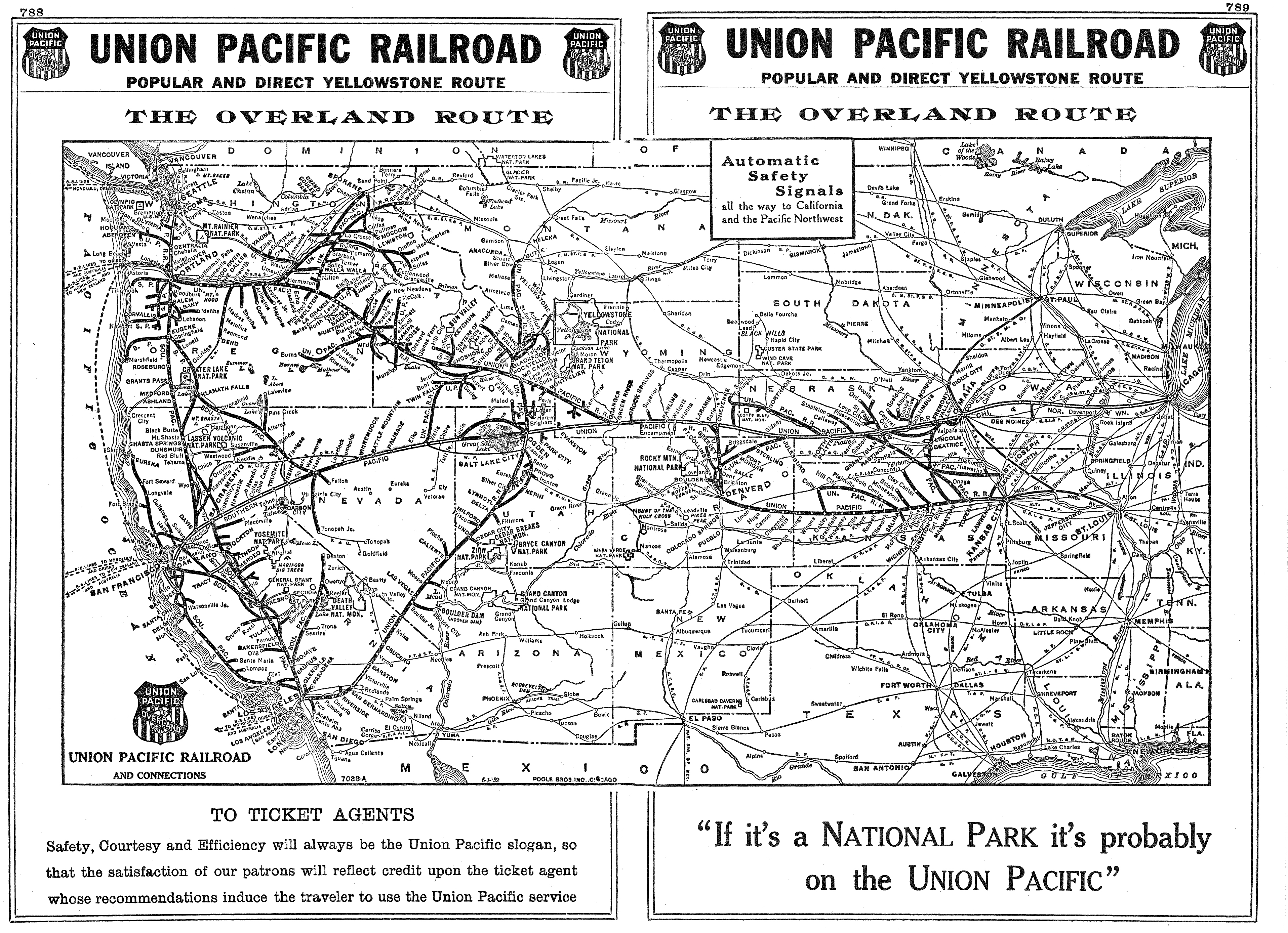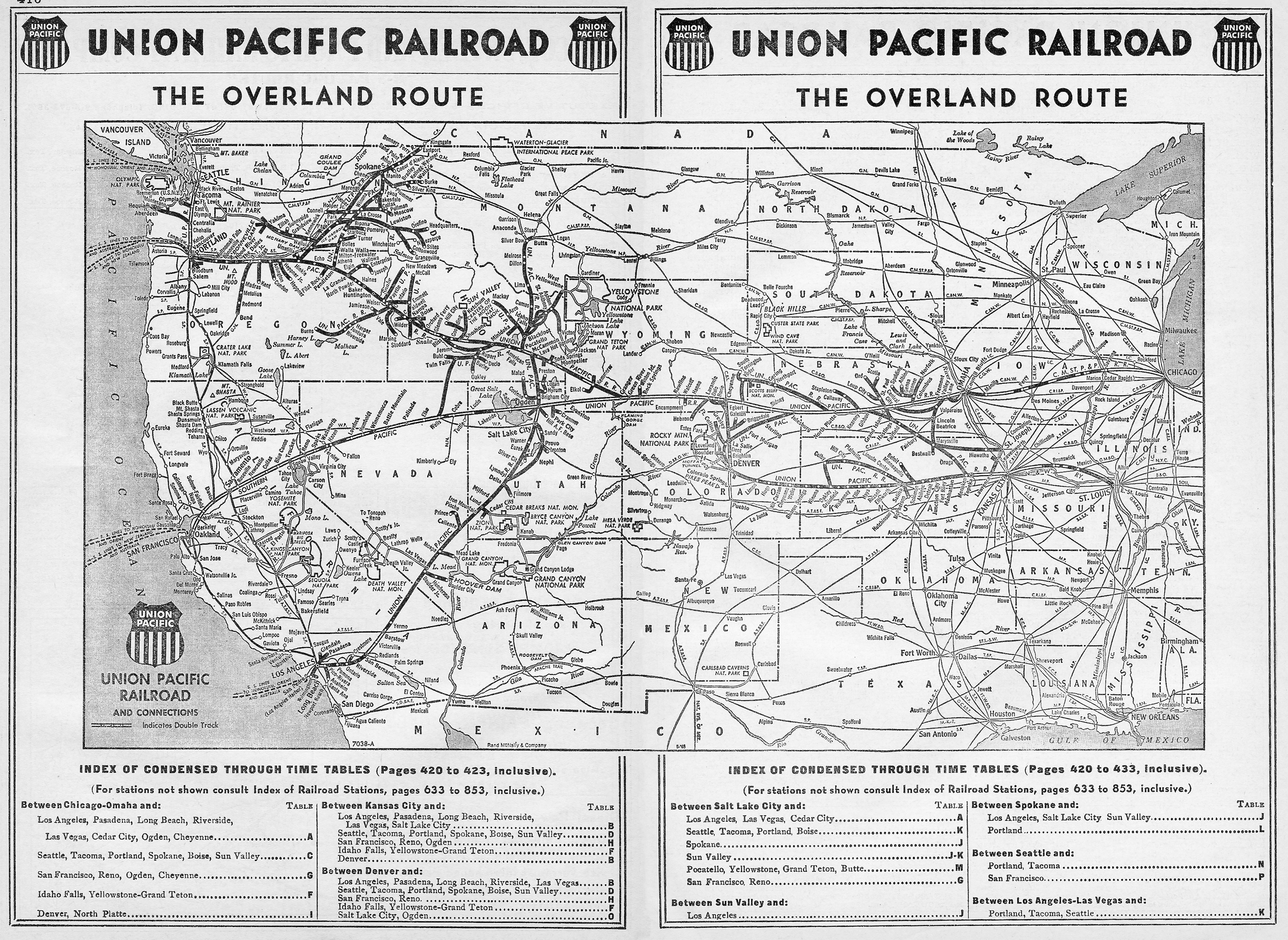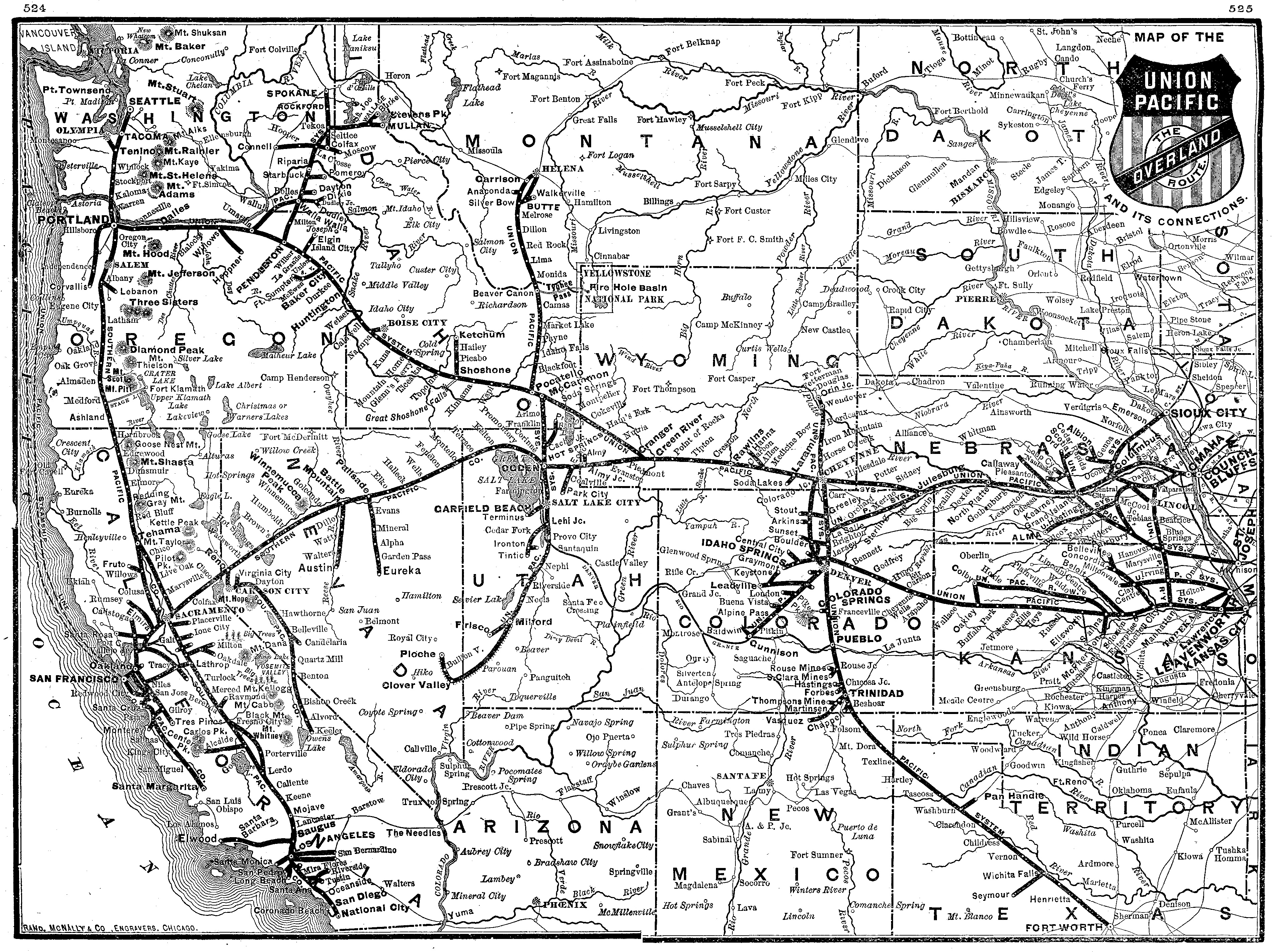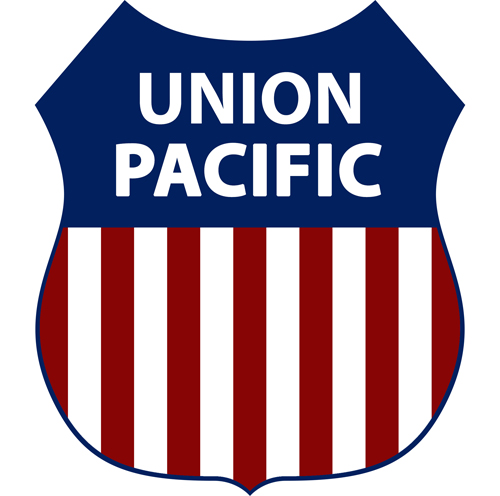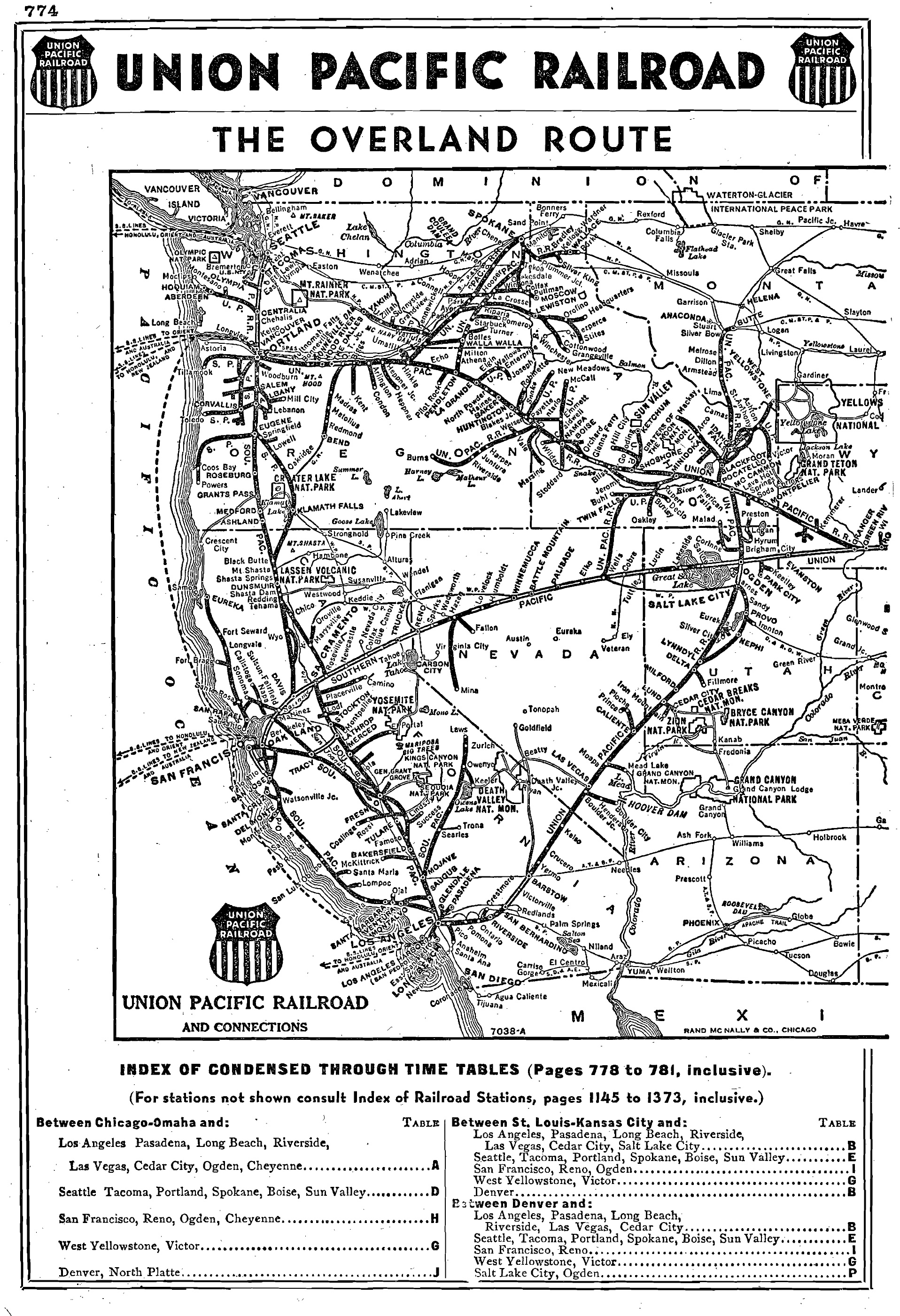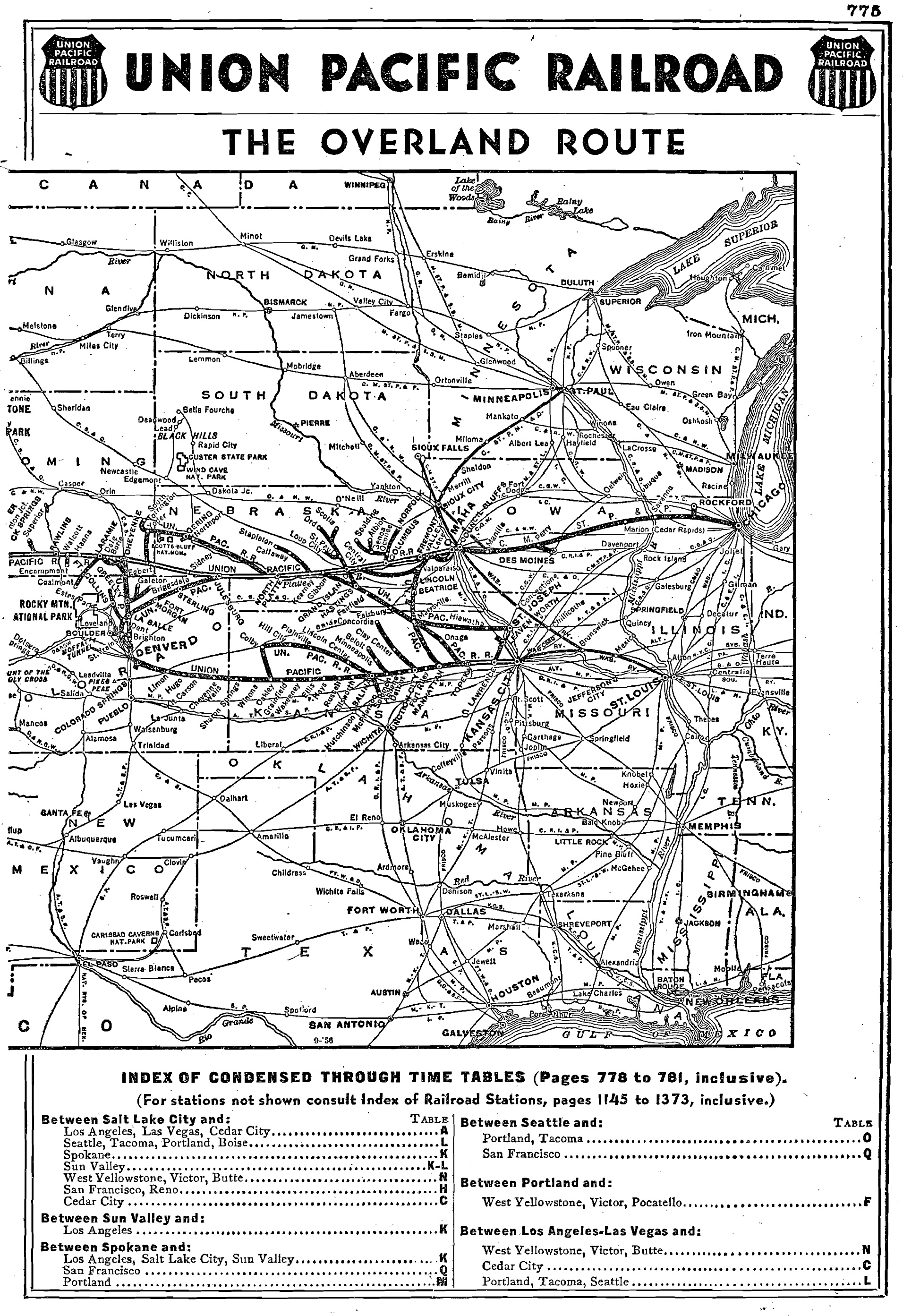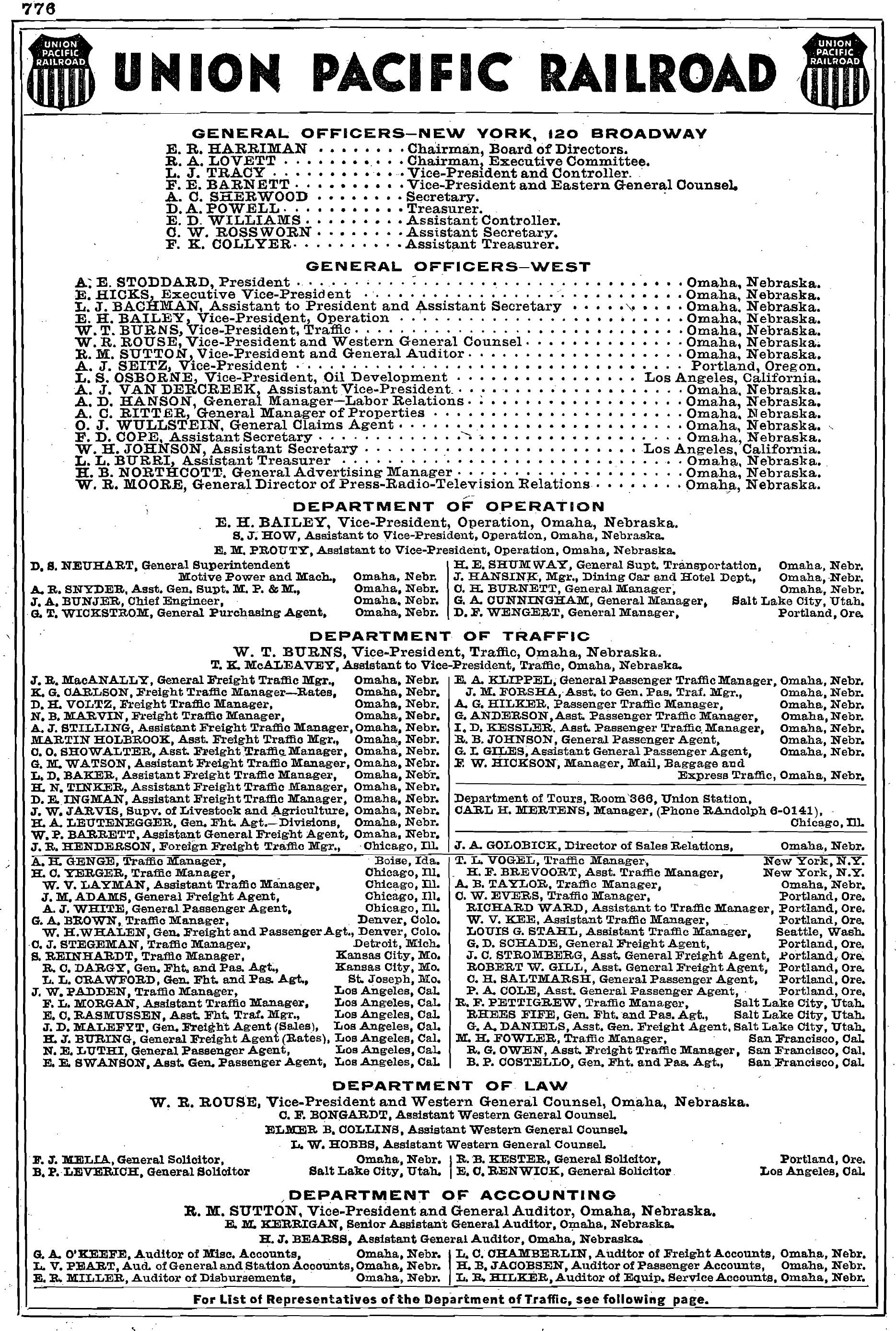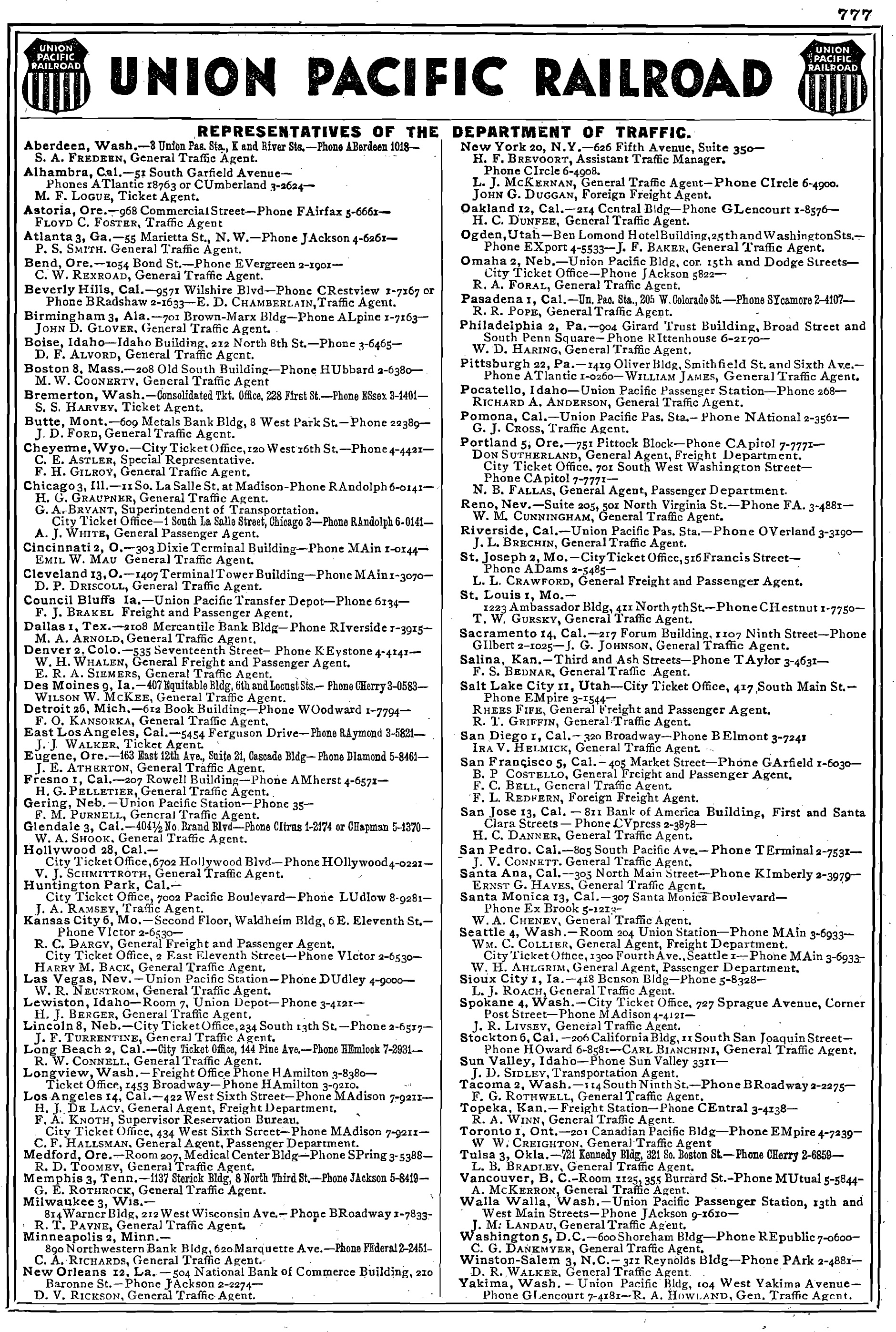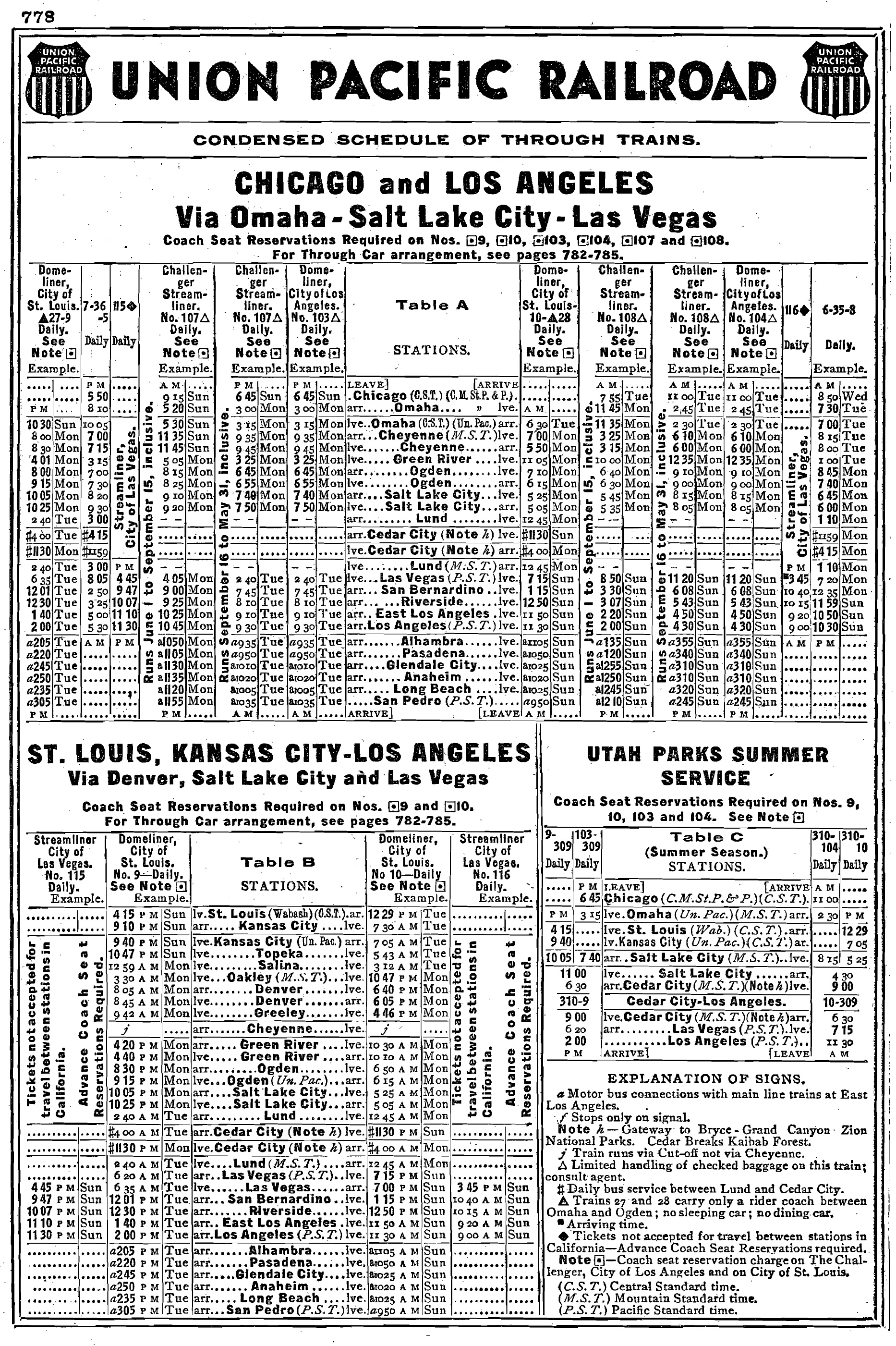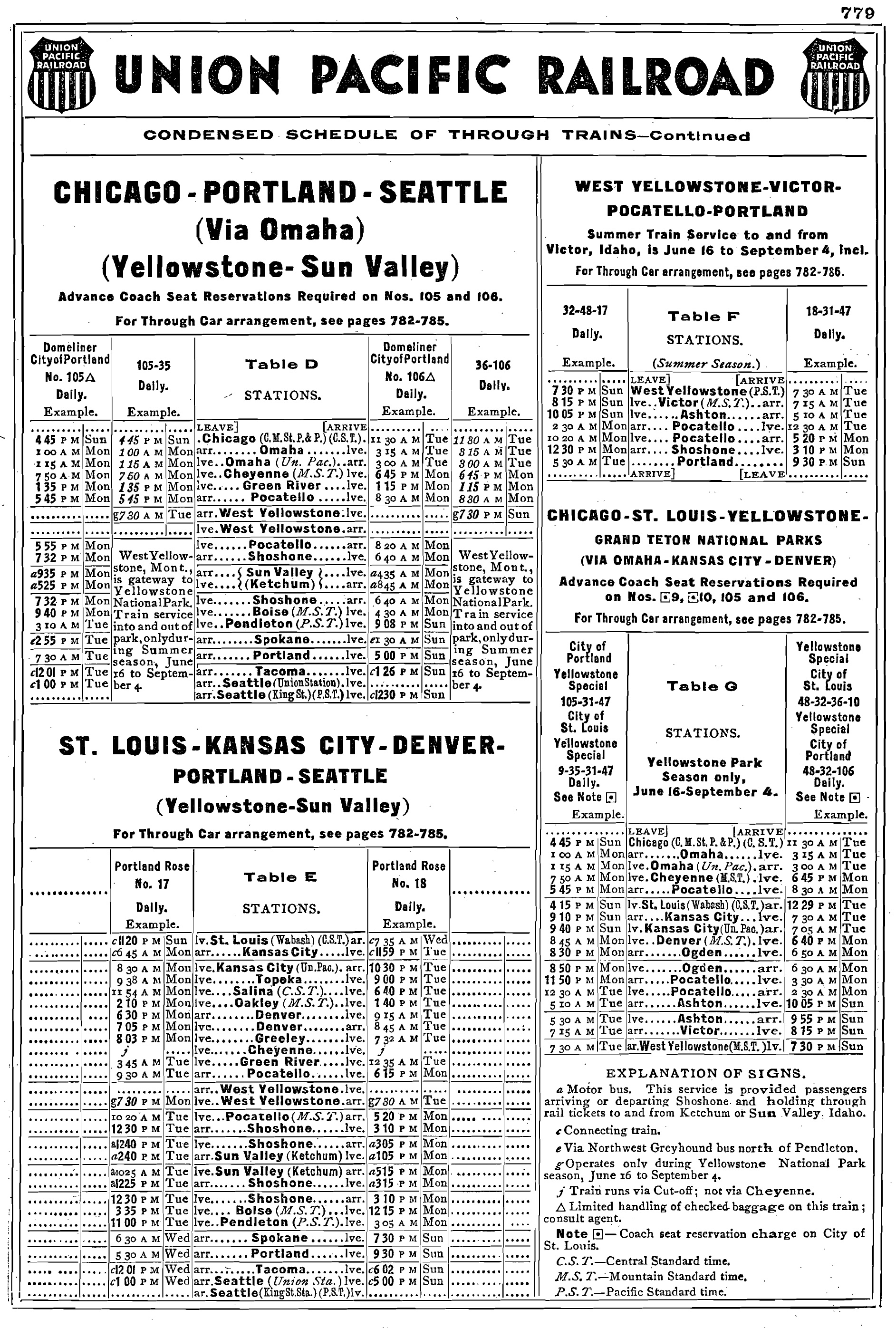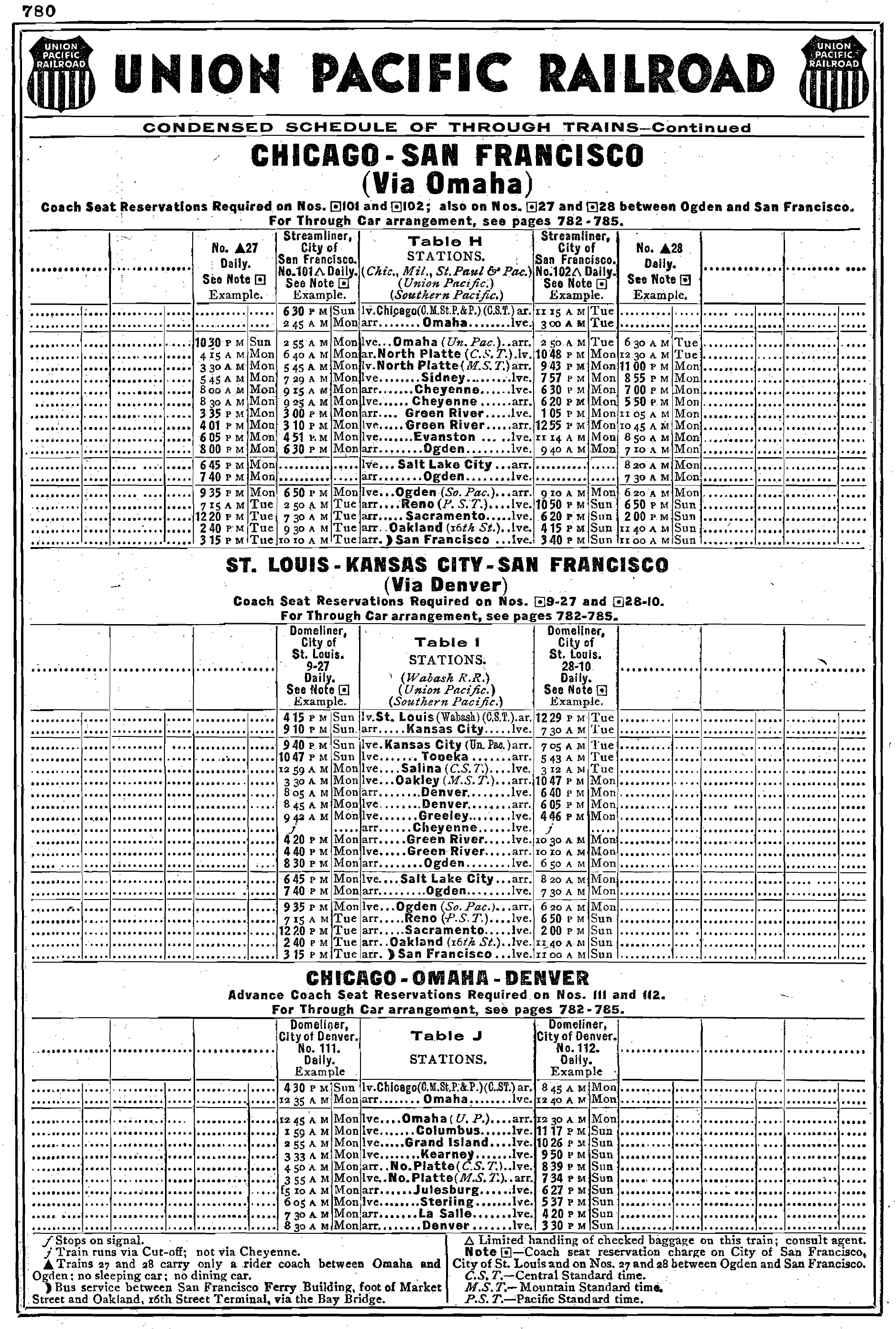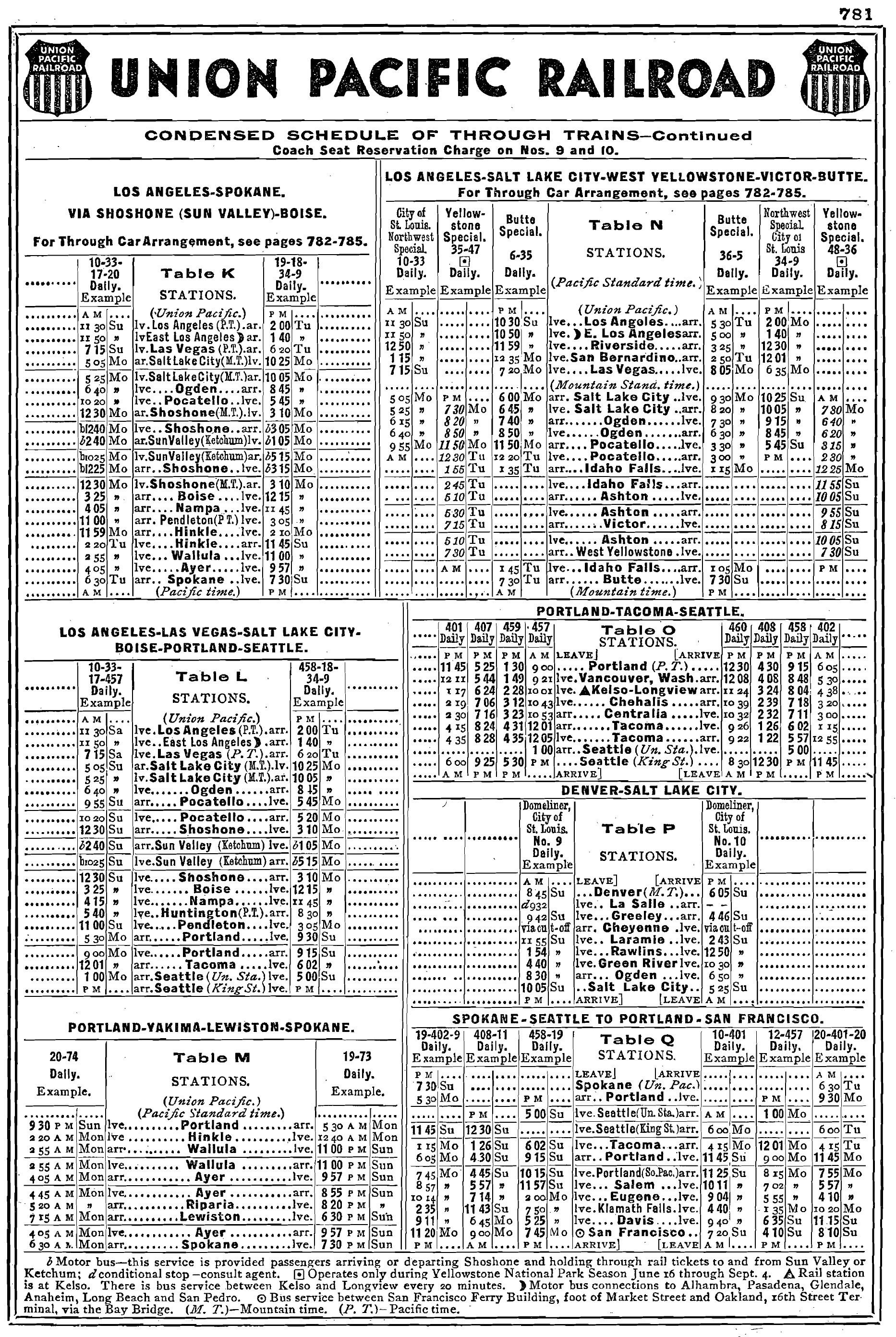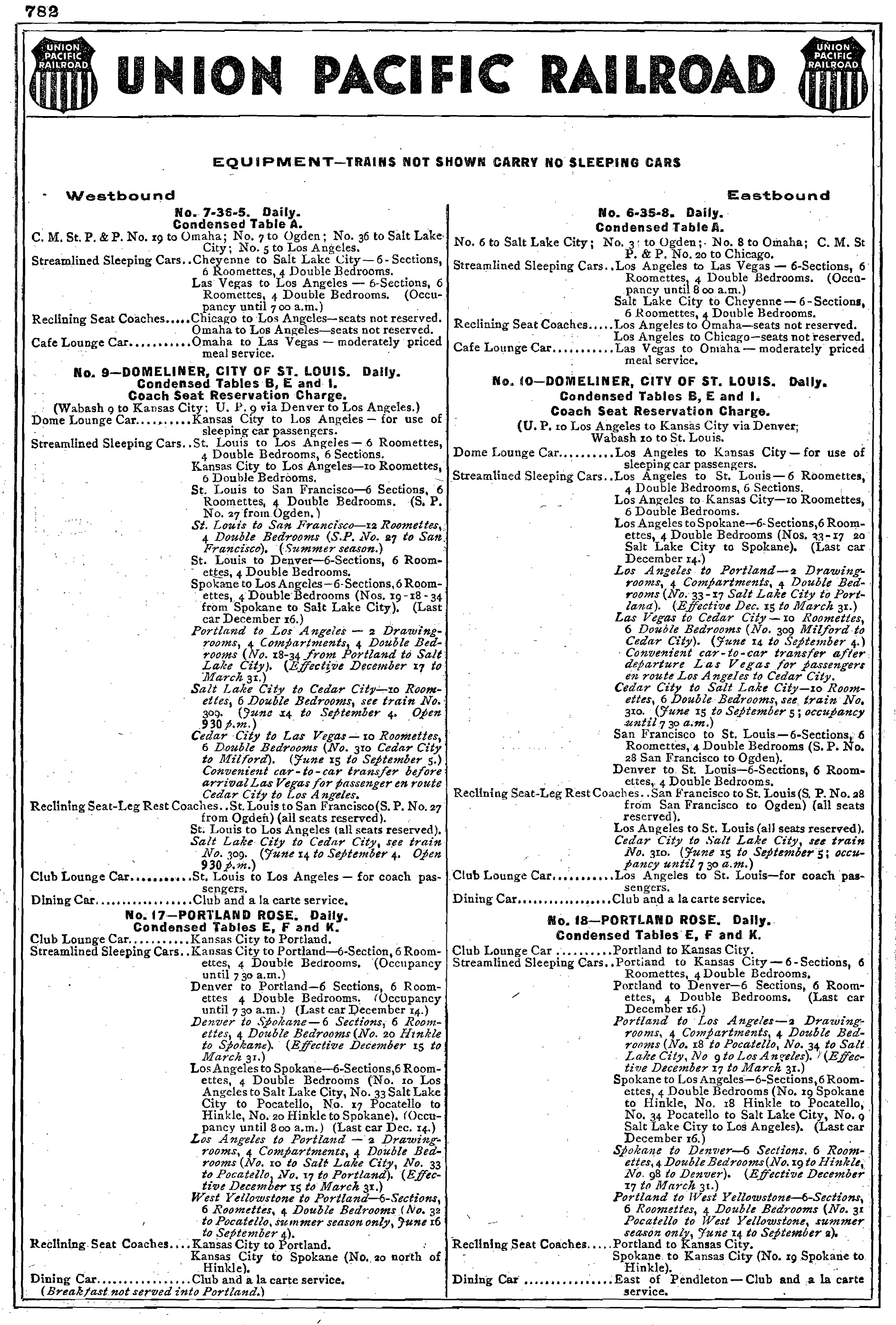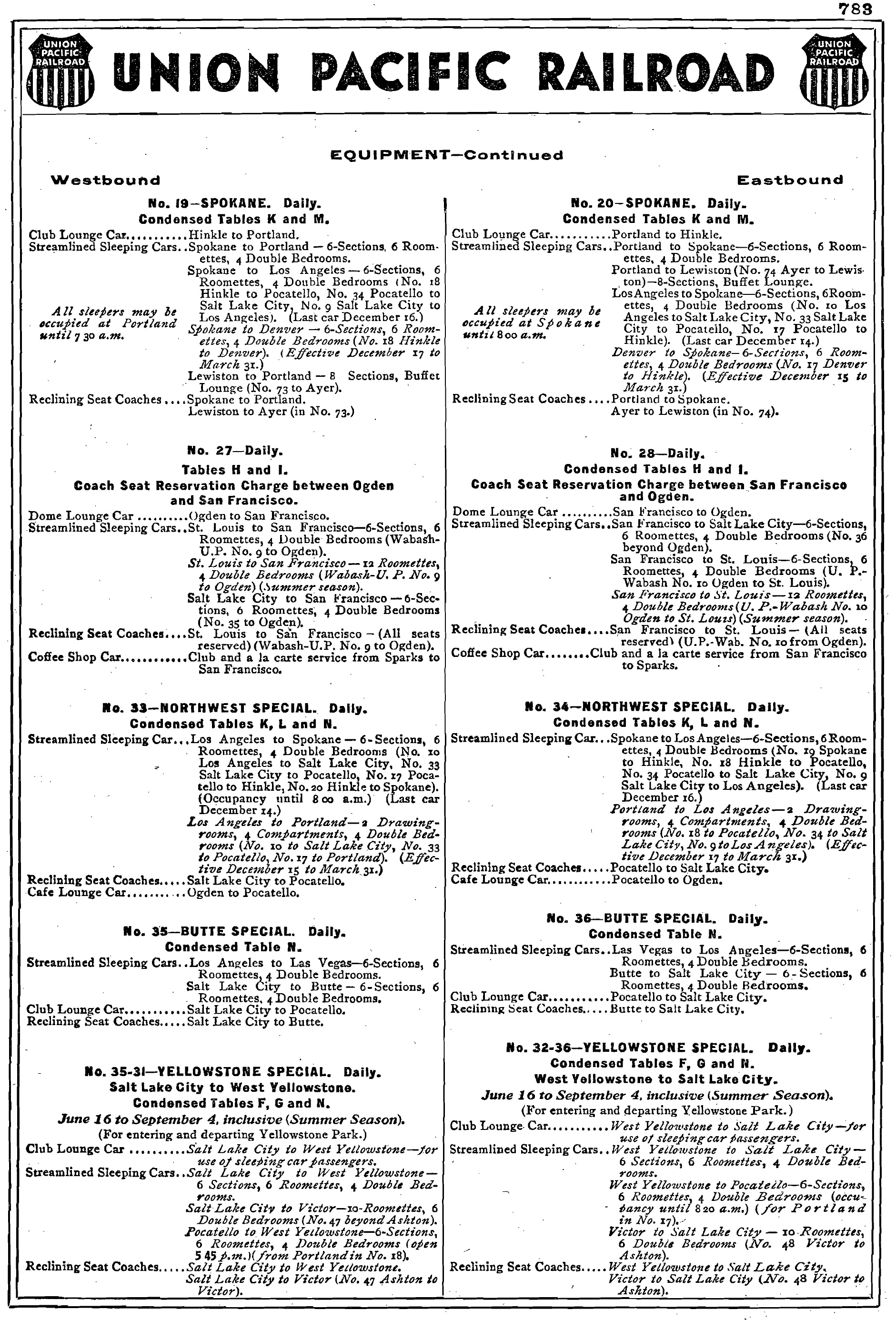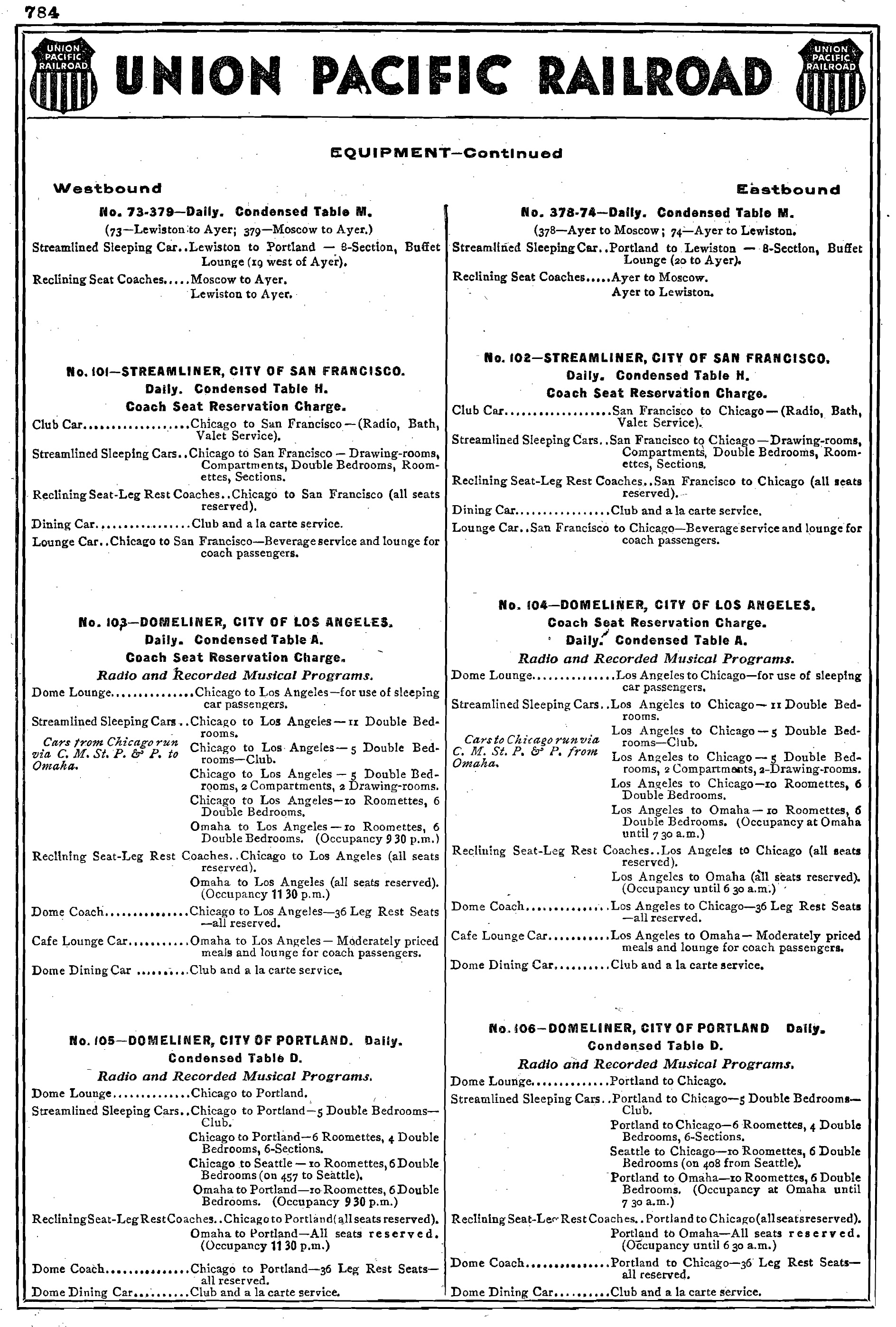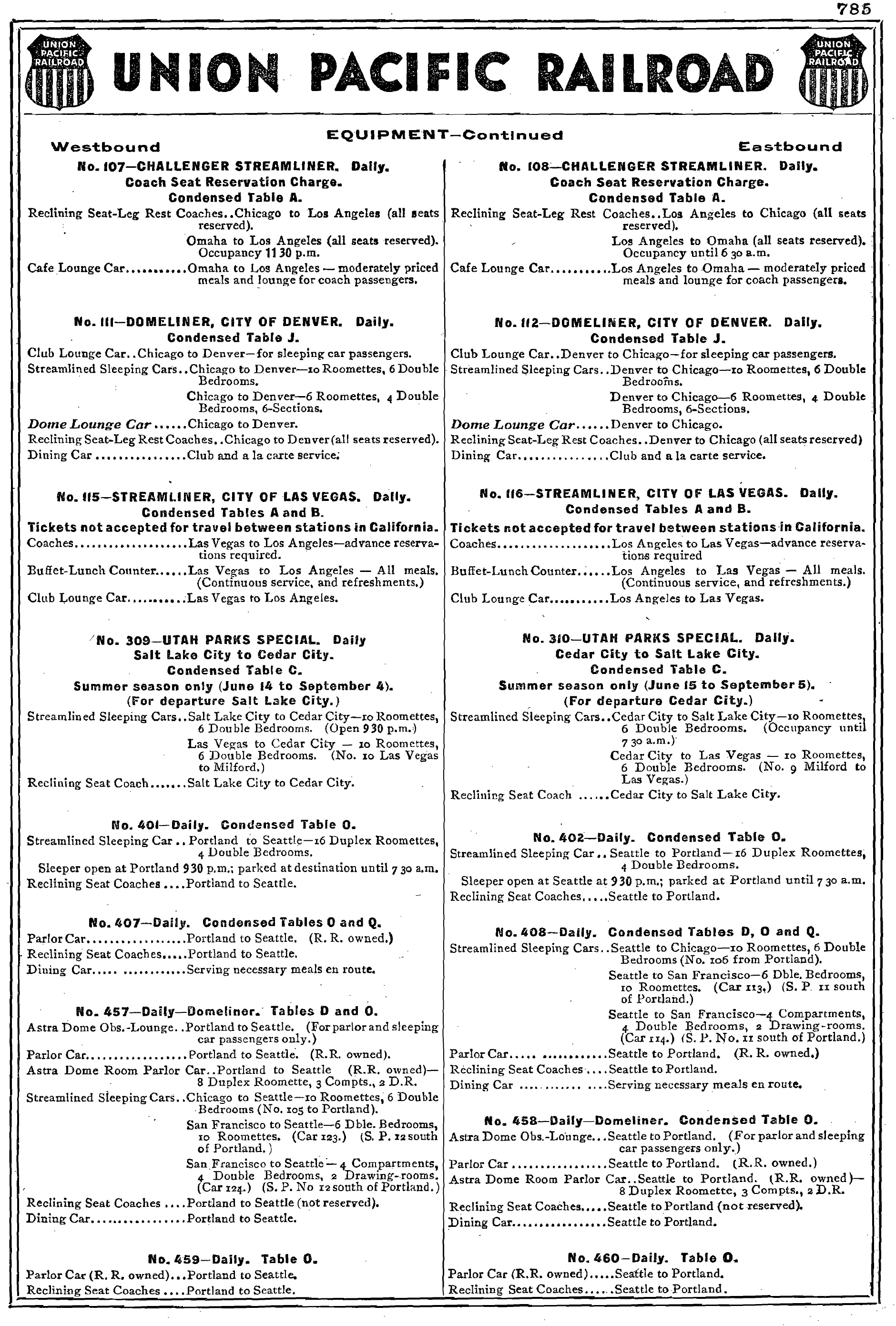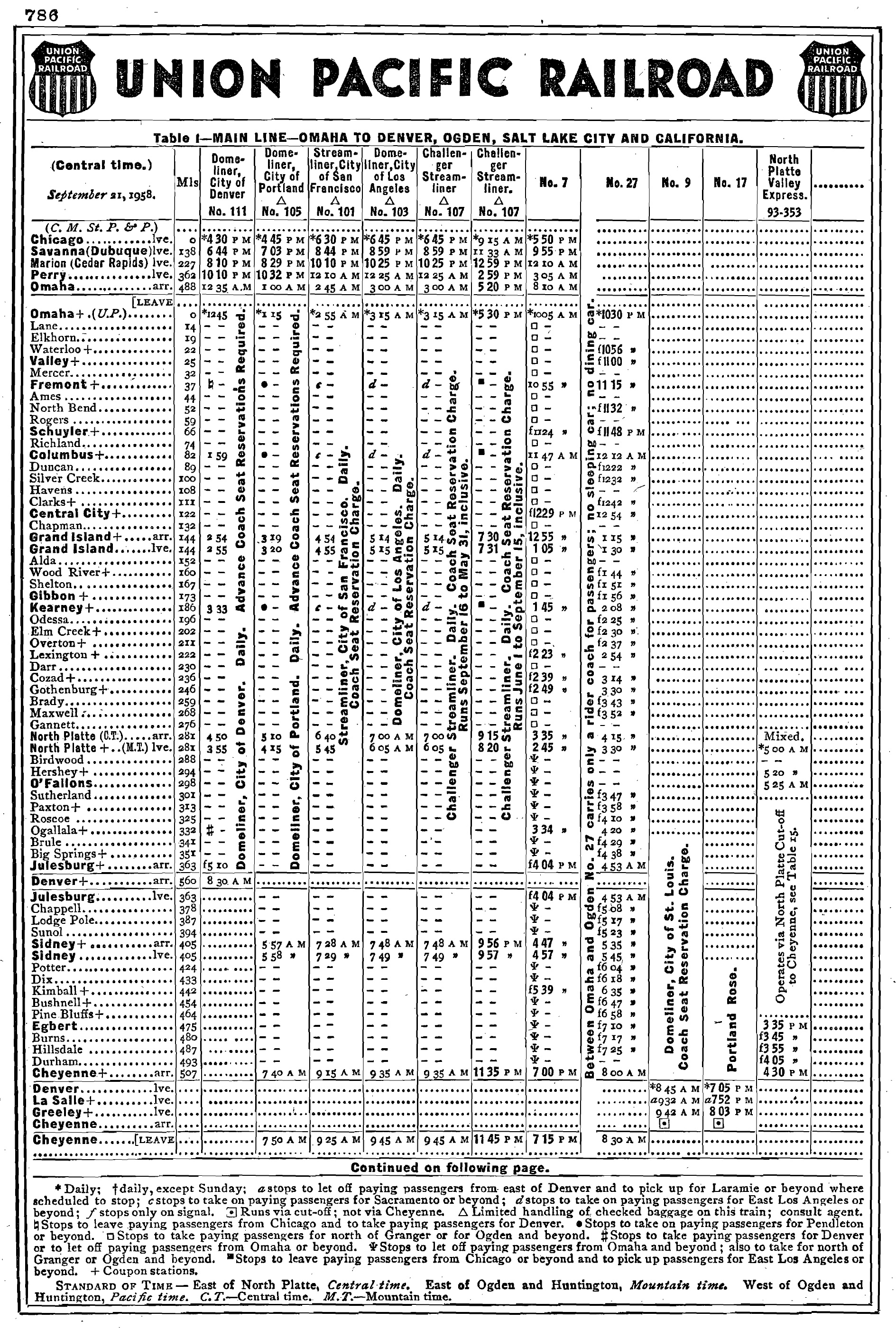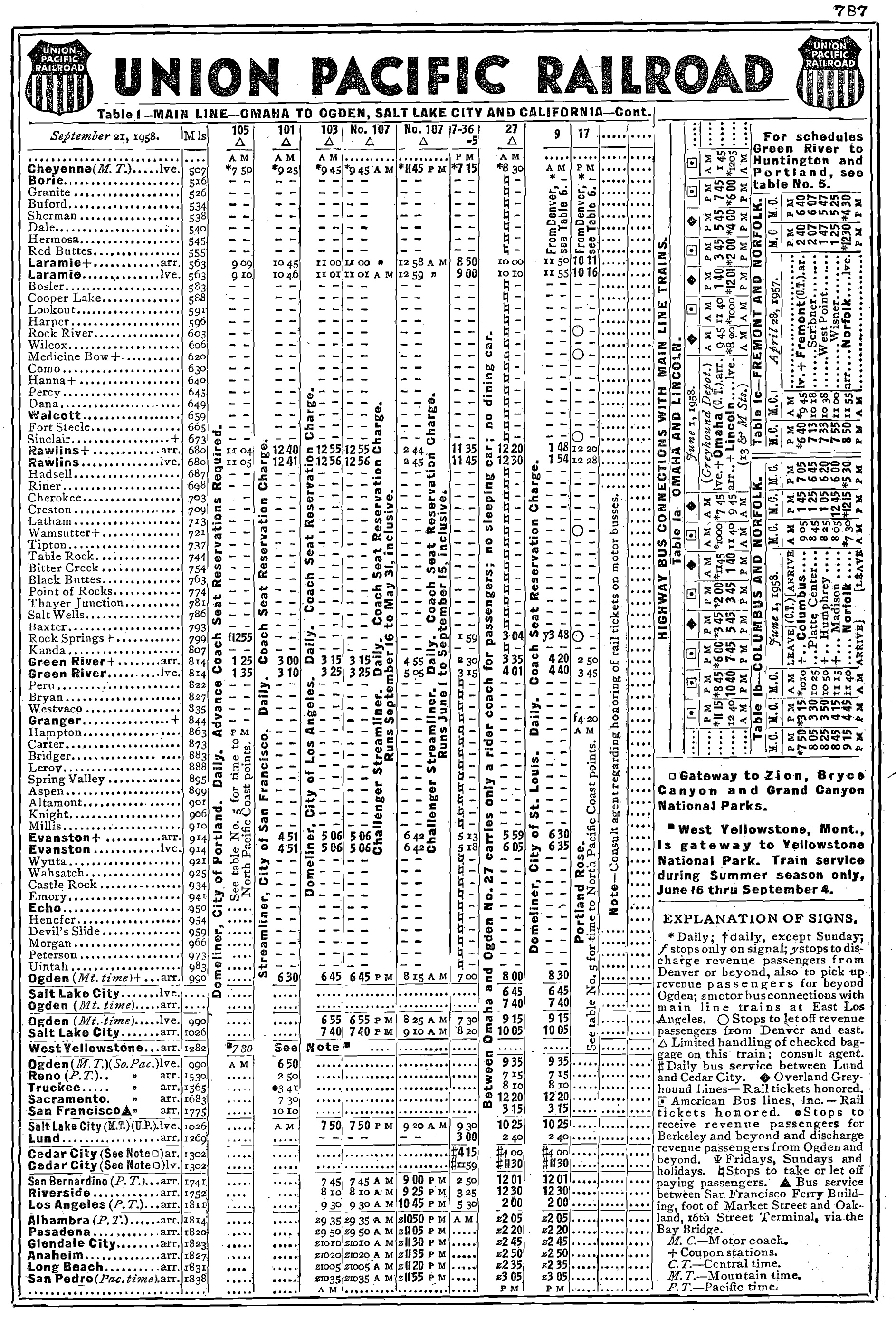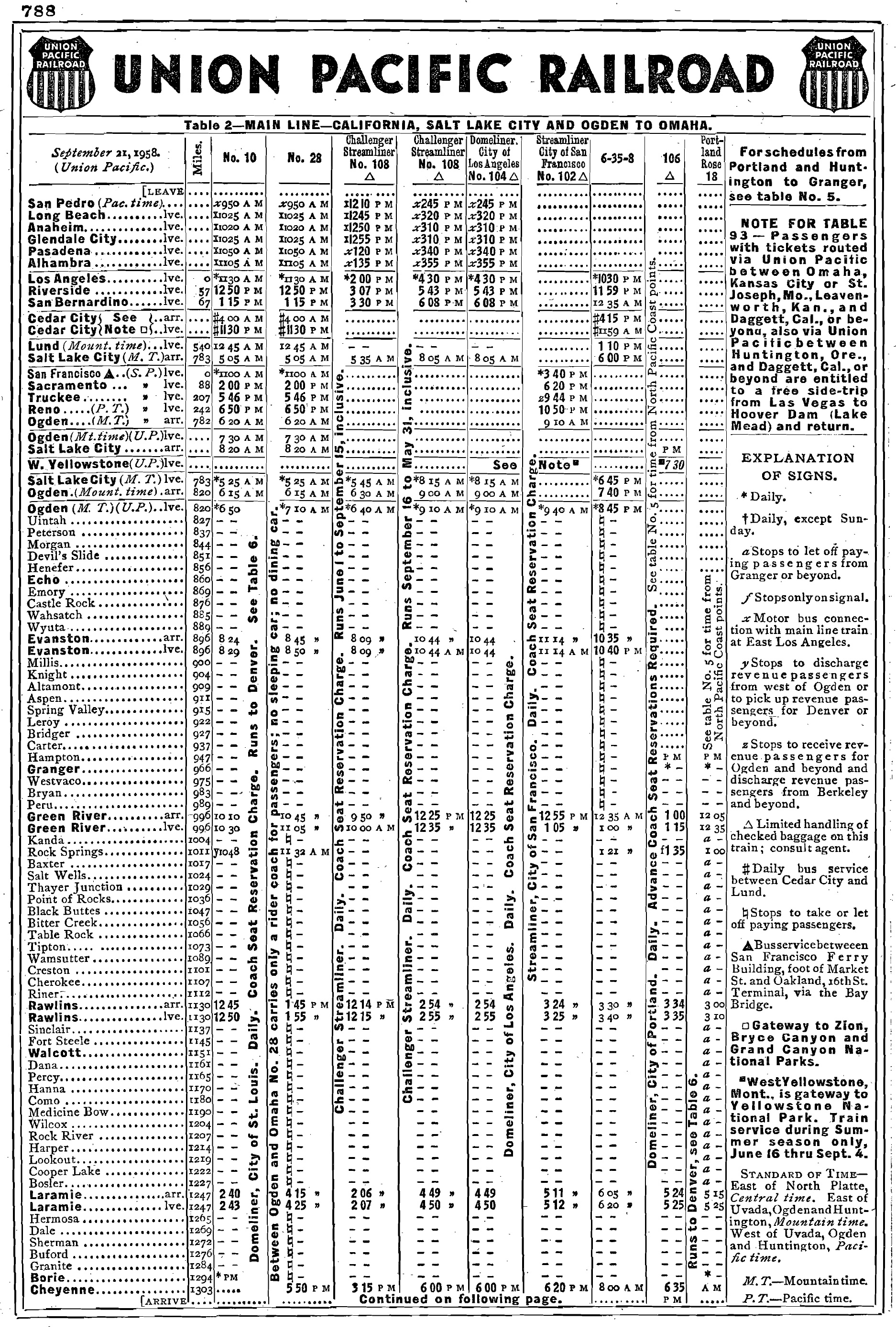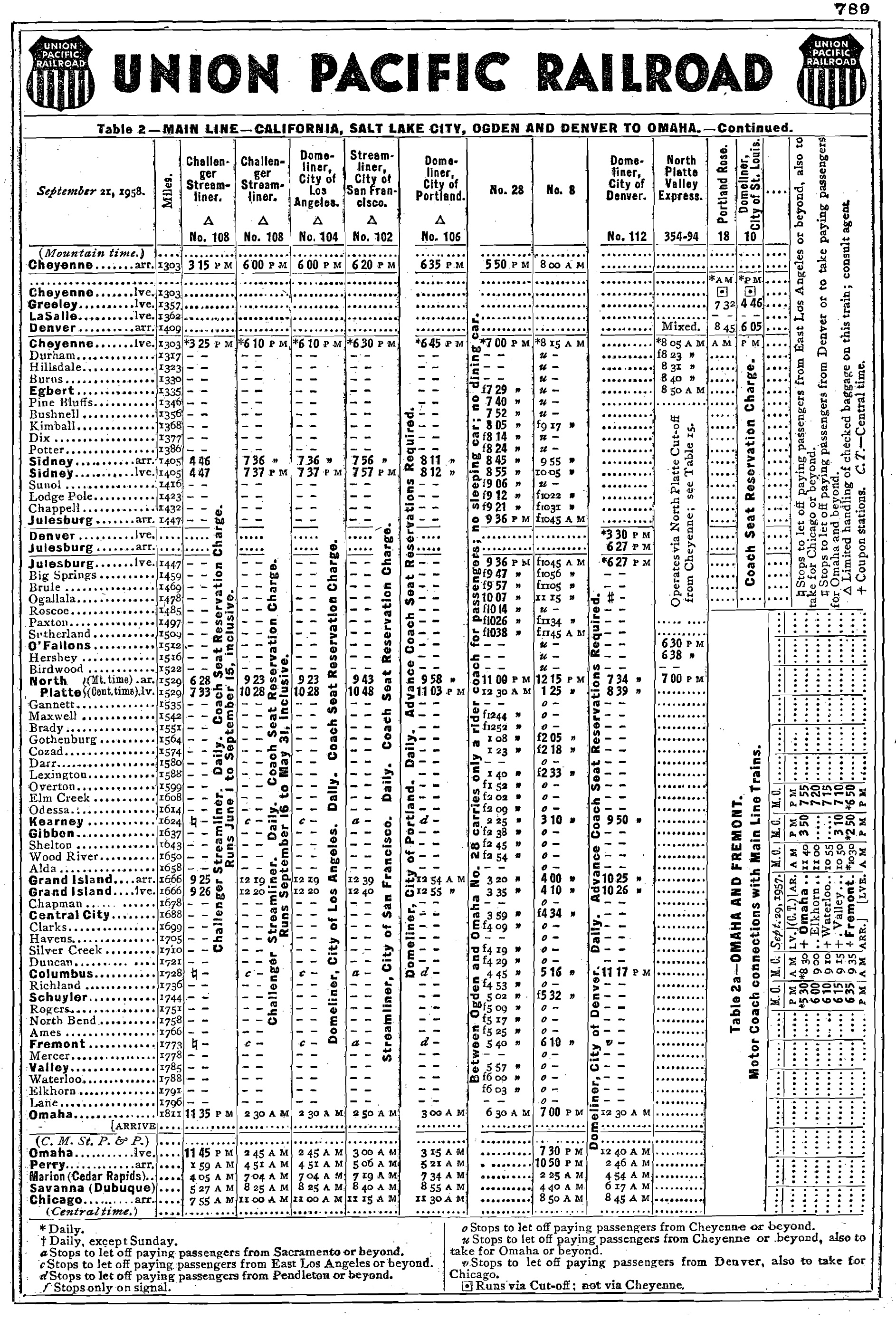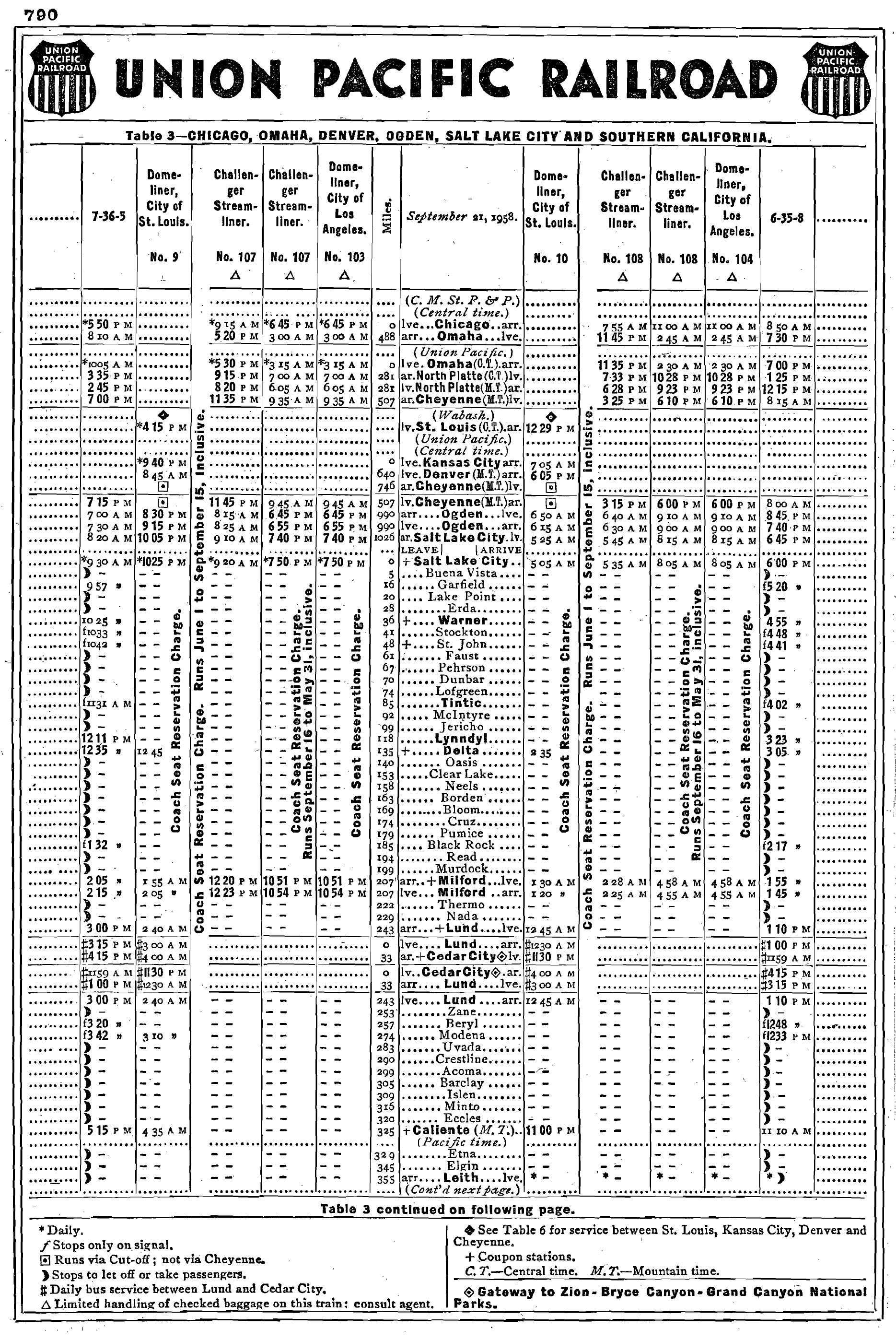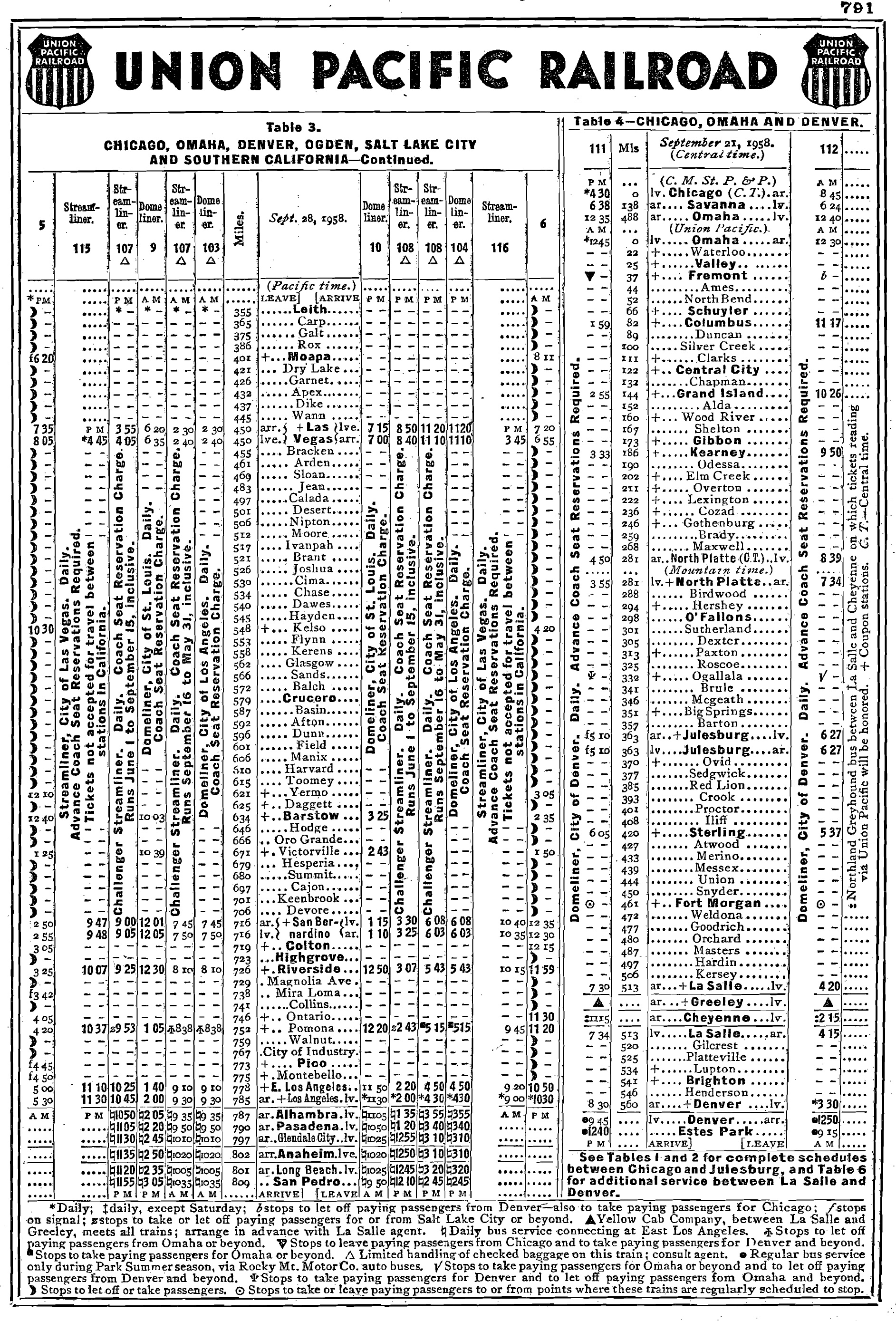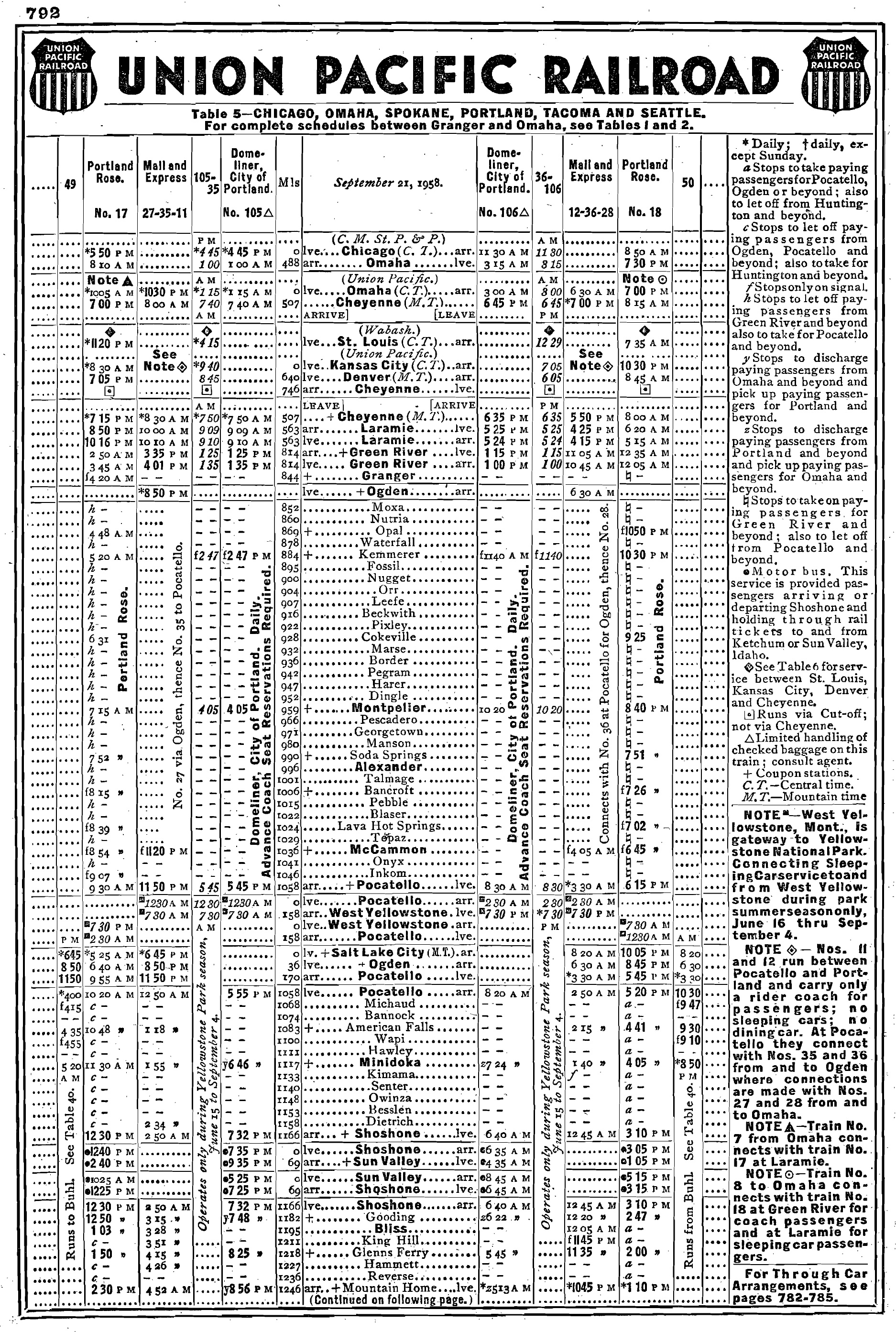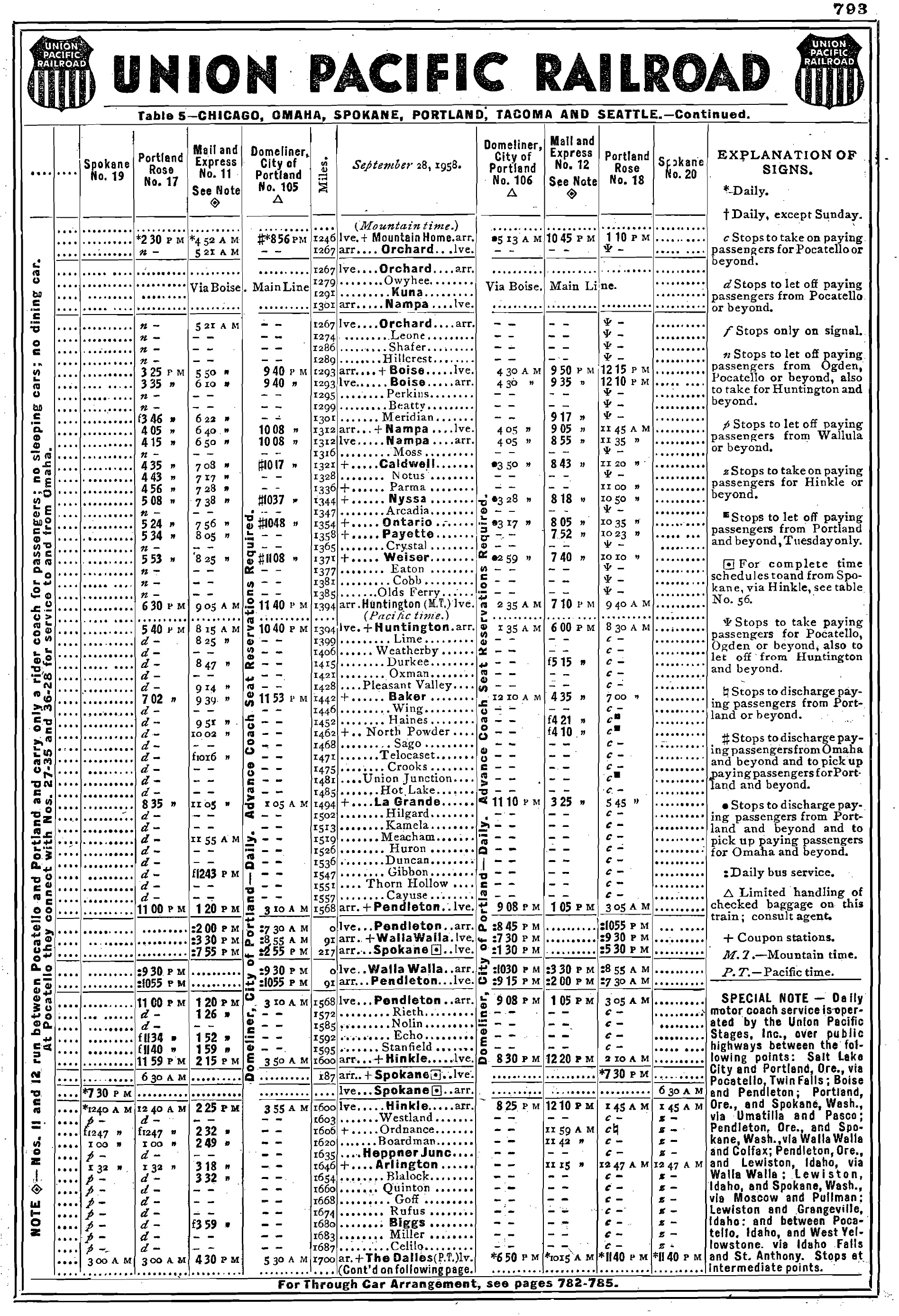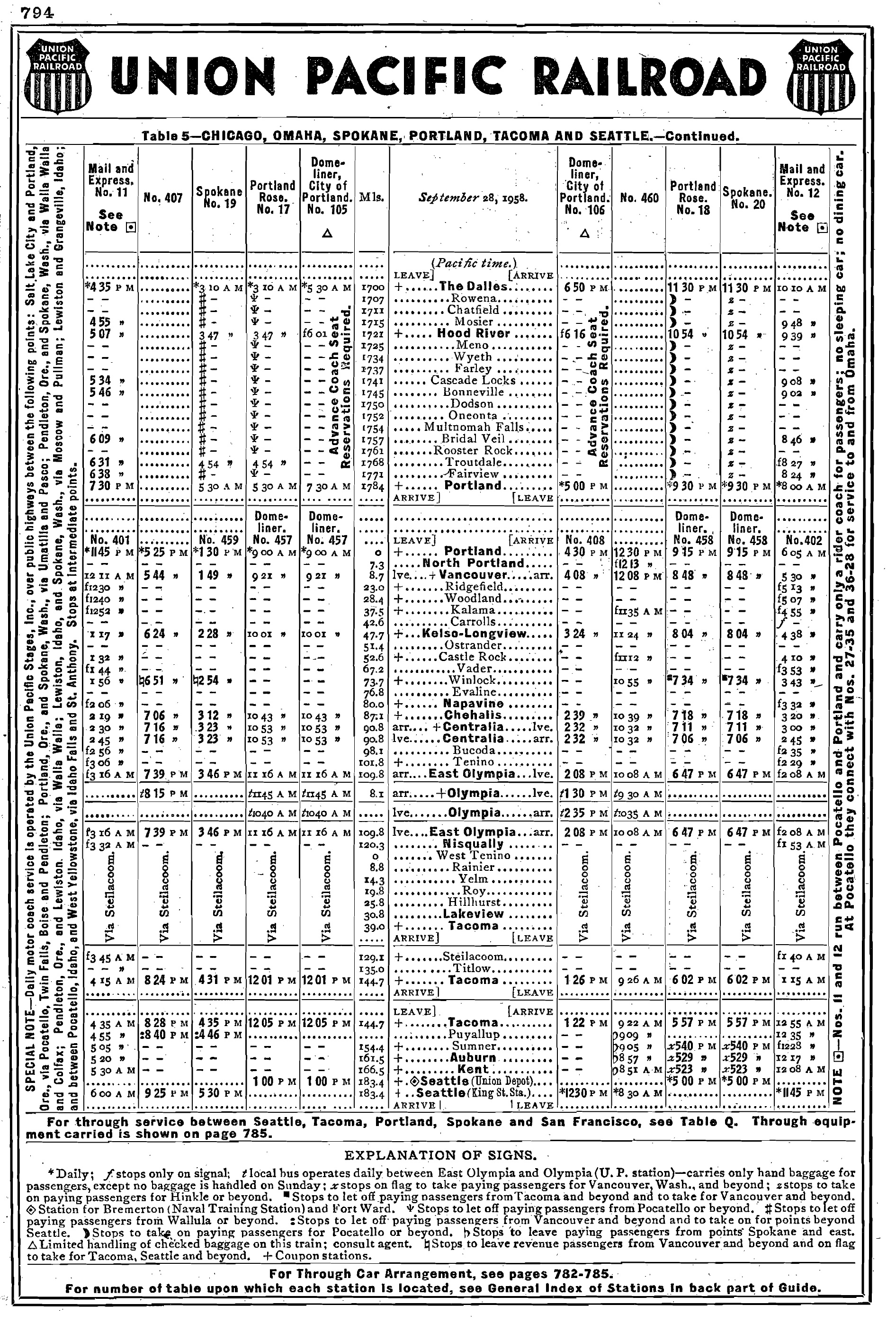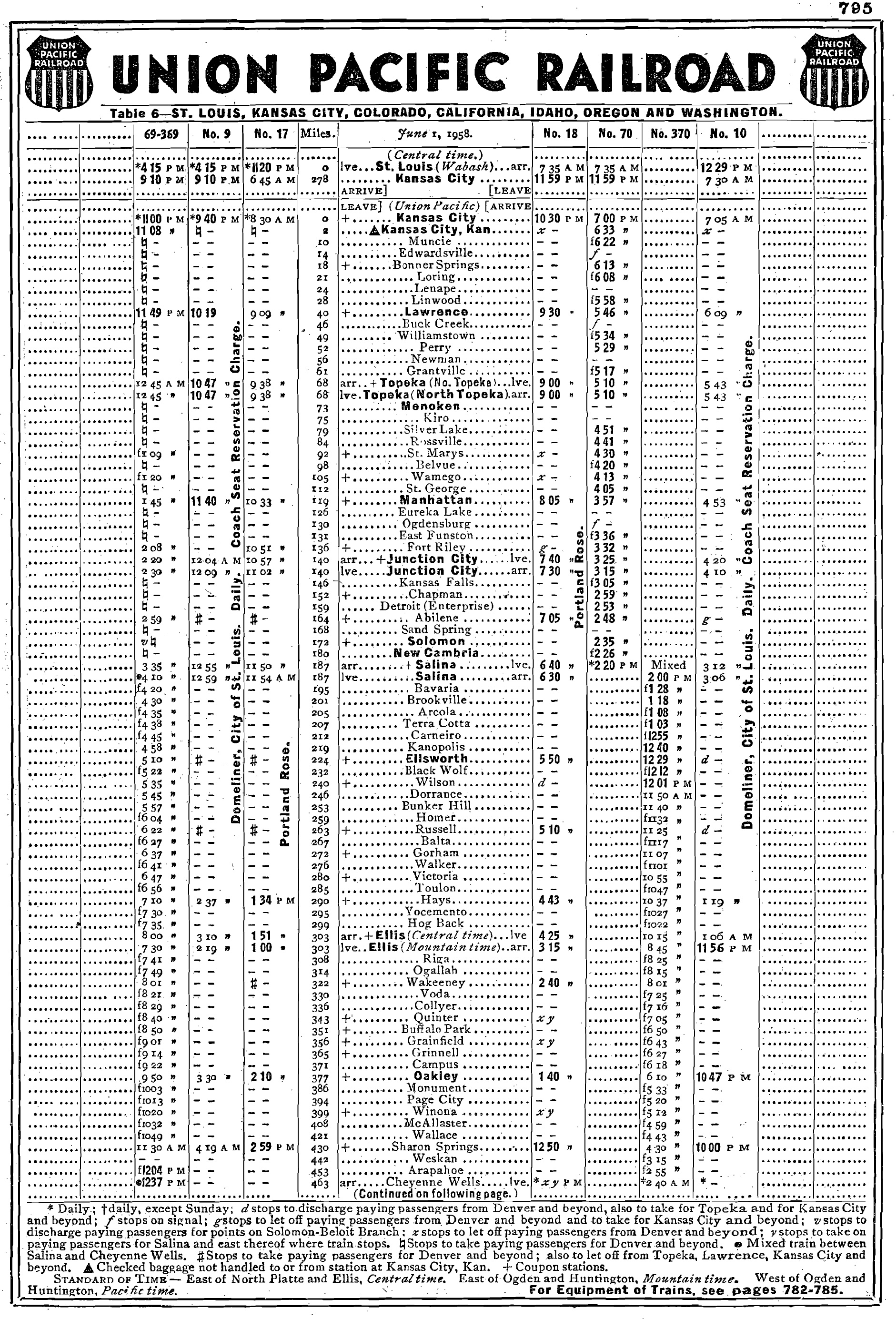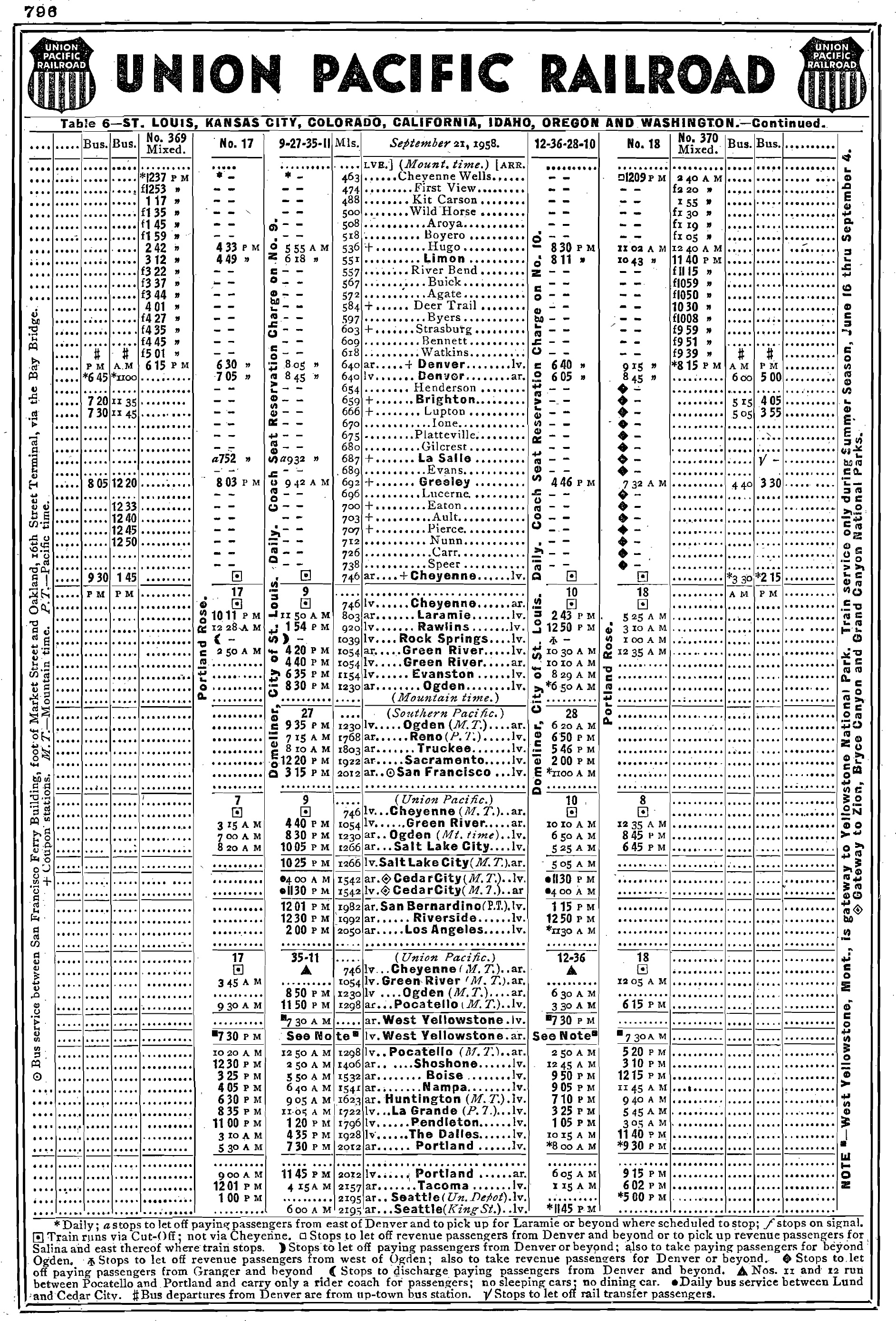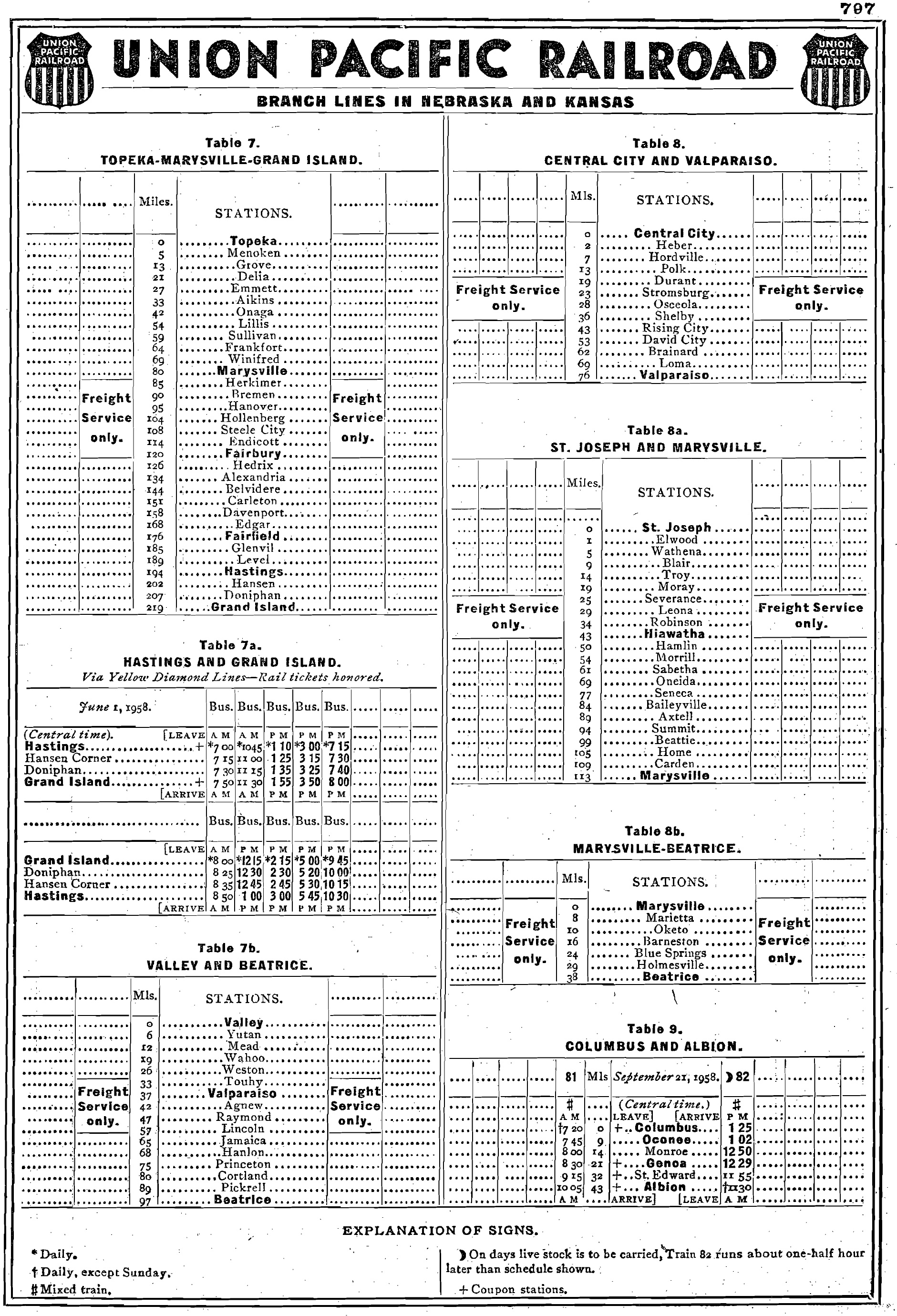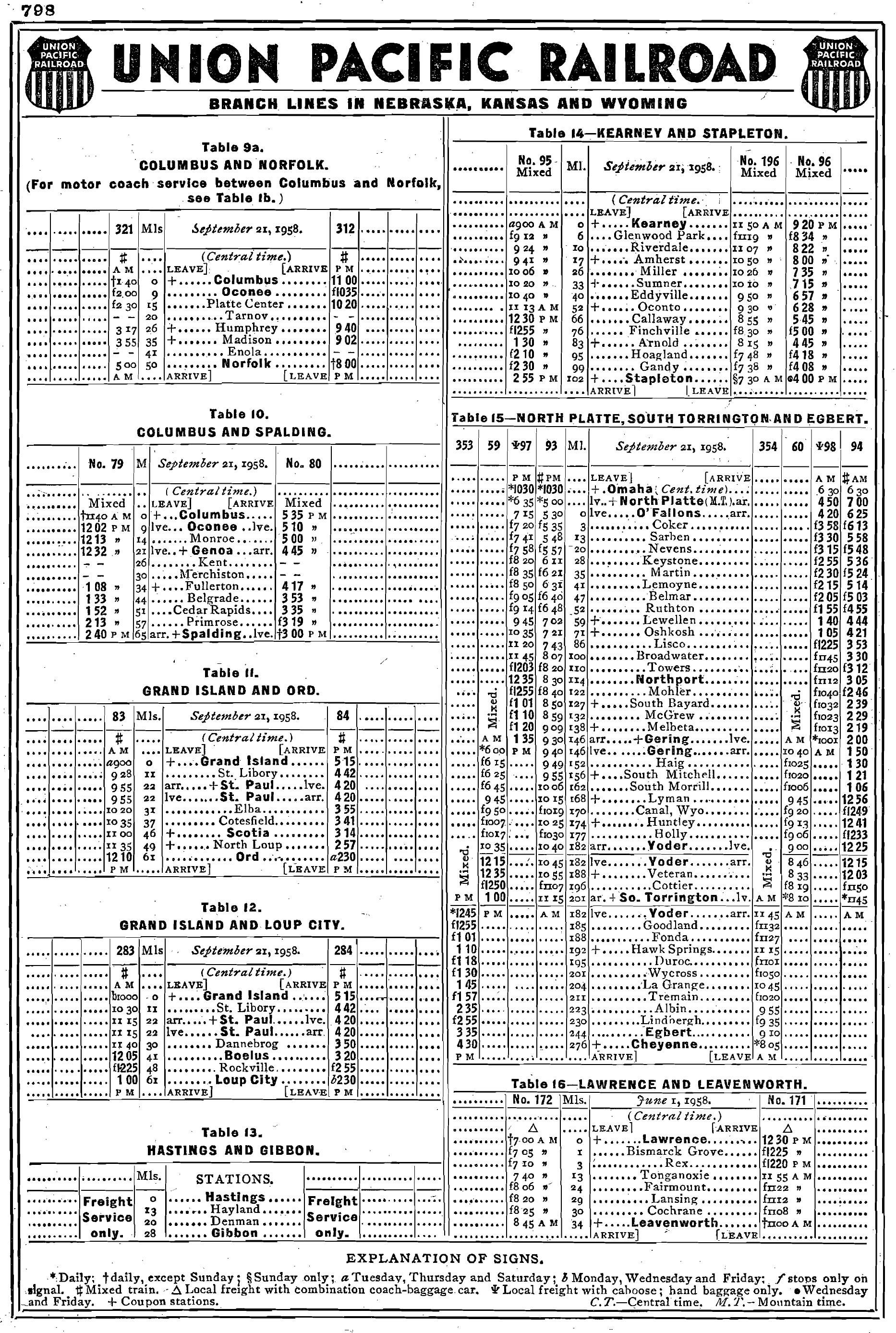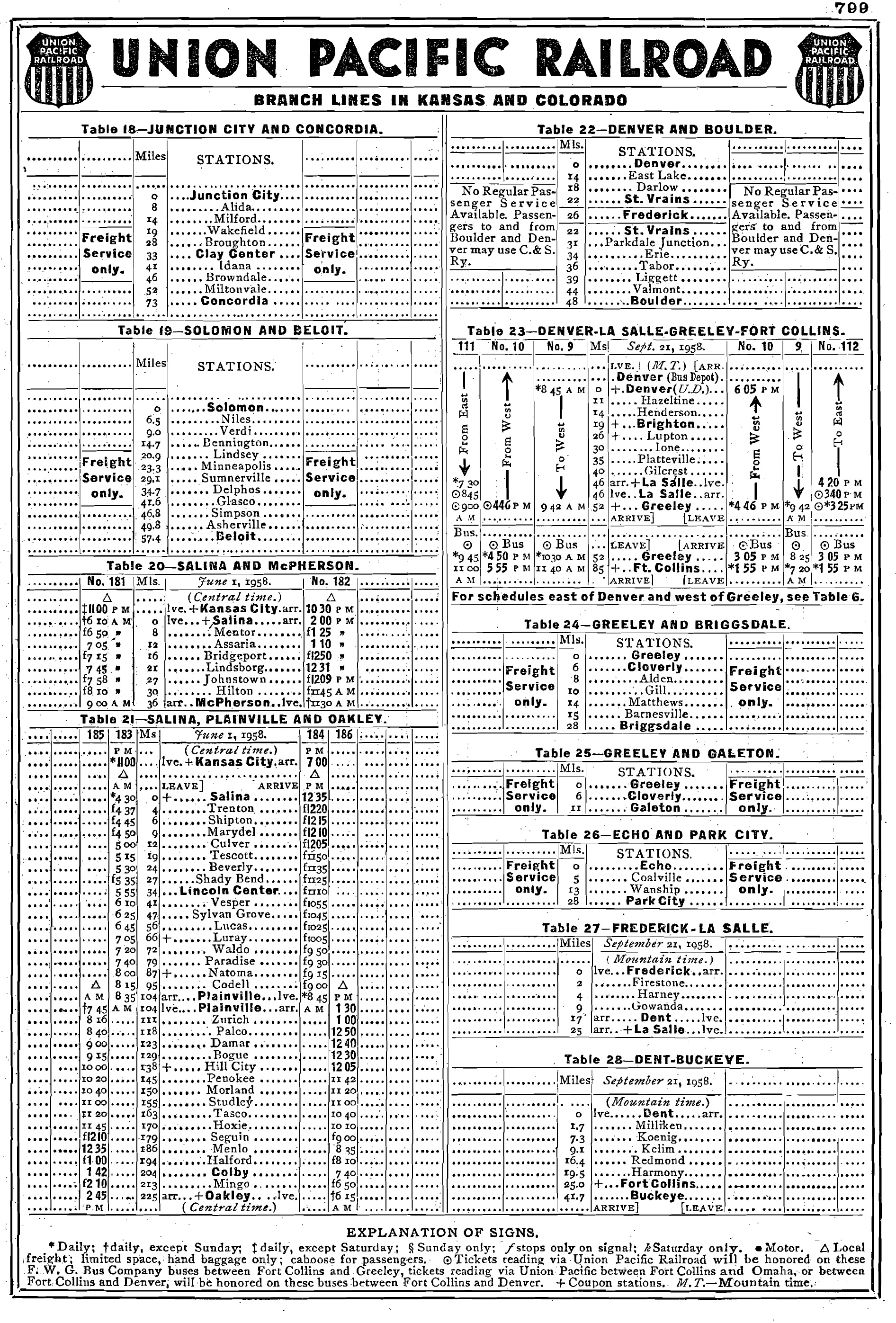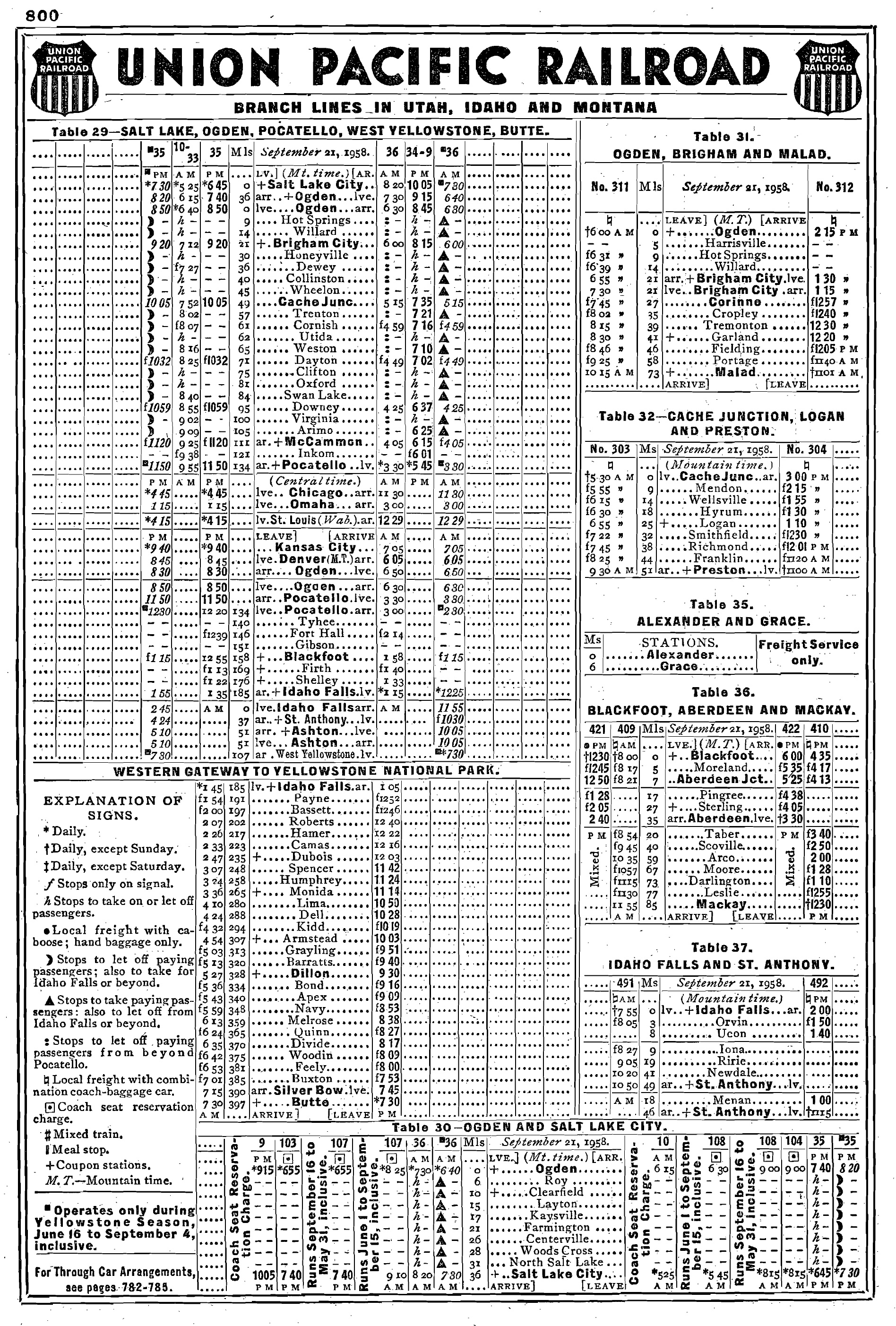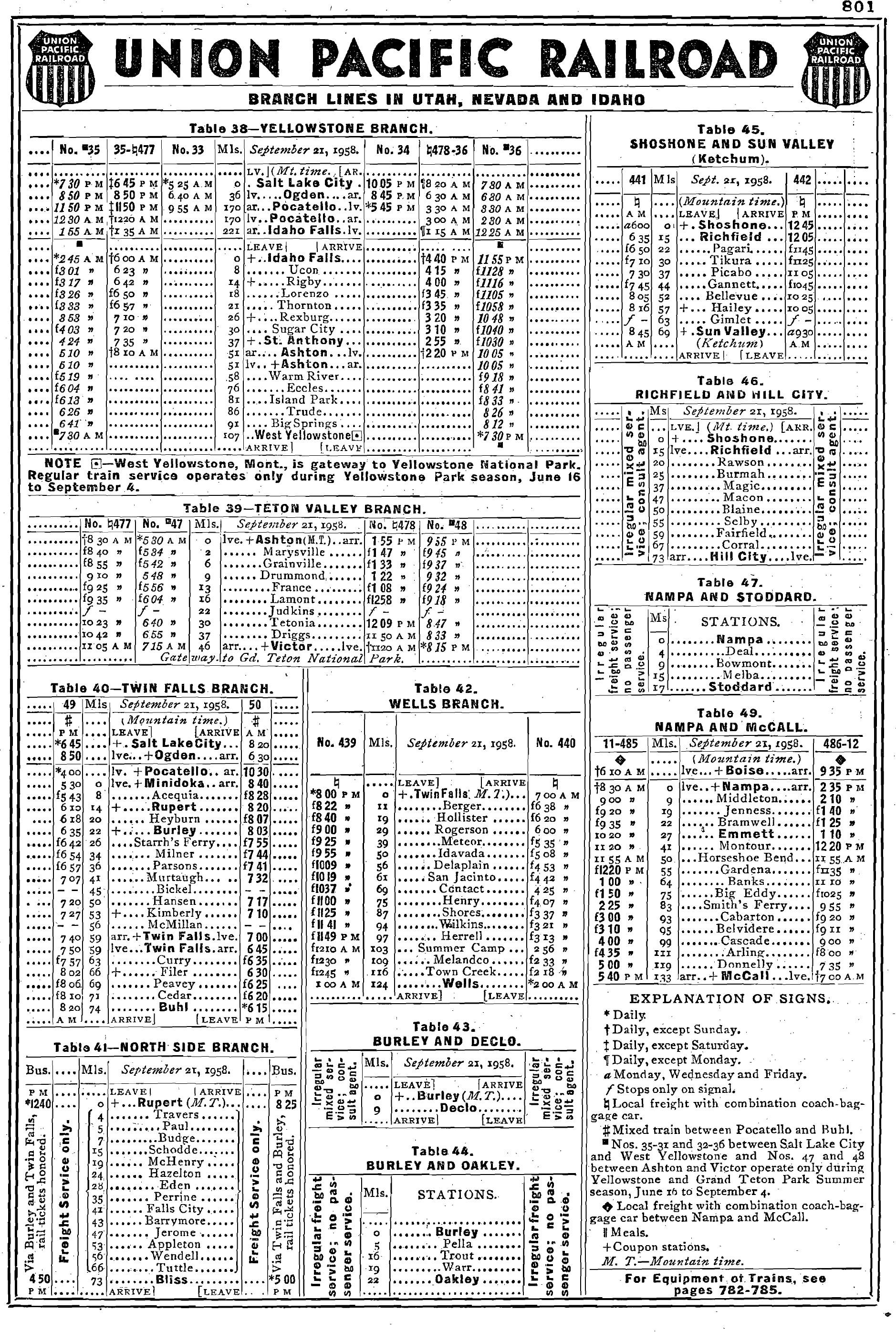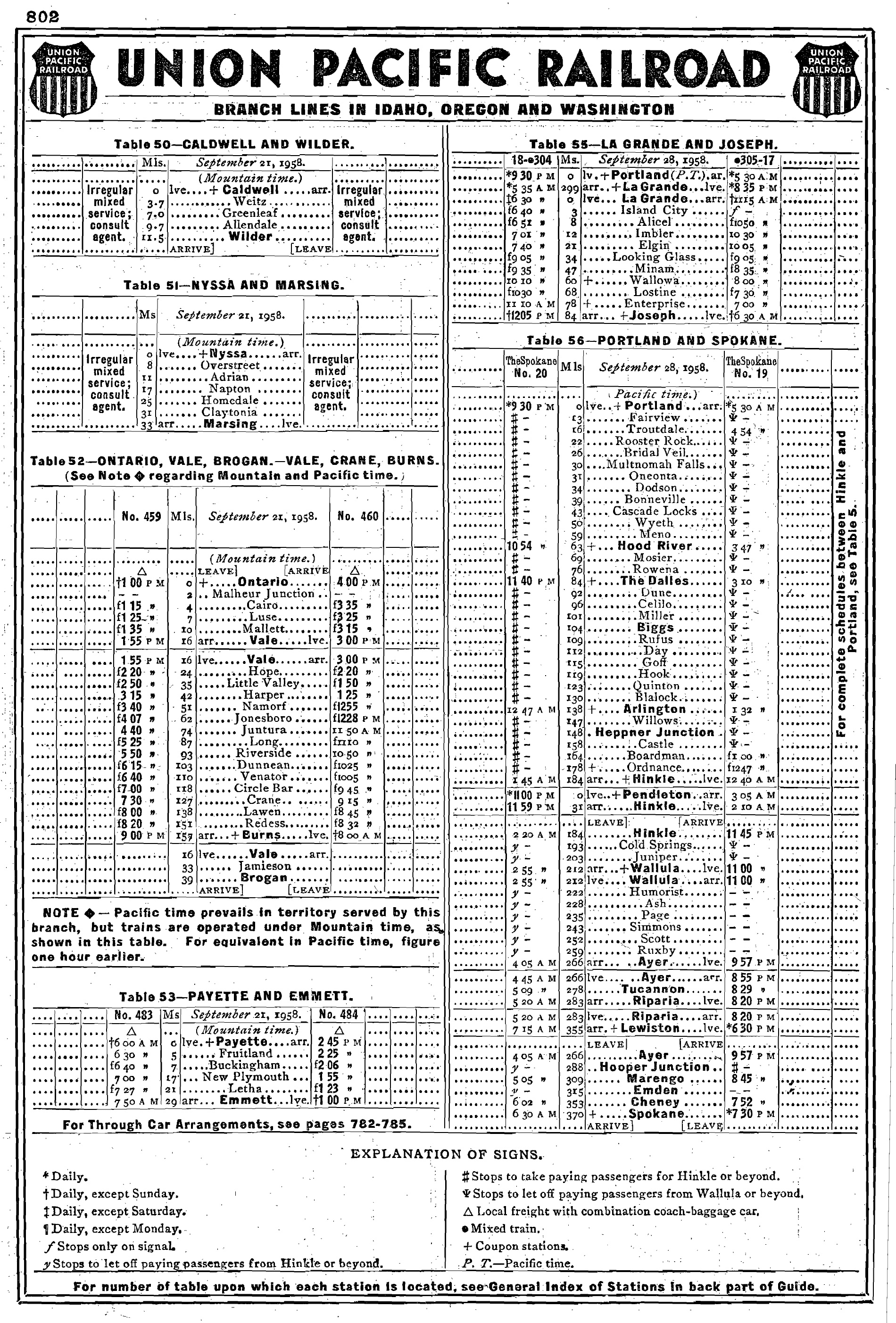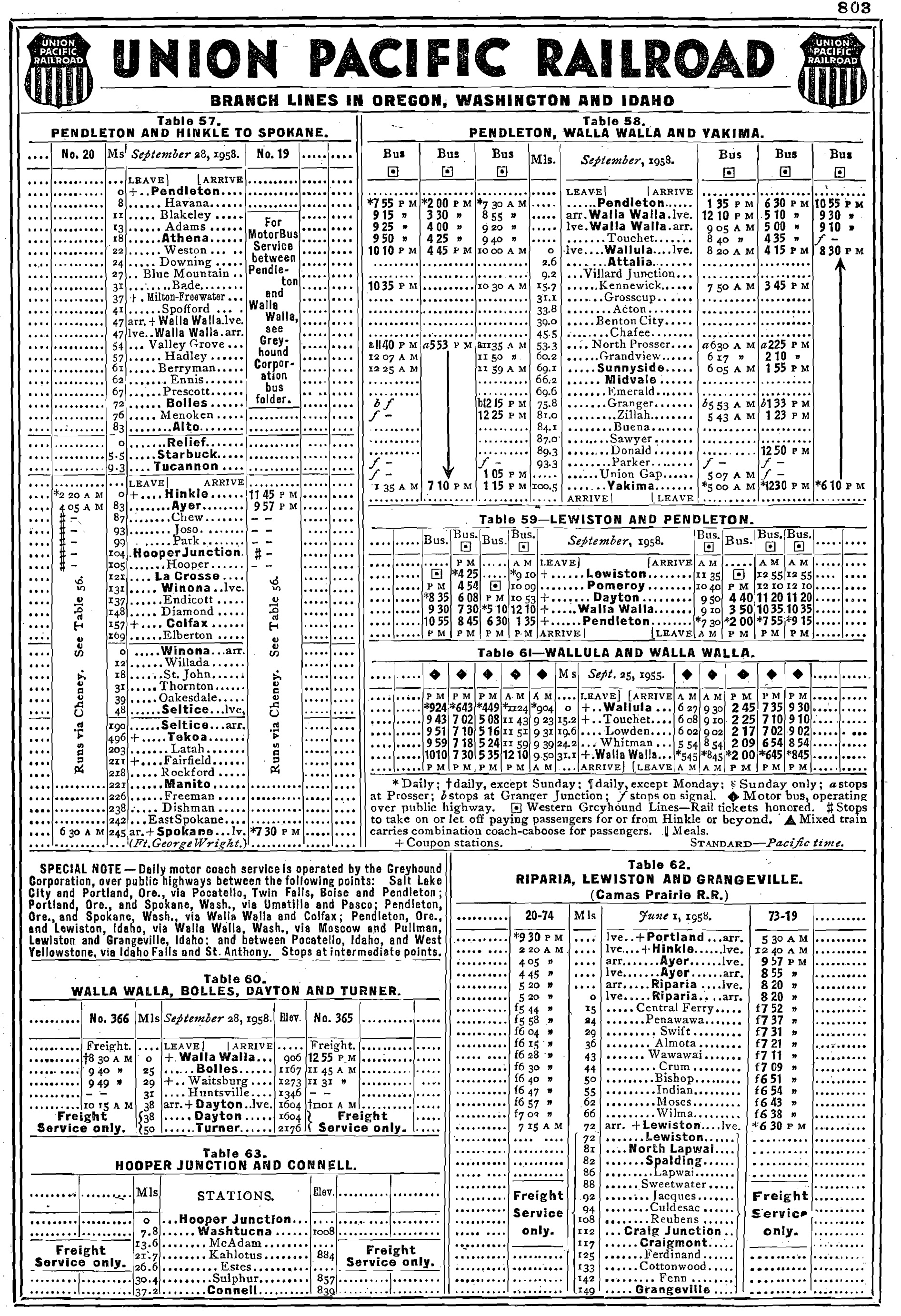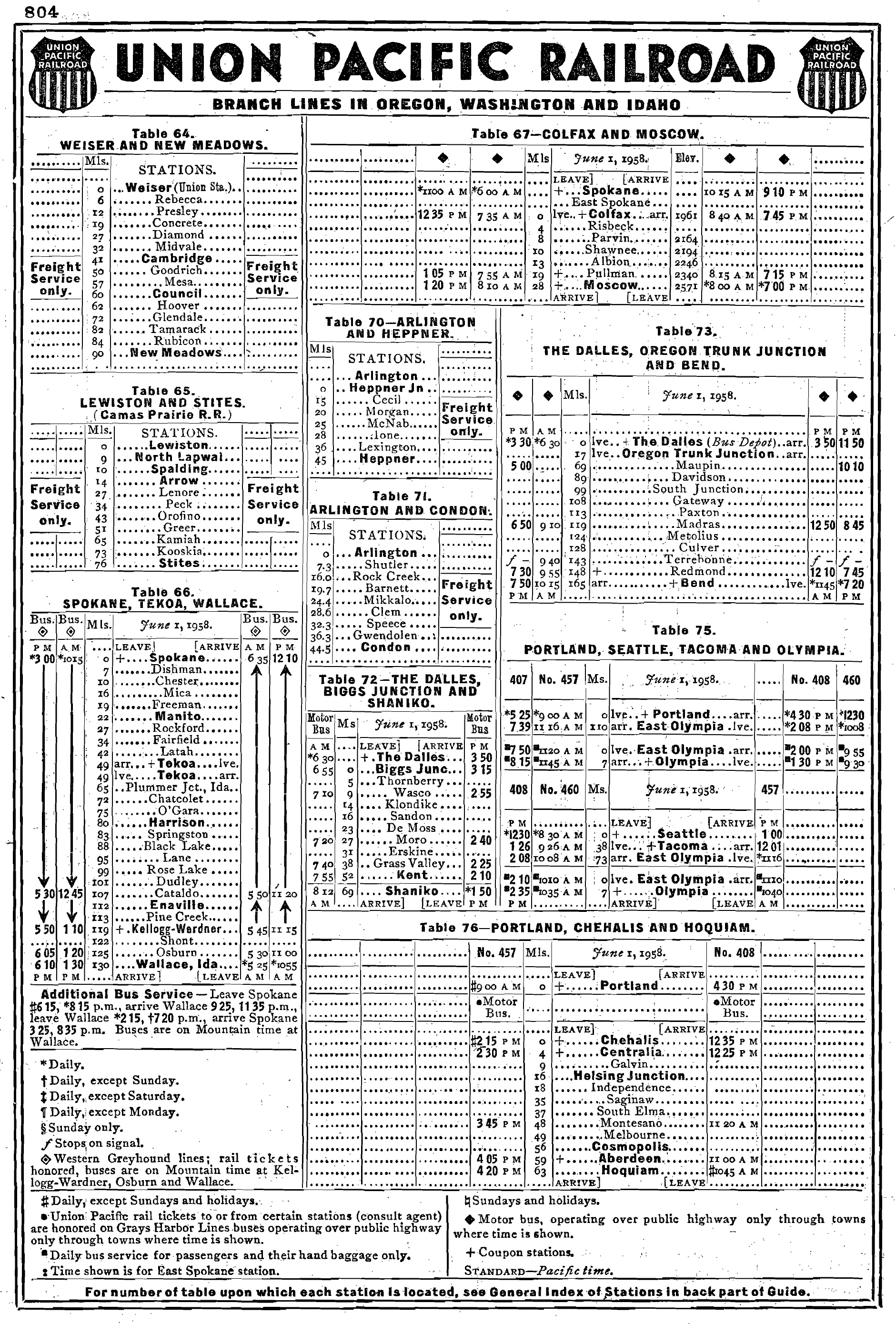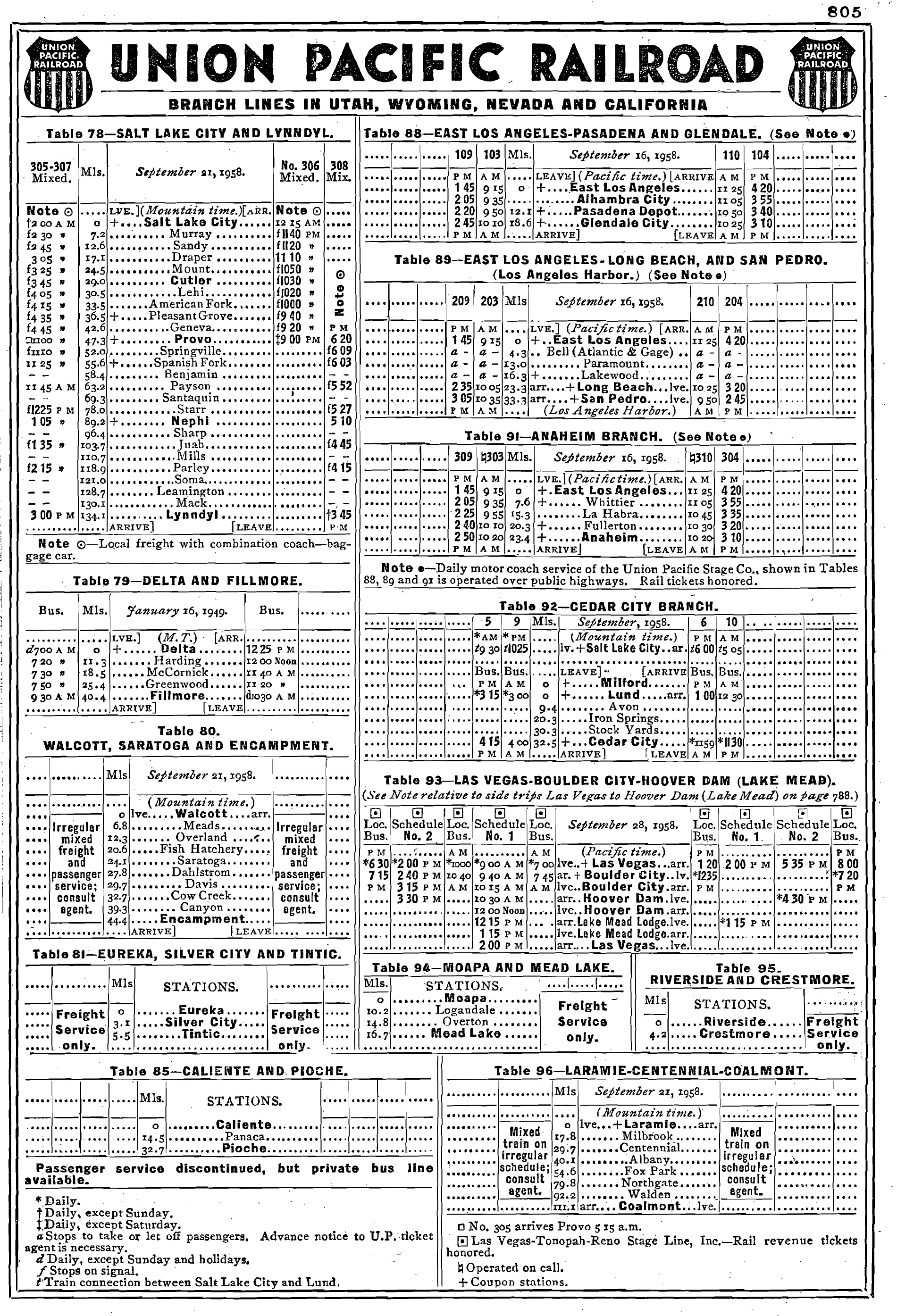Union Pacific Railroad: Map, History, Logo
Last revised: October 16, 2024
By: Adam Burns
The Union Pacific (UP) is one the largest and most powerful
railroads in the country. This historic system has been in operation since before the Civil War and much of the general public has at least a general knowledge of UP since it formed the eastern segment of the Transcontinental Railroad.
In that time the railroad has become not only one of the most highly respected institutions in the nation (it currently ranks as a top Fortune 150 company) but also has seen nearly every major railroading event and milestone in our country’s history.
Except for a troubled period at the end of the 19th century when an overextended Union Pacific fell into receivership the company has been well-managed through the years. Thanks to the its forward thinking, during the postwar period UP began gobbling up smaller, and larger, railroads.
These moves propelled it into becoming the massive and successful system it is today, serving most states and communities west of the Mississippi River.
Featured here is a brief history of one of America's great corporations. You probably know the story of the Transcontinental Railroad, Union Pacific's role, and how it opened the West to vast economic opportunities.
Photos
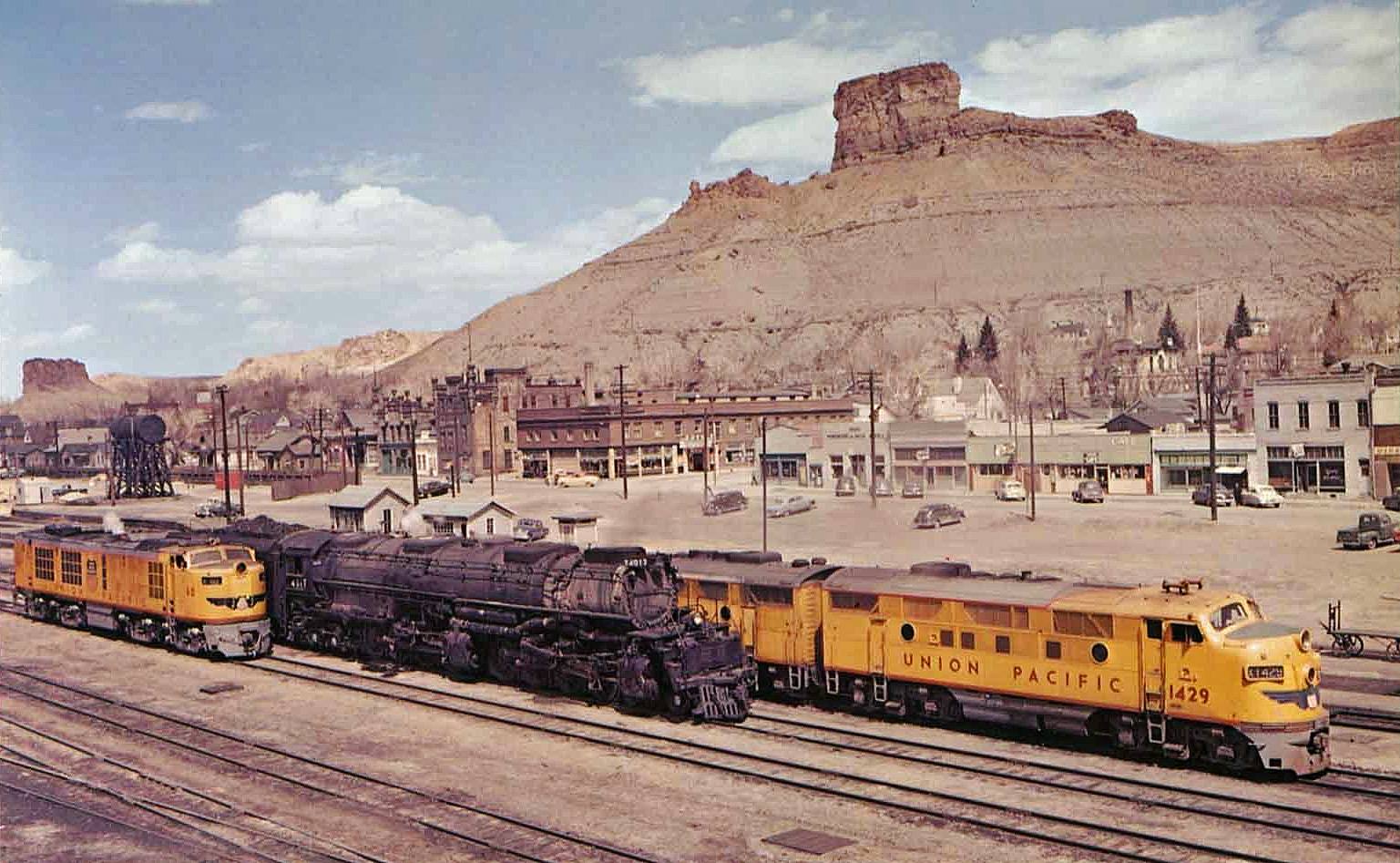 A Union Pacific publicity photo taken at Green River, Wyoming circa 1952. From left to right is first-generation gas-turbine #60, 4-8-8-4 "Big Boy" #4017, and F7's (rebuilt from F3's).
A Union Pacific publicity photo taken at Green River, Wyoming circa 1952. From left to right is first-generation gas-turbine #60, 4-8-8-4 "Big Boy" #4017, and F7's (rebuilt from F3's).History
However, you may not be aware that UP has blossomed into one of America's great success stories, similar to Coca-Cola, General Electric, and the Ford Motor Company.
The concept for what eventually became Union Pacific has its roots in the spring of 1853 when then-U.S. Secretary of War Jefferson Davis (who later became president of the Confederate States of America) began surveying western routes beyond the Mississippi to link the Pacific Coast as part of the government's endeavor to complete a transcontinental line.
According to the book, "The Northern Pacific, Main Street Of The Northwest: A Pictorial History" by author and historian Charles R. Wood there were a total of eight different options put forth running along various parallels from north to south. Due to the ongoing issue of slavery, Congress could not come to a consensus on which.
However, following the outbreak of hostilities, a unified Northern delegation decided upon a central option along the 42nd parallel.
In addition, just before the war broke out, Abraham Lincoln became the country's 16th President. With the routing chosen Congress passed the Pacific Railroad Act of 1862, signed into law by President Lincoln on July 1, 1862.
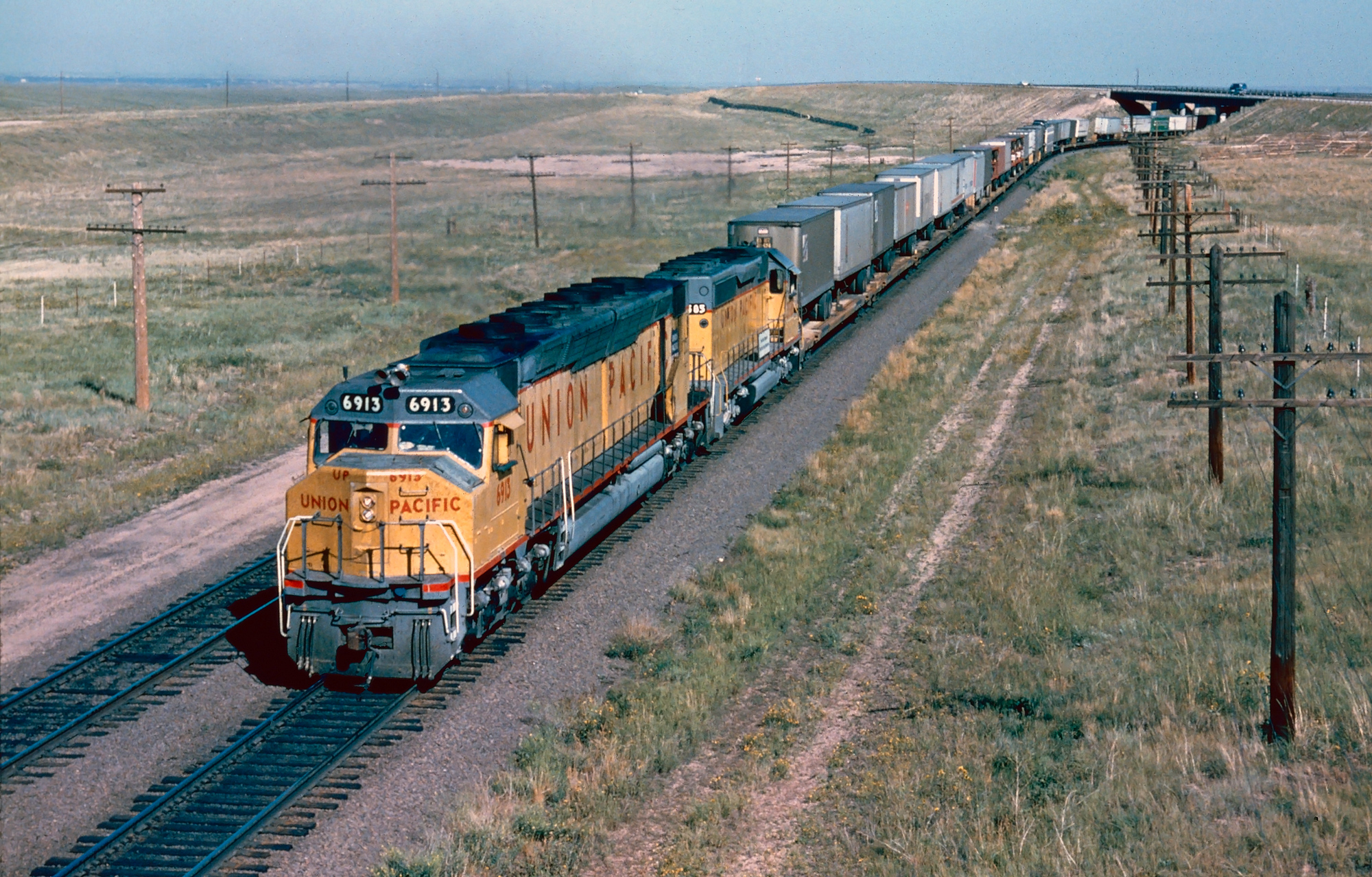 Union Pacific DDA40X "Centennial" #6913 and an SD40-2 lead trailers westbound outside of Cheyenne, Wyoming as the train passes beneath Interstate 80, circa 1984. Mike Bledsoe photo. American-Rails.com collection.
Union Pacific DDA40X "Centennial" #6913 and an SD40-2 lead trailers westbound outside of Cheyenne, Wyoming as the train passes beneath Interstate 80, circa 1984. Mike Bledsoe photo. American-Rails.com collection.Transcontinental Railroad
This event corresponded with Union Pacific's incorporation although some time passed before construction actually commenced. As you can see the railroad was born largely through the government and as such carried considerable startup capital, something most other ventures then did not enjoy.
Despite such perks the entire project was complex and arduous; as other historians have noted it was similar in difficulty to placing a man on the moon a century later.
While some states had been created when construction began, such as California, Kansas, Nevada, and Oregon there was no infrastructure in place to assist the project; virtually everything had to be hacked out of the wilderness while dealing with angry Native Americans who were extremely upset with the White Man's invasion into their ancestral hunting grounds (the U.S. Army eventually had to be called in to protect the project).
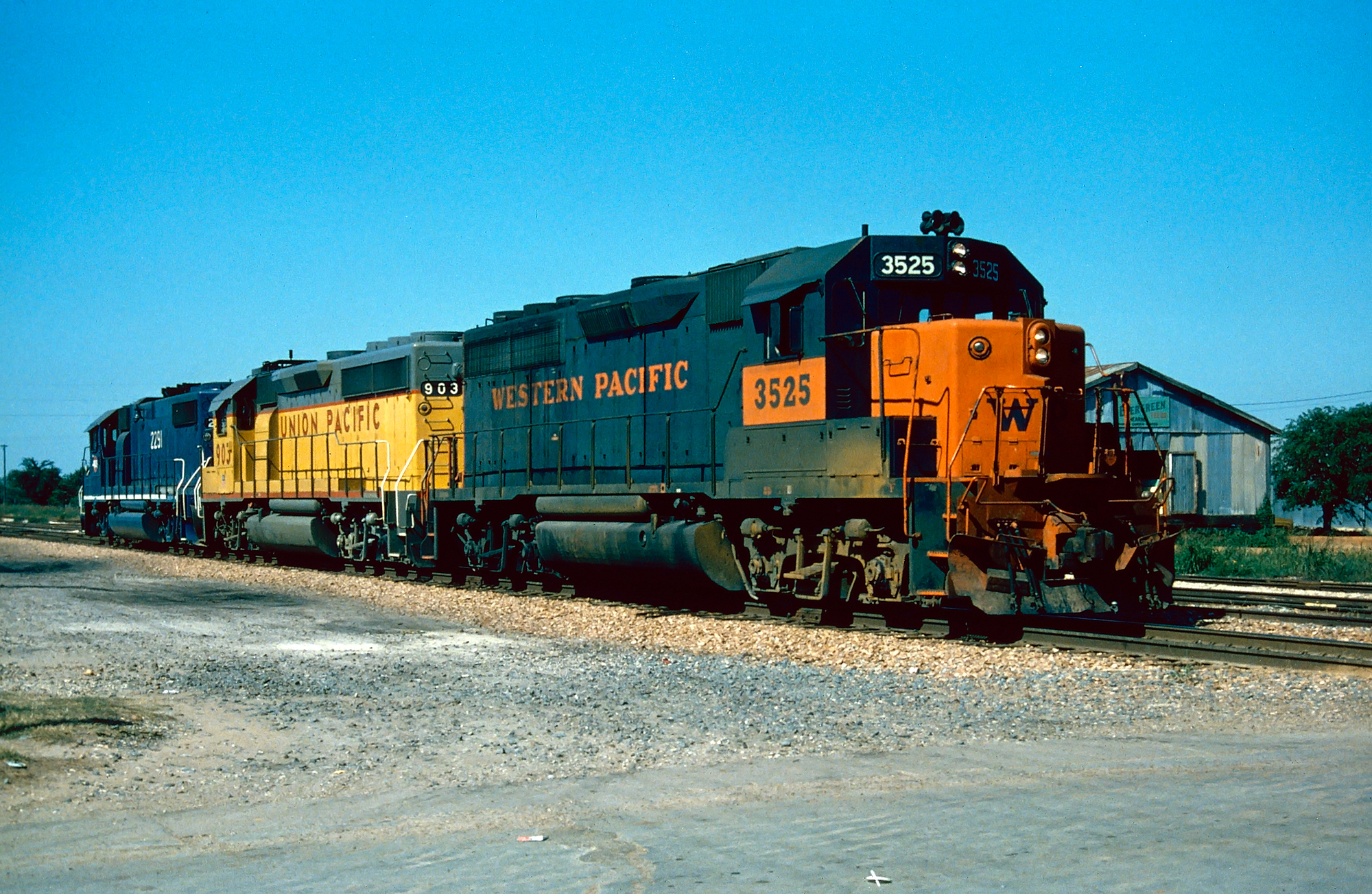 A few additions to the Union Pacific family are seen here as Western Pacific GP40 #3525, UP GP40-2 #903, and Missouri Pacific GP38-2 #2251 (ex-Rock Island #4313) layover in Taylor, Texas in the summer of 1984. Mike Bledsoe photo. American-Rails.com collection.
A few additions to the Union Pacific family are seen here as Western Pacific GP40 #3525, UP GP40-2 #903, and Missouri Pacific GP38-2 #2251 (ex-Rock Island #4313) layover in Taylor, Texas in the summer of 1984. Mike Bledsoe photo. American-Rails.com collection.The 19th century was part of the United States' great industrial revolution, of which the railroads were key. The growing and expanding country established great manufacturing centers in the Northeast while the South generated prodigious volumes of cotton and textiles.
As the railroad proved its value in the 1830s, and then blossomed into the fastest and most efficient means of transportation the world have ever seen, new economic centers such as Chicago, Indianapolis, and St. Louis flourished across the Midwest.
Realizing its vast potential, the government funded the Transcontinental Railroad's construction. Its intended goals included opening the West, encouraging settlement and trade, and improving national defense by providing better protection along its coastal borders.
As Joe Welsh and Kevin Holland note in their book, "Union Pacific Railroad," following the Transcontinental Railroad's completion the journey from New York to San Francisco was sliced from six months to just ten days.
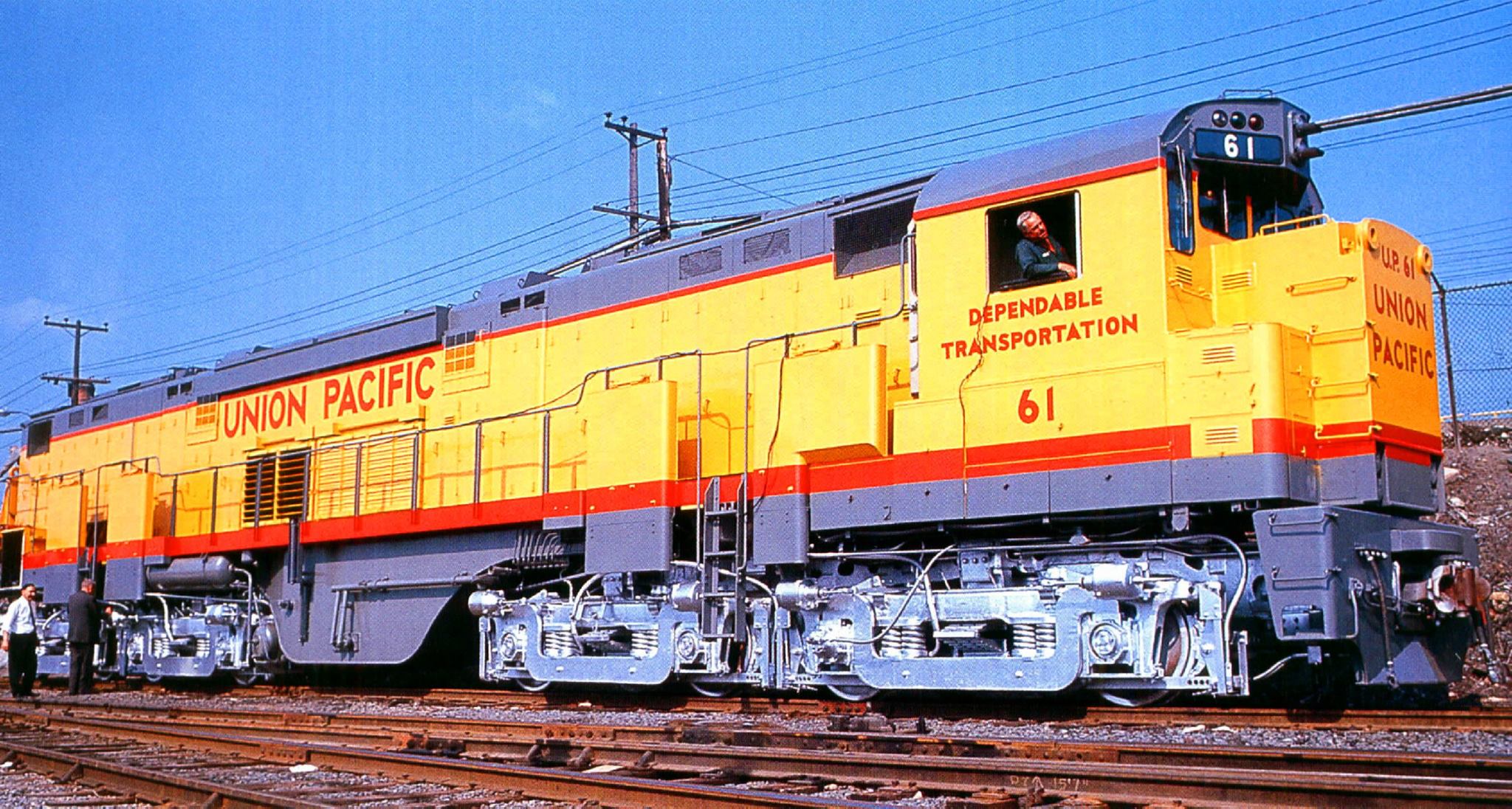 A true monster; Alco's 5,500 horsepower C855, which utilized a pair of 251C prime movers, is seen here in a company photo circa 1964. Only three were manufactured, all for Union Pacific. After less than a decade of service, the trio was scrapped.
A true monster; Alco's 5,500 horsepower C855, which utilized a pair of 251C prime movers, is seen here in a company photo circa 1964. Only three were manufactured, all for Union Pacific. After less than a decade of service, the trio was scrapped.While Congress mandated Union Pacific specifically to build the line's eastern leg, the western segment was the job of Central Pacific. This system had been organized by Collis P. Huntington, Mark Hopkins, Leland Stanford, and Charles Crocker (the so-called "Big Four") on June 28, 1861.
It was directed to "construct a railroad and telegraph line from the Pacific coast, at or near San Francisco, or the navigable waters of the Sacramento River, to the eastern boundary of California." With the passage of the Pacific Railroad Act the CP adopted the agreement on October 7th and formally accepted it through the Department of the Interior on December 24th.
During 1863, UP turned the first mound of soil from Omaha, Nebraska and set out westward. This, in itself, was an interesting starting point since the railroad was still disconnected from the national rail network; Omaha and Council Bluffs, Iowa were separated by the mighty Missouri River and it was not until 1872 that a new bridge opened across the waterway, linking UP with what was later the Chicago & North Western and other carriers.
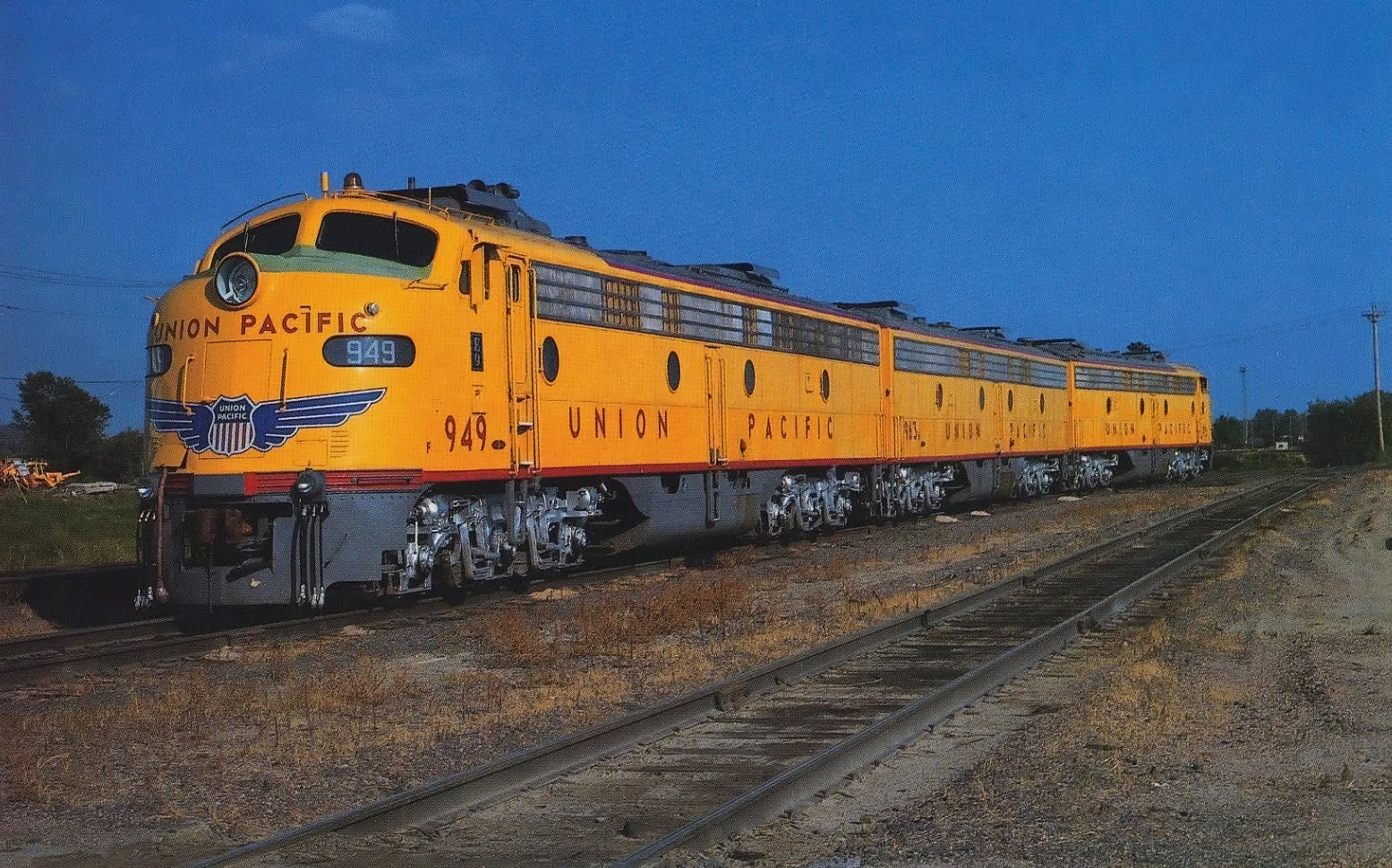 An A-B-A set of Union Pacific E9's (#949, #963-B, and #951) at Council Bluffs, Iowa on August 9, 1993. George Cockle photo.
An A-B-A set of Union Pacific E9's (#949, #963-B, and #951) at Council Bluffs, Iowa on August 9, 1993. George Cockle photo.The new Union Pacific was led by President John Dix with Vice-President Thomas Durant second in command. Durant quickly asserted himself as the leading authority although he technically was in charge only of UP's construction.
A sly individual set upon enriching himself, he and several associates formed Credit Mobilier in 1864, originally known as the Pennsylvania Fiscal Agency a loan and contract company created in 1859. Mobilier would be used as the conduit upon which monies were distributed to Union Pacific for its construction.
At A Glance
9,720 (1950) 32,452 (Today) |
|
Diesels: 1,347 Steam: 29 |
|
Freight Cars: 54,959 Passenger Cars: 851 |
|
Be Specific, Ship Union Pacific Dependable Transportation Road Of The Streamliners Serves All The West Pulling For You We Will Deliver We Can Handle It! | |
Perhaps not surprisingly this setup was greatly abused; Durant used the company to grossly overcharge UP and the government for contract work, nearly driving the railroad into bankruptcy. The extra profits were then simply pocketed by Durant and his partners. The issue wasn't resolved until 1872 although little punishment was ever handed down to those involved in the corruption.
By late 1865 UP had spent $500,000 but laid only 40 miles of track. Then project engineer quit in frustration and Durant subsequently hired Greenville Dodge to replace him.
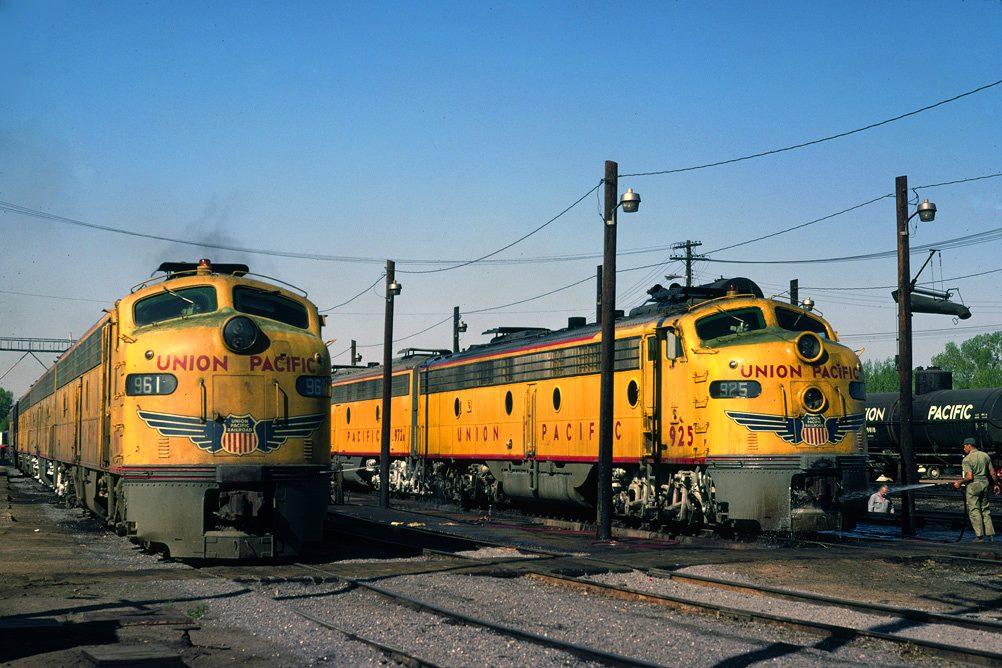 Union Pacific covered wagons are serviced near the roundhouse at Ogden, Utah on the morning of May 10, 1969. To the left is E9A #961 while to the right, and being washed, is E8A #925. The author notes one of these sets will power the "City Of San Francisco" while the other is likely to be used for the Golden Spike centennial celebrations ongoing that day. Drew Jacksich photo.
Union Pacific covered wagons are serviced near the roundhouse at Ogden, Utah on the morning of May 10, 1969. To the left is E9A #961 while to the right, and being washed, is E8A #925. The author notes one of these sets will power the "City Of San Francisco" while the other is likely to be used for the Golden Spike centennial celebrations ongoing that day. Drew Jacksich photo.Dodge proved far better at dealing with Durant and often ignored his boss if he felt it was in the best interest of the company. As a result, UP's western line rushed quickly across the plains, building up to 8.5 miles of new railroad per day.
However, in doing so corners were cut including poor grade construction, weak bridges, and lack of sufficient tie usage. Only later, under better leadership, were these issues corrected. Despite the initial shoddy construction it was incredible the logistics the project overcame in seeing the route completed.
Since the region carried few trees, and of course no way to manufacture rails, these all had to be shipped in from the East. According to Dodge it was so well organized that at no time did crews run short on supplies.
The only real issue the railroad dealt with was keeping the men focused; all along the route towns sprang up to accommodate the workers during downtime. They usually spent this freedom drinking in bars and enjoying brothels, until moving on to the next settlement. As Welsh and Holland note in their book this led to the term "hell on wheels."
System Maps
An American Western television series of the same name was loosely based on the phenomenon and the Transcontinental Railroad's construction. It aired from 2011 to 2016 on AMC. Another, somewhat less scandalous incident, took place as the two roads neared one another.
In an effort to stake more land from the government and pocket even more money, Union Pacific and Central Pacific actually began grading lines past one another!
The silliness was finally put to end when the two formally met at Promontory, Utah on May 10, 1869 with a symbolic driving of a golden spike (however, a golden spike was not actually pounded into the railroad tie as gold is much too soft).
The event took place at 12:47 p.m. that day and was performed by Leland Stanford. Interestingly, even now sections of these never-used grades can be seen.
The completion of the Transcontinental Railroad was one of the great achievements in American history and was so famous that Western Union carried out lived updates. When the final spike was driven the word "done" was wired across the country.
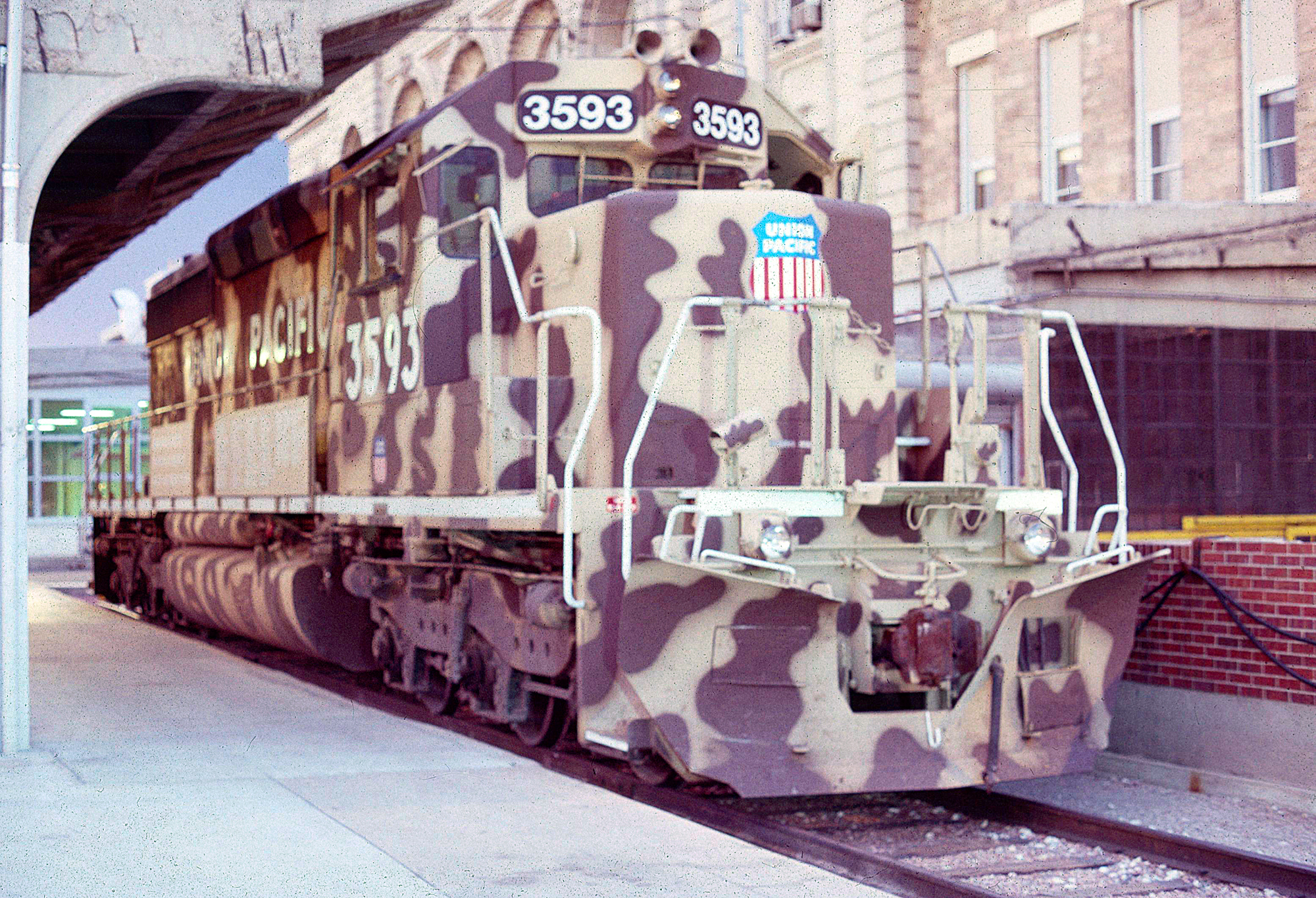 Union Pacific SD40-2 #3593, when the locomotive wore a camouflage livery and christened "Desert Victory" in honor of the 66 company employees who served in Operation Desert Storm. The unit was released from the North Little Rock Shops on February 27, 1991, touring the UP system and all 19 states the railroad then served. It is seen here at Denver Union Station on July 12, 1991. Kenneth Mock photo. American-Rails.com collection.
Union Pacific SD40-2 #3593, when the locomotive wore a camouflage livery and christened "Desert Victory" in honor of the 66 company employees who served in Operation Desert Storm. The unit was released from the North Little Rock Shops on February 27, 1991, touring the UP system and all 19 states the railroad then served. It is seen here at Denver Union Station on July 12, 1991. Kenneth Mock photo. American-Rails.com collection.The Union Pacific’s original main line is the Overland Route, which runs between Ogden, Utah; Omaha, Nebraska; and Chicago. The future of the Union Pacific is as wide open as the great western plains where the railroad operates.
However, if the company’s past is any measure of what may happen in the years ahead, I think we can safely say that when the merger movement picks up again the railroad, and its famous shield logo, will continue to flank locomotives during their daily task of moving goods across the country.
Logo
It is also important to note the company's nod to its history. Union Pacific operates an impressive heritage fleet of original equipment from its streamlined business train clad in its classic Armour yellow and gray to its stable of steam locomotives maintained at its roundhouse in Cheyenne, Wyoming.
Steam Program
When Union Pacific elected to save one its Class FEF 4-8-4s as steam operations wound down during the 1950s it planted the seeds of what is today considered one of the greatest heritage fleets across the country, and perhaps the world.
That locomotive was #844 and today it is a household name throughout the railfan community having hosted numerous special excursions over the many decades as the only steamer never officially retired from a Class I railroad.
Since then UP has added several classic steam and diesel models to its roster, most of which are housed in its shops and roundhouse at Cheyenne, Wyoming.
The most spectacular addition occurred during 2013 when UP announced it would acquire one of the fabled 4-8-8-4 Big Boys for the fleet, often regarded as one of the largest and most powerful examples of traditional steam designs ever built.
The traffic strains felt by World War II meant that many railroads were struggling to avoid power shortages. This issue was no different for the Union Pacific.
Needing additional and more powerful locomotives for passenger operations UP went to the American Locomotive Company (Alco) requesting a batch of 4-8-4s. The first arrived in 1937, given Class FEF-1, and numbered 800-819.
While UP would have liked new diesels wartime restrictions prevented this. In any event, the new Northerns were able to save the railroad some $300,000 annually at a cost of roughly $10-$11 per mile. During 1939 UP purchased additional examples, Class FEF-2's #820-834, and completed the roster with the Class FEF-3's of 1944, #835-844.
After the war diesels soon supplanted steam and the Northerns, despite their advanced technologies and cost savings, were bumped to freight assignments.
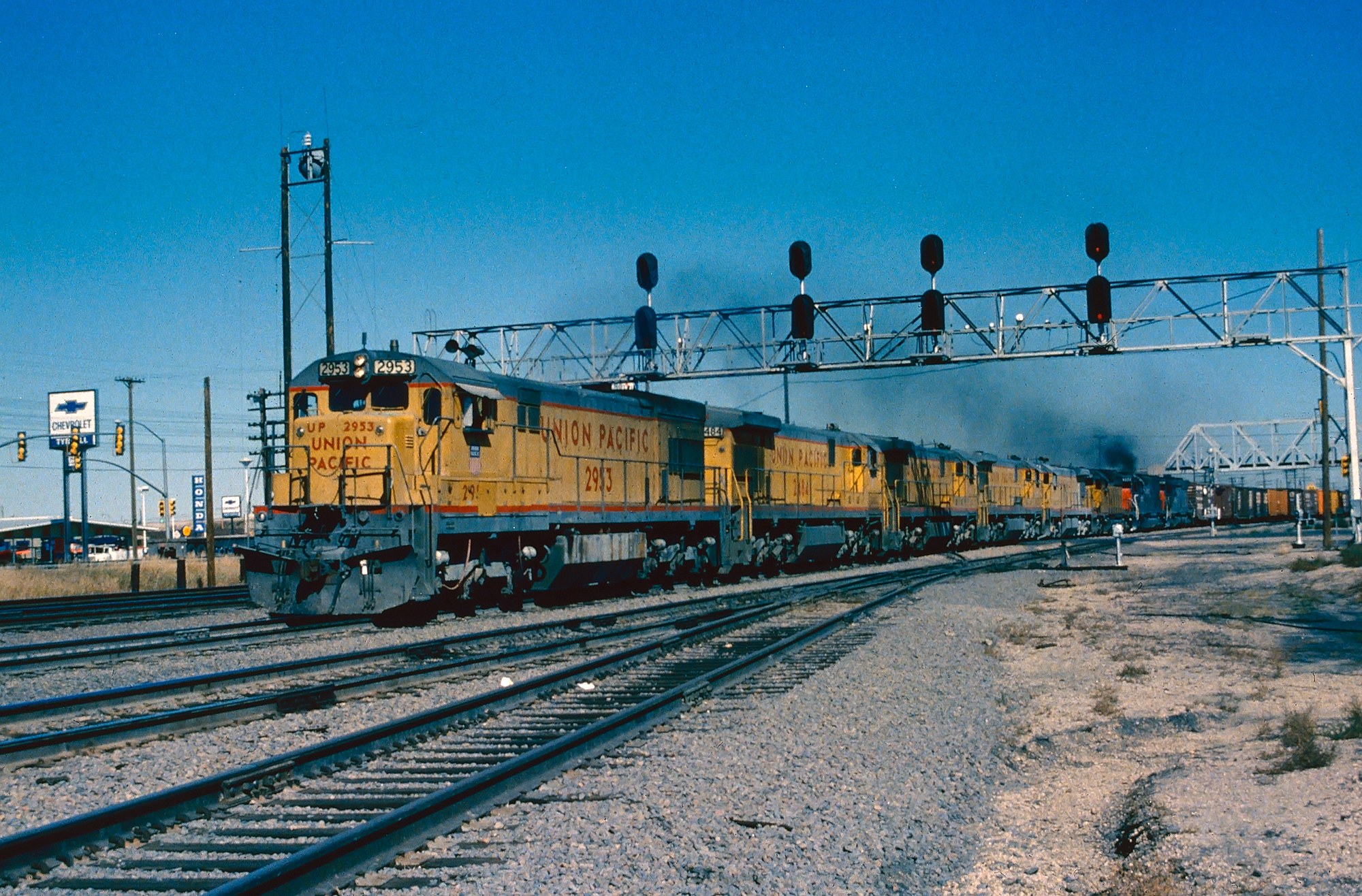 Union Pacific U30C #2953, several other GE's, and a few EMD's, lead a westbound out of Cheyenne, Wyoming, circa 1983. Mike Bledsoe photo. American-Rails.com collection.
Union Pacific U30C #2953, several other GE's, and a few EMD's, lead a westbound out of Cheyenne, Wyoming, circa 1983. Mike Bledsoe photo. American-Rails.com collection.In 1954 UP began retiring the first of the 4-8-4s although the locomotives continued to see service through 1962. At this time the end of steam on the railroad appeared imminent.
However, in a move unique only to UP the railroad spared #844 following her final freight assignments performed in 1959. A year later the Northern began hosting special excursions from its base of operations in Cheyenne, Wyoming.
This location, an important division point on the UP with a large roundhouse and turntable, became the permanent home of the locomotive. In 1961 new Electro-Motive GP30s arrived, which were given the 800 numbering series and forcing the Northern to be reassigned as #8444 for a time.
One of its most notable excursions during these early years included Ross Rowland's Gold Spike Special to celebrate the centennial of the transcontinental railroad completion on May 10th, 1969.
Steam Fleet
4-8-4 #844
| Road Number | Builder | Class | Overall Wheelbase | Engine/Tender Weight | Tractive Effort | Date Built |
|---|---|---|---|---|---|---|
| 844 | Alco | FEF-3 | 98 1/2 Feet | 908,000 Pounds | 63,750 Pounds | 1944 |
4-6-6-4 #3985
(1981-2010, Officially retired and off roster.)
Donated to Railroading Heritage of Midwest America in 2022.
| Road Number | Builder | Class | Overall Wheelbase | Engine/Tender Weight | Tractive Effort | Date Built |
|---|---|---|---|---|---|---|
| 3985 | Alco | 4664-4 | 99 Feet | 1,063,500 Pounds | 97,352 Pounds | 1942 |
4-8-8-4 #4014
| Road Number | Builder | Class | Overall Wheelbase | Engine/Tender Weight | Tractive Effort | Date Built |
|---|---|---|---|---|---|---|
| 4014 | Alco | 4884-1/Big Boy | 117 1/2 Feet | 1,189,500 Pounds | 135,375 Pounds | 1941 |
Since then the 4-8-4 has become the most visible public relations ambassador on the Union Pacific system, hosting numerous excursions annually, leading the business train during various outings, and/or sitting on display for special events such as the College World Series in Omaha and the annual Cheyenne Frontier Days.
Beginning in 1977 UP added to its steam program when restoration was launched on 4-6-6-4 #3985 and completed through an all-volunteer effort by 1981. To celebrate the restoration the Challenger was sent to Railfair '81 at Sacramento to help showcase the opening of the California State Railroad Museum that year.
The big articulated was used on several outings and excursions from its completed restoration in 1981 until 2010 when the locomotive was sidelined for major overhaul.
It has since been donated to Railroading Heritage of Midwest America (RRHMA), headed by Steve Sandberg, and will be restored to active service for excursions. This is the same group which has operated Milwaukee Road 4-8-4 #261 for many years.
The biggest news regarding the steam program occurred in 2013 when UP announced it would acquire one of the largest and most powerful designs ever built, 4-8-8-4 "Big Boy" #4014 which had set on display in Pomona, California since the early 1960s.
It was chosen since the locomotive was in relatively good condition and will certainly become the star attraction on the railroad regardless of how often it leaves the roundhouse. After it was moved to Cheyenne in 2014 the locomotive began its complete restoration in 2016.
This work was completed in May, 2019 and the 4-8-8-4 embarked on a PR campaign that exceeded even the railroad's restoration. It is estimated its trips (which concluded in November, 2019) drew an estimated 1 million+ trackside to see the massive locomotive.
There are also some other notable heritage pieces kept at Cheyenne including one of the largest diesels ever constructed, Electro-Motive DDA40X Centennial #6936. This locomotive remains operational and also occasionally pulls excursions.
Additionally, UP's fleet of streamlined E9s normally assigned to the business train call there for maintenance as do its restored, lightweight cars. Finally, there are two other steamers, both of UP heritage albeit non-operational, kept at the roundhouse including 2-10-2 #5511 and 4-8-4 #838.
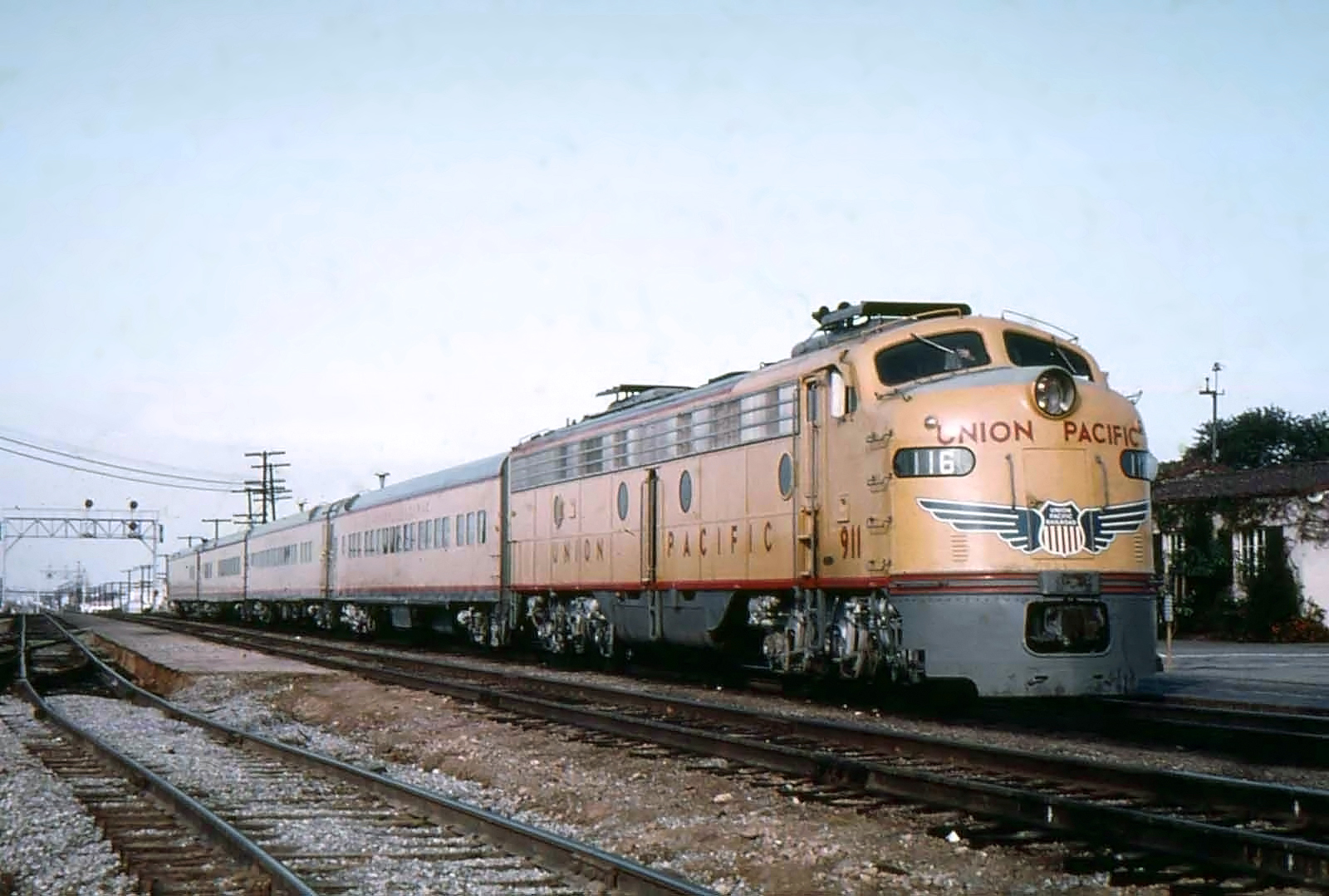 What remains of Union Pacific's train #116, the eastbound "City of Las Vegas" (Los Angeles - Las Vegas), is seen here in Los Angeles, circa 1965.
What remains of Union Pacific's train #116, the eastbound "City of Las Vegas" (Los Angeles - Las Vegas), is seen here in Los Angeles, circa 1965.Ed Dickens, the head of Union Pacific's steam program offered a little more insight regarding why 4-6-6-4 #3985 is now permanently retired (made official in January, 2020 but retroactive to May, 2019):
"A quick update regarding the UP 3985. Information has been released as far back as May of this year [2019] regarding its current status...Which is...officially retired.
As mentioned during that time there are no plans to restore the UP 3985.
Having fired and operated that locomotive many, many thousands of miles this is not the news that you or I want to hear. But I feel most everyone understands having two steam locomotives on the roster has historically been the norm on the Union Pacific. This is still the case.
As time permits we may release additional information on exactly why that locomotive has not operated since 2010. Many years of hard operation has resulted in the locomotive requiring a complete frame up restoration just as the big boy [sic] received recently."
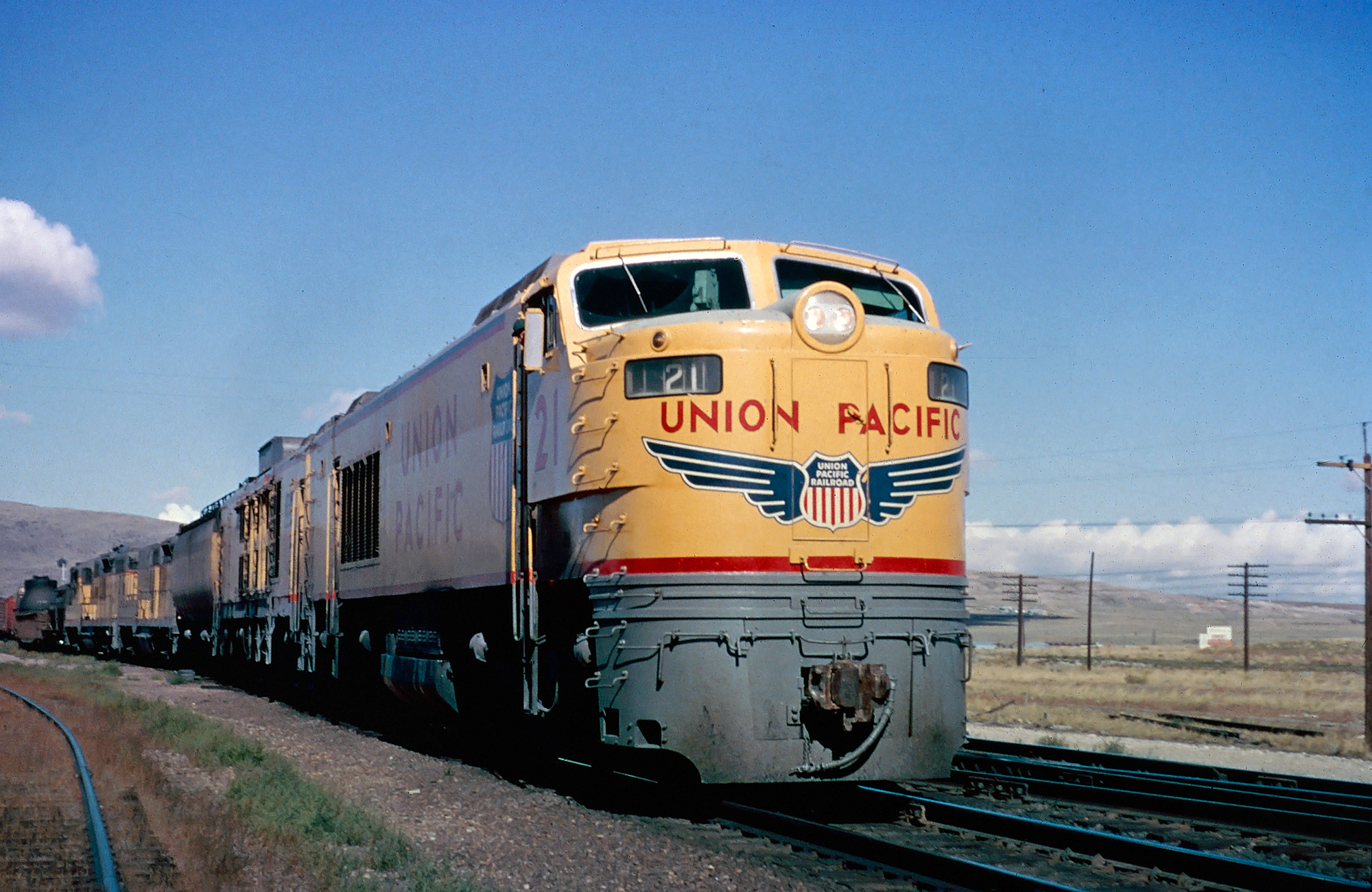 Union Pacific "Big Blow" gas turbine set #21 near Laramie, Wyoming, circa 1965. American-Rails.com collection.
Union Pacific "Big Blow" gas turbine set #21 near Laramie, Wyoming, circa 1965. American-Rails.com collection.Expansion
After the Transcontinental Railroad opened much work remained in upgrading the property for heavy rail service and pushing rails across other parts of the West. The Union Pacific did not immediately blossom into a wealthy system but it was rich in land and used this to its advantage.
When constructing its original main line an amended Pacific Railroad Act of 1864 authorized 12,000 acres of land grants for every new mile constructed.
In 1873 noted tycoon Jay Gould acquired a controlling interest in UP and set about upgrading its infrastructure while expanding its reach. Just a year after doing so he purchased controlling interest in the nearby Kansas Pacific Railway, providing UP with a southerly line linking Denver with Kansas City.
It was formally consolidated in 1880. At the same time expansions continued through Utah reaching Salt Lake City in 1870 (via the Utah Central) and Butte, Montana in 1881 (Utah Northern).
In the 1880s, UP began its push into the Pacific Northwest; by 1883 it was operating more than 400 miles into Idaho via the main line at Granger, Wyoming through a subsidiary known as the Oregon Short Line.
Gould's interest in the railroad ended in 1884 although this did not slow its expansion efforts; it gained control of the nearby Oregon Railway & Navigation Company in 1887 which offered new access points such as Portland and Pendleton, Oregon as well as Spokane, Washington.
In 1890 the railroad formed a subsidiary known as the Union Pacific, Denver & Gulf Railway; this massive entity provided connections from Dallas/Fort Worth, Texas to Orin Junction, Wyoming linking cities such as Denver, Pueblo, Cheyenne, Amarillo and others along the way via a north-south routing.
There was also narrow-gauge property that ran from Golden up Clear Creek to Central City and Silver Plume, Colorado. In all, it comprised roughly 1,600 miles of trackage.
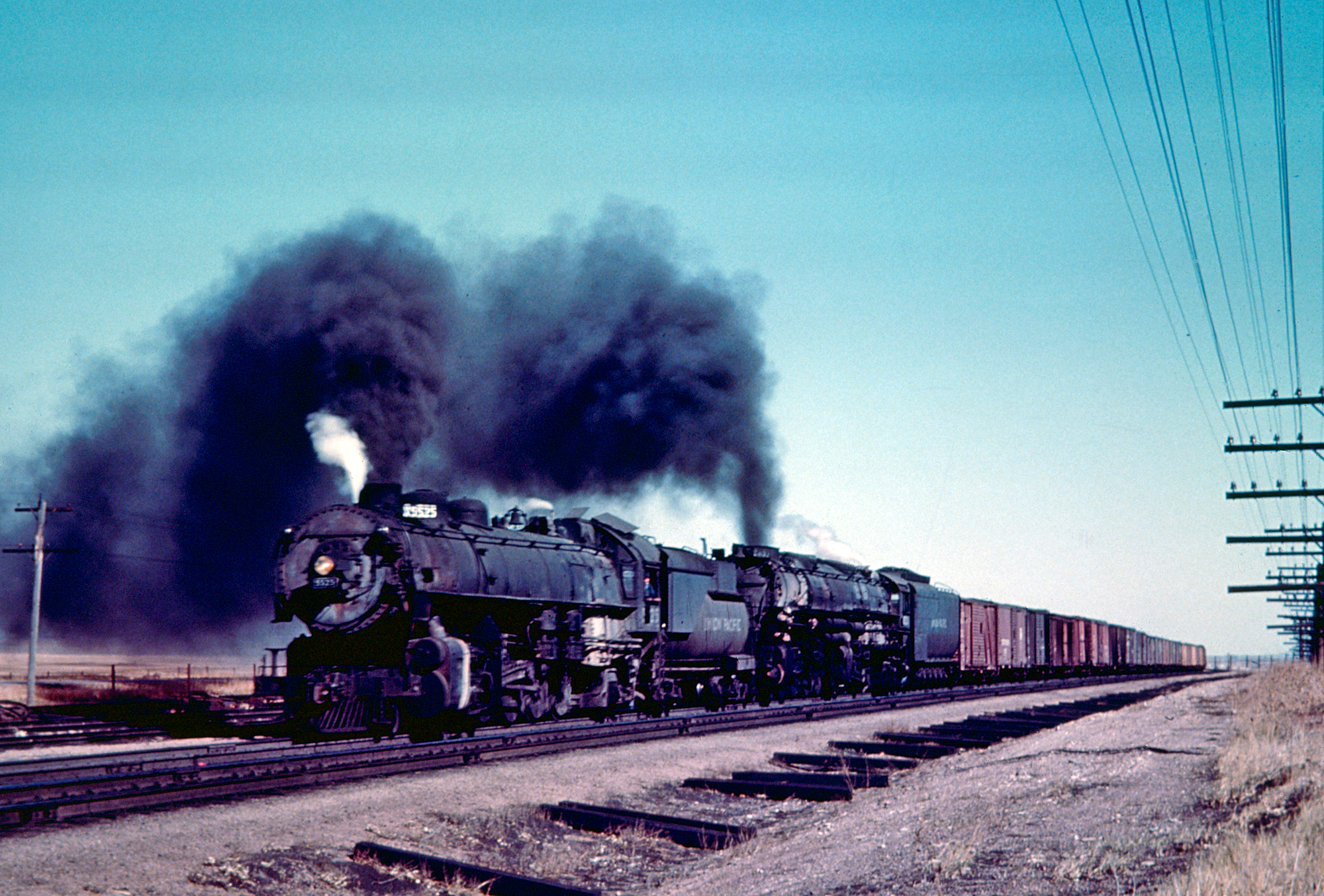 Union Pacific 2-10-2 #5525 and a 4-8-8-4 "Big Boy" head west through western Nebraska during the 1950s. Ed Olsen photo. American-Rails.com collection.
Union Pacific 2-10-2 #5525 and a 4-8-8-4 "Big Boy" head west through western Nebraska during the 1950s. Ed Olsen photo. American-Rails.com collection.Alas, the rapid expansion would severely cost the company; it was far too overextended in debt and fell into receivership in 1893. Union Pacific was not alone in this regard as several other railroads had experienced similar set backs which led to the great financial Panic of 1893.
The UP's resulting bankruptcy broke up its network when sold at foreclosure on November 1, 1897. Then, E.H. Harriman (Edward Henry "Ned" Harriman), along with a group of investors, stepped in to acquire the former Transcontinental main line between Omaha to Ogden for $110 million.
As one of the industry's great businessmen, still highly respected today, his leadership saw Union Pacific rebound and flourish.
He spent more than a decade reacquiring most of the railroad's lost trackage (although the former lines south of Colorado and into Texas were reorganized as the Colorado & Southern, which eventually entered the Chicago, Burlington & Quincy's fold) and vigorously upgraded the property for modern-day operation into the 20th century.
As Welsh and Holland note in their book, by 1909, at the time of Harriman's death (September), its traffic density had increased 186% from thirteen years prior.
Aside from infrastructure upgrades and new equipment, the company's major developments leading up to World War I included the consolidation of its lines in the Pacific Northwest and a new link to Los Angeles.
The former included more than twenty subsidiaries which were brought together under the title of two holding companies; the Oregon Short Line Railroad and Oregon-Washington Railroad & Navigation Company. In addition, its line into Southern California proved one of its most important acquisitions.
It was originally known as the San Pedro, Los Angeles & Salt Lake Railroad incorporated in 1901 through several subsidiaries linking its namesake cities (renamed the Los Angeles & Salt Lake Railroad after 1916). Following a long battle with William Andrews Clark who wanted his own route to Salt Lake City, UP and Harriman signed an agreement for a 50% interest in the SPLA&SL.
On August 25, 1916 it changed its name to the aforementioned LA&SL and on April 27, 1921 UP acquired full control from Clark. On January 1, 1936 these systems, and others, were formally consolidated into the railroad.
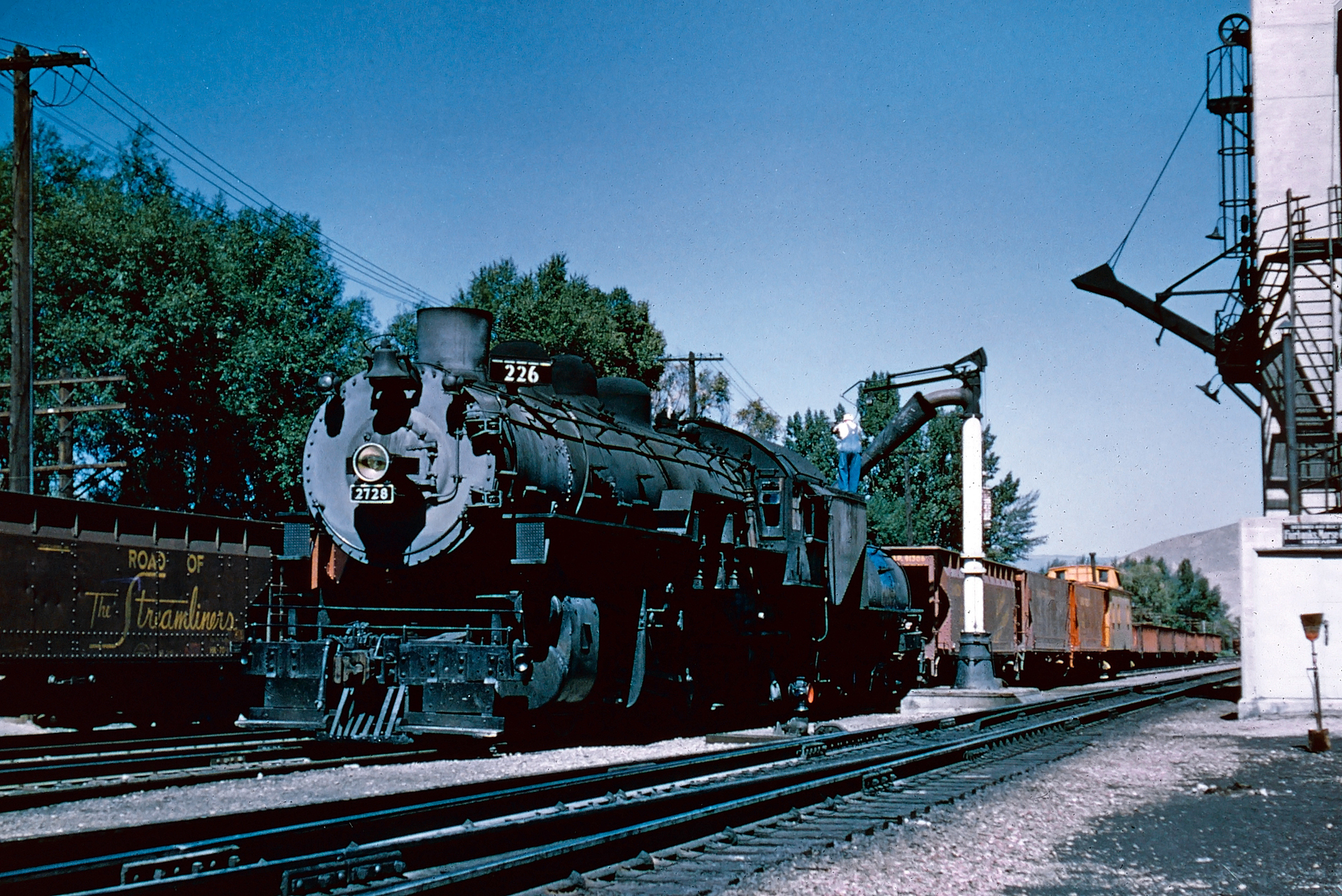 Union Pacific 2-8-2 #2728 gets a drink at the yard in Echo, Utah before making a run down the Park City Branch with freight #226 on August 29, 1955. John Shaw photo. American-Rails.com collection.
Union Pacific 2-8-2 #2728 gets a drink at the yard in Echo, Utah before making a run down the Park City Branch with freight #226 on August 29, 1955. John Shaw photo. American-Rails.com collection.Through The Mid-20th Century
Even by the early 20th century, Union Pacific was a highly respected company thanks to Harriman's visionary leadership. It had even controlled Southern Pacific between 1901 and 1912 before a Supreme Court decision forced the road to divest its holdings due to antitrust laws.
UP had spent millions upgrading its subsidiary but alas the efforts had largely went for naught. In an ironic twist, it would outright purchase the SP just before century's end. The Great Depression of late 1929 hit the country, and industry, hard as financial institutions and the economy collapsed.
However, thanks to the UP's sound business practices it weathered the storm relatively well, even continuing to pay a dividend during that time. It earned a great deal of publicity by making history with the country's first radical and sleek streamliner trainset, delivered to the railroad on February 25, 1934.
It was a product of Pullman-Standard and the Winton Engine Company, given the moniker M-10000. While UP greatly enjoyed the publicity the train's purpose was a dollars and cents approach to bring passengers back to the rails, a tactic that largely worked into the early postwar period.
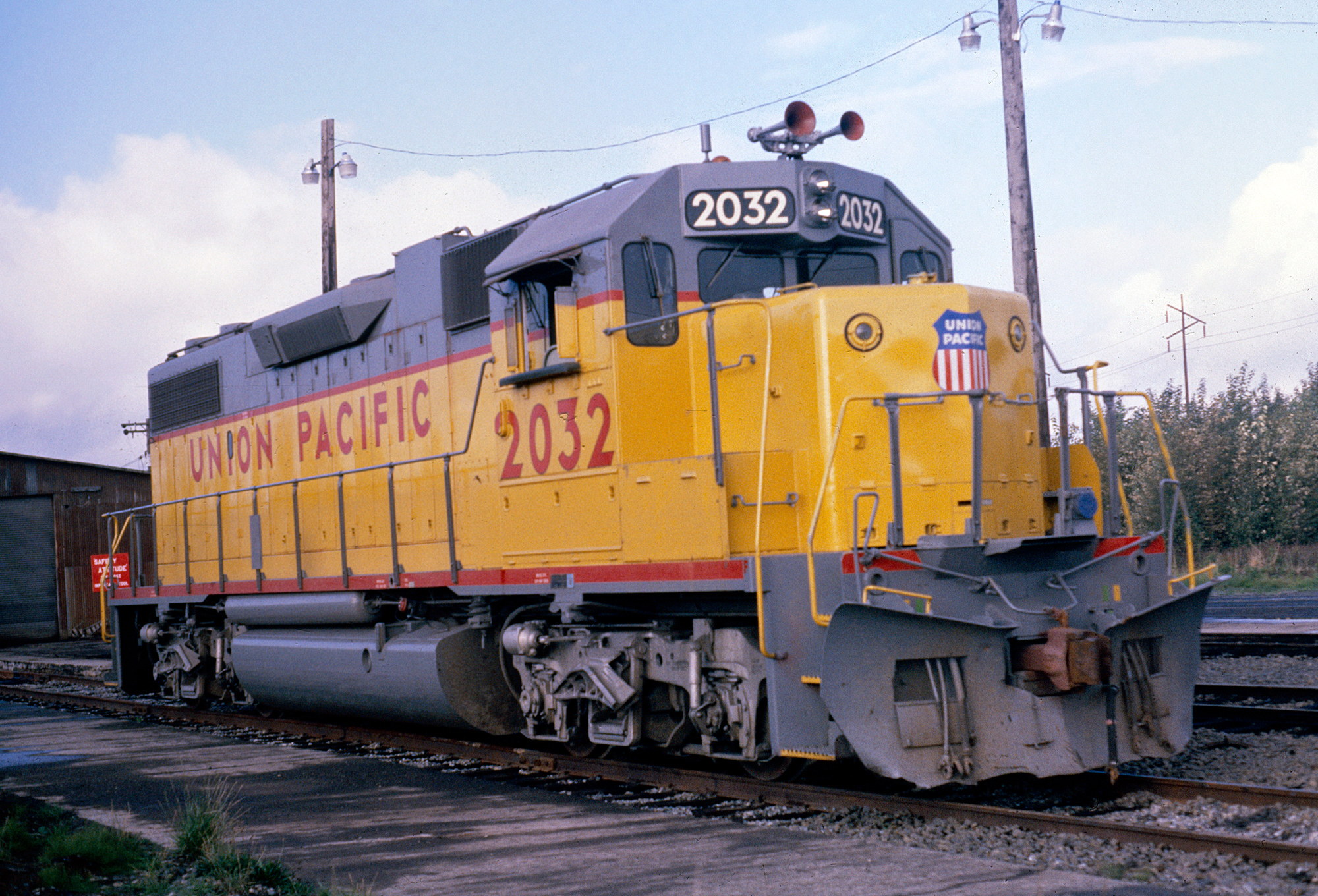 Union Pacific GP38-2 #2032 lays over at the small engine house in Longview, Washington during September of 1981. American-Rails.com collection.
Union Pacific GP38-2 #2032 lays over at the small engine house in Longview, Washington during September of 1981. American-Rails.com collection.Union Pacific survived the onslaught of traffic brought about by World War II. During that time it took delivery of 25 new 4-8-8-4's from the American Locomotive Company between 1941 and 1944.
Their nickname became "Big Boy" when an unknown Alco worked scrawled the name in chalk on one of the locomotive's smoke boxes during production. They were one of the most powerful steamers ever produced and began a trend of Union Pacific operating enormous locomotives.
Into the diesel era such variants included the U50 and U50C (General Electric), DDA40X "Centennial" and DD35/A (Electro-Motive), and the C855 (another Alco model). It also tested gas turbine locomotives during the 1960s, a joint project from Alco/GE named "GTELs" (Gas Turbine Electric Locomotive).
The whole point behind these monsters was an attempt at ways to reduce operating costs by either slicing down the number of locomotives required per train or operate longer trains. After the war UP realized passenger service was on the decline although remained strong enough into the 1950s that it continued purchasing or upgrading its fleet.
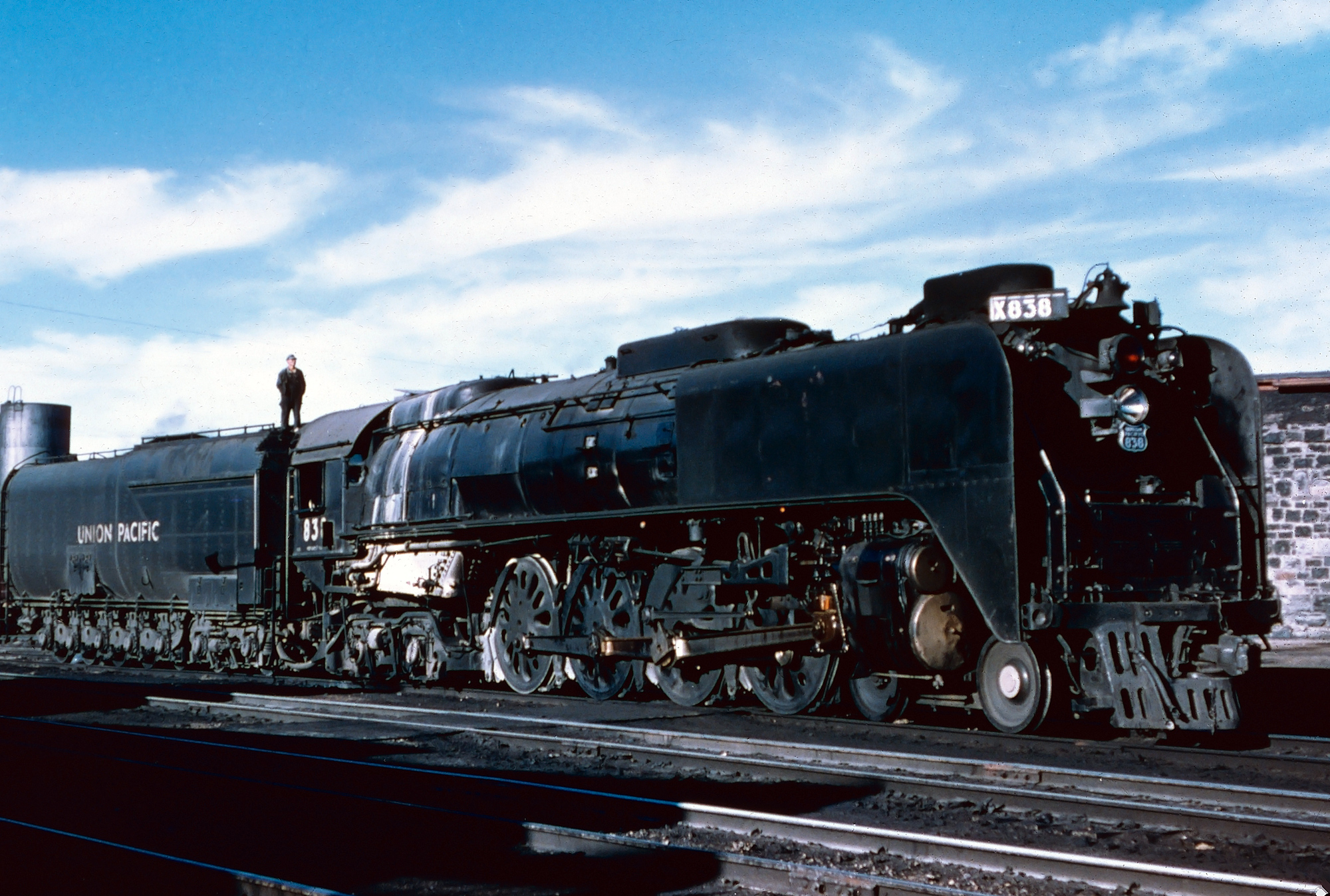 Union Pacific 4-8-4 #838, sporting the elephant ear smoke deflectors, is at the roundhouse in Laramie, Wyoming on September 2, 1955. John Shaw photo. American-Rails.com collection.
Union Pacific 4-8-4 #838, sporting the elephant ear smoke deflectors, is at the roundhouse in Laramie, Wyoming on September 2, 1955. John Shaw photo. American-Rails.com collection.Post World War II Period
The company continued the latter program into the 1960s, offering the public some of the best and most luxurious trains during a time when most other carriers were significantly cutting back their services. Its City trains were unmatched, used by Hollywood and other dignitaries for many years.
In the Chicago - California transcontinental market the only true competitor was the Santa Fe, which fielded its own fleet of highly-regarded streamliners. To maintain top-notch service, UP began systemically retrenching and combining its "Domeliners."
By September of 1969 the City of Denver, City of Kansas City, City of Portland, City of San Francisco, and City of Los Angeles (along with the Challenger) were all combined into one large train east of Green River, Wyoming.
While the move was a logical one (in 1946 the railroad reported nearly $65 million in passenger revenues, which was down to just $14.6 million by 1968), for those who followed the railroad they dubbed it the "City of Everywhere."
Finally, the government stepped in to form Amtrak in 1971, alleviating most carriers of the burden (today, you can still glimpse the City streamlines in Union Pacific's business train).
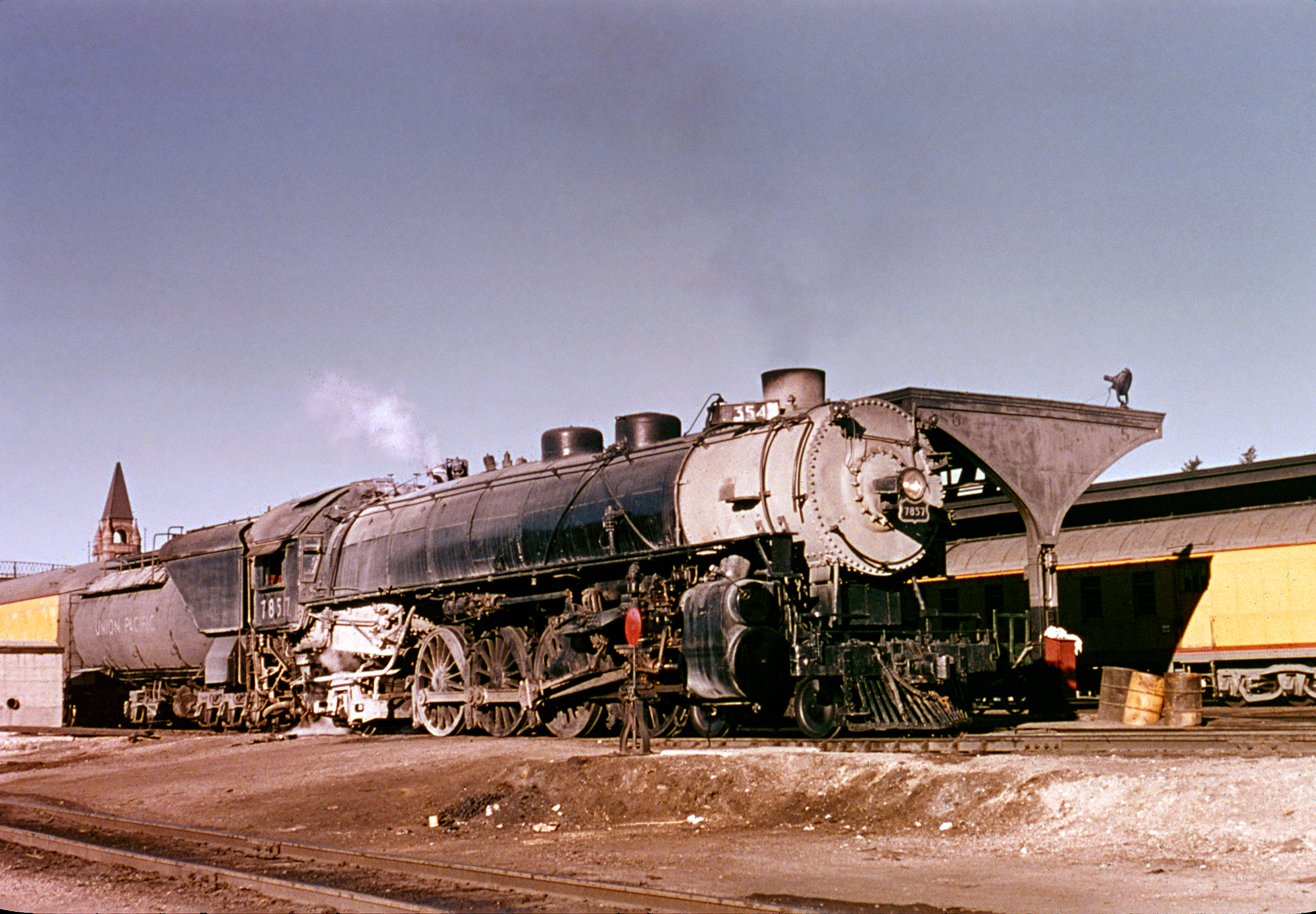 Union Pacific 4-8-2 #7857 (MT-1) awaits departure from Cheyenne, Wyoming with mixed train #354 (Cheyenne - Yoder) on October 15, 1955. Bob Collins photo. American-Rails.com collection.
Union Pacific 4-8-2 #7857 (MT-1) awaits departure from Cheyenne, Wyoming with mixed train #354 (Cheyenne - Yoder) on October 15, 1955. Bob Collins photo. American-Rails.com collection.Modern Era
The present-day Union Pacific system began taking shape in the 1960s. By then, UP understood that growth was the only way to remain one of the West's preeminent systems.
This was further realized when Northern Pacific; Great Northern; Chicago, Burlington & Quincy; and the Spokane, Portland & Seattle all merged in early 1970 to form the huge Burlington Northern system. In 1960 UP began the initial steps to merge with the Rock Island in an effort to provide it a direct link to Chicago.
However, protests from other carriers was fierce and the governing body, the Interstate Commerce Commission, took more than a decade to render its decision, announcing the union could proceed in 1974.
By then, the Rock was in such a dire financial condition that UP was no longer interested. The fabled Midwestern road was liquidated in 1980 and parts were purchased by surrounding carriers, which ironically included Union Pacific.
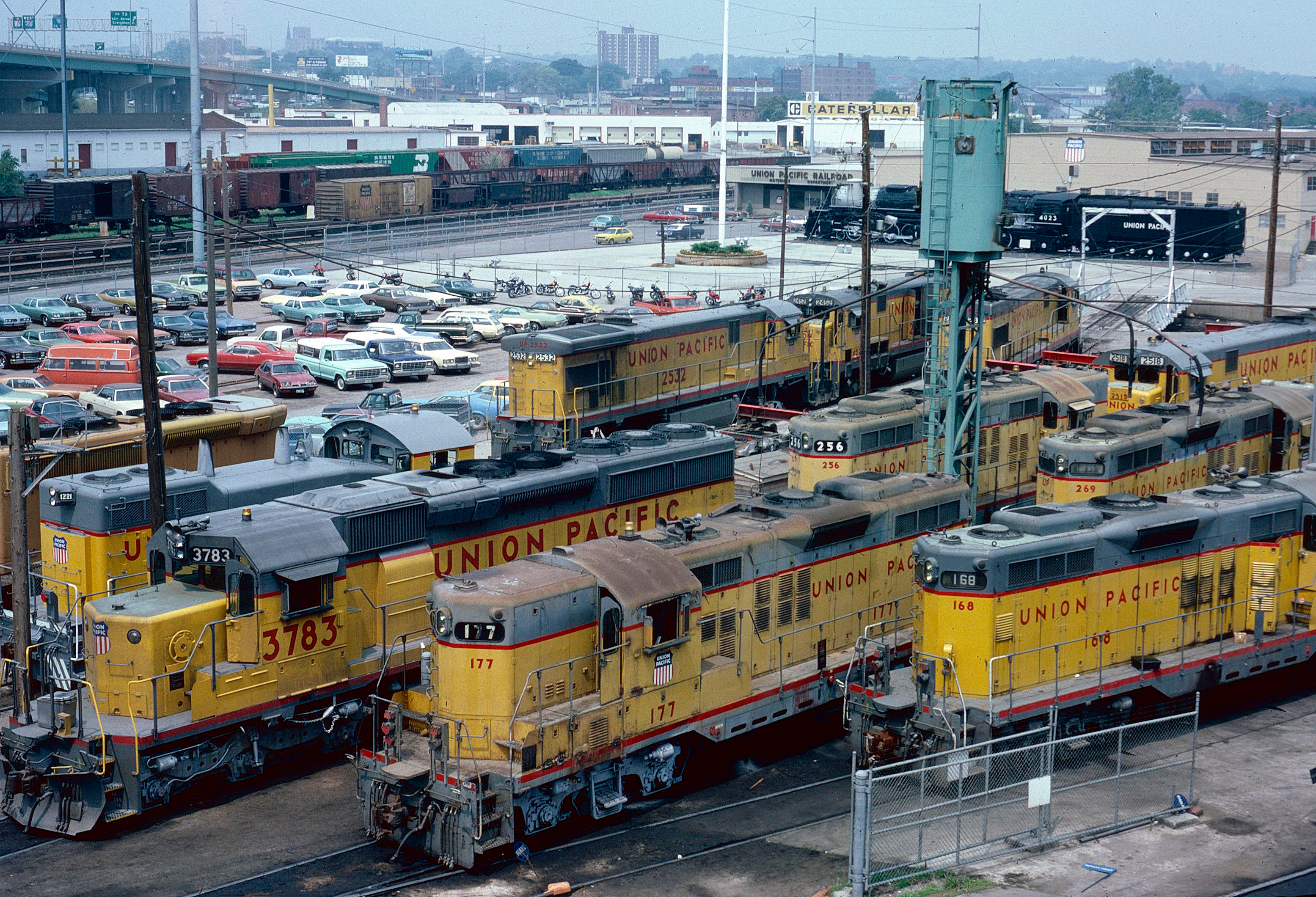 A look at Union Pacific's shops in Omaha, Nebraska during July of 1981. Note 4-8-8-4 "Big Boy" #4023 on display in the background. American-Rails.com collection.
A look at Union Pacific's shops in Omaha, Nebraska during July of 1981. Note 4-8-8-4 "Big Boy" #4023 on display in the background. American-Rails.com collection.In 1980 President Jimmy Carter signed the Staggers Act into law which greatly deregulated the railroad industry making it easier to set freight rates, abandon unprofitable lines, and carry out mergers.
Union Pacific subsequently acquired Missouri Pacific and the Western Pacific. In 1988 the company grew even larger when it purchased the Katy (the Missouri-Kansas-Texas Railroad) and in 1995 did the same with the Chicago & North Western, providing it access to Wyoming's Powder River Basin coal fields.
Passenger Trains
Butte Special: (Salt Lake City - Butte, Montana)
Challenger: (Chicago - Los Angeles)
City of Denver: (Chicago - Denver)
City of Los Angeles: (Chicago - Cheyenne - Los Angeles)
City of Portland: (Chicago - Cheyenne - Portland)
City of Salina: (Kansas City - Topeka - Salina, Kansas)
City of San Francisco: (Oakland - Cheyenne - Chicago)
City of St. Louis: (St. Louis - Los Angeles/San Francisco/Portland)
Columbine: (Omaha - Denver)
Forty-Niner: (Chicago - Oakland)
Gold Coast: (Chicago - Oakland/Los Angeles)
Idahoan: (Omaha - Portland)
Los Angeles Limited: (Chicago - Los Angeles)
Pony Express: (Kansas City - Los Angeles)
Portland Rose: (Denver - Portland)
San Francisco Overland: Connected Chicago and Oakland, later serving only as far east as St. Louis.
The Spokane: (Spokane - Portland)
Utahn: (Cheyenne - Los Angeles)
Yellowstone Special: (Poncatello, Idaho - West Yellowstone, Montana)
Notable Programs
"Commemorative"/Heritage Fleet
Finally, just a year later in 1996 it purchased the gigantic Southern Pacific, a one-time powerhouse that by then was a company far removed from its glory days, so much so that it had been purchased by the Denver & Rio Grande Western in 1988.
Today’s UP is much different from the system predating 1980 as it operates as far north as Seattle, as far west as Los Angeles/Long Beach, as far east as Minneapolis, and as far south as Dallas, Brownsville, and New Orleans (and about every west in between!).
Diesel Roster
American Locomotive Company
| Model Type | Road Number | Date Built | Quantity |
|---|---|---|---|
| C855 | 60-61, 60B | 1964 | 3 |
| PA-1 | 604-607, 994A-997A | 1947-1949 | 8 |
| PB-1 | 604B-607B, 998B-999B | 1947-1949 | 6 |
| RS27 | 675-676 | 1959 | 2 |
| S2 | 1036-1054, 1119-1153 | 1943-1945 | 54 |
| S4 | 1154-1198 | 1955-1956 | 45 |
| RSC2 | 1180-1189 | 1948 | 10 |
| RS2 | 1191-1195 | 1948-1949 | 5 |
| FA-1 | 1500A-1543A, 1626-1643 | 1947-1948 | 62 |
| FB-1 | 1524B-1541B, 1618B-1642B (Evens), 1618C-1642C (Evens) | 1947-1948 | 34 |
| C630 | 2900-2909 | 1966 | 10 |
The Baldwin Locomotive Works
| Model Type | Road Number | Date Built | Quantity |
|---|---|---|---|
| VO-1000 | 1055-1060 | 1943-1944 | 6 |
| DS-4-4-1000 | 1206-1210 | 1948 | 5 |
| AS616 | 1260-1265 | 1951-1952 | 6 |
Electro-Motive Corporation/Electro-Motive Division
| Model Type | Road Number | Date Built | Quantity |
|---|---|---|---|
| Streamliner Trainset | M10000-M10001, M10002A/B-M10006A/B | 1934, 1936 | 12 |
| E2A | LA1, SF1 | 1937 | 2 |
| E2B | LA2-LA3, SF2-SF3 | 1937 | 4 |
| E3A | LA5 | 1939 | 1 |
| E3B | LA6 | 1939 | 2 |
| E6A | 7M1A-9M1A, 7M2A-9M2A, LA4, SF4 | 1940-1941 | 8 |
| E6B | LA5-LA6, SF5-SF6 | 1941 | 4 |
| DD35A | 70-84 | 1965 | 15 |
| DD35 | 72B-98B | 1965 | 17 |
| GP9 | 130-248, 250-349 | 1954-1957 | 219 |
| GP9B | 130B-204B, 300B-349B | 1954 | 125 |
| SD24B | 400B-444B | 1959 | 45 |
| SD24 | 448 | 1958 | 1 |
| GP7 | 700-729 (First) | 1953 | 30 |
| GP20 | 700-729 (Second) | 1960 | 30 |
| GP30 | 700-735 (Third), 800-875 | 1961-1963 | 112 |
| GP30B | 700B-739B | 1963 | 40 |
| GP35 | 740-763 | 1963-1964 | 24 |
| SD7 | 775-784 | 1953 | 10 |
| E7A | 907A, 927A, 930A-931A, 959A-960A, 988 | 1946-1947 | 7 |
| E7B | 908B-909B, 928B-929B, 961B-963B | 1946 | 7 |
| E8A | 926-942 | 1950-1953 | 17 |
| E8B | 926B-949B | 1950-1953 | 24 |
| E9A | 900-914, 943-962 | 1954-1964 | 35 |
| E9B | 900B-904B, 910B-914B, 950B-974B | 1954-1963 | 30 |
| F3A | 905-910, 964A-968A, 1400A-1441A, 1442-1463, 1550-1563 | 1947-1949 | 87 |
| F3B | 905B-909B (Odds), 905C-909C (Odds), 969B-978B, 1430B-1458B (Evens), 1430C-1458C (Evens), 1442B-1471B, 1550B-1562B (Evens), 1550C-1562C (Evens) | 1947-1949 | 92 |
| F7B | 910B, 910C, 1466B-1474B (Evens), 1466C-1474C (Evens), 1476B-1496B, 1476C-1496C | 1951-1952 | 33 |
| FP7 | 911-912 | 1952 | 2 |
| NW2 | 1000-1095 | 1939-1948 | 96 |
| SDP35 | 1400-1409 | 1965 | 10 |
| F7A | 1467-1483 | 1951-1952 | 17 |
| SW7 | 1800-1824 | 1950 | 25 |
| SW9 | 1825-1866 | 1953 | 42 |
| TR5 | 1870A-1877A (Cow), 1870B-1877B (Calf) | 1951 | 16 |
| GP38-2 | 2000-2059 | 1974-1975 | 60 |
| SD40 | 3000-3024, 3048-3122 | 1966-1971 | 4 |
| SD40X | 3040-3047 | 1965 | 8 |
| SD40-2 | 3123-3304, 3335-3399, 3410-3583, 3609-3668, 3769-3804, 8035-8099 | 1972-1980 | 582 |
| SD45 | 3600-3649 | 1968 | 50 |
| SD40T-2 | 3805-3808 | 1980 | 4 |
| SD70M | 3779-3873, 3971-3973, 4000-4999, 5103-5231 | 2000-2004 | 1,227 |
| SD60 | 6000-6084 | 1986-1988 | 85 |
| SD60M | 6085-6365 | 1989-1992 | 281 |
| DDA40X | 6900-6946 | 1969-1971 | 47 |
| SD9043MAC | 8000-8308 | 1995-2000 | 309 |
| SD90MAC | 8160-8205, 8506-8561 | 1996-1999 | 92 |
| SD70ACe | 8309-8523, 8621-8670 | 2005-2008 | 265 |
| GP40X | 9000-9005 | 1977-1978 | 6 |
Fairbanks Morse
| Model Type | Road Number | Date Built | Quantity |
|---|---|---|---|
| H10-44 | DS1300-DS1304 | 1945-1947 | 5 |
| H15-44 | DS1325-DS1329 | 1948 | 5 |
| H16-44 | DS1340-DS1342 | 1950 | 3 |
| H20-44 | DS1360-DS1365, DS1367-DS1370 | 1947 | 10 |
| Erie Built (A) | 700-707 | 1945-1948 | 8 |
| Erie Built (B) | 700B, 702B-703B, 705B-706B | 1945-1948 | 5 |
General Electric
| Model Type | Road Number | Date Built | Quantity |
|---|---|---|---|
| 44-Tonner | DS1399 | 1947 | 1 |
| U50 | 31-53 | 1963-1965 | 23 |
| U25B | 625-640 | 1961-1962 | 16 |
| C30-7 | 2415-2539, 2960-2974 | 1978-1980 | 140 |
| U28C | 2800-2809 | 1966 | 10 |
| U30C | 2810-2959 | 1972-1976 | 150 |
| U50C | 5000-5039 | 1971 | 40 |
| ES44AC | 5248-5347, 5353-5553, 5695-5699, 7345-7469, 7600-7924 | 2005-2008 | 756 |
| AC4400CW | 5554-5694, 5700-6081, 6430-6699, 6738-6887, 6995-6999, 7080-7297, 9997-9999 | 1994-2004 | 1169 |
| AC6000CW | 7000-7009, 7510-7579, 7111 (Second) | 1995-2000 | 81 |
| AC6000CW (Rated At 4400 HP) | 7010-7079, 7300-7335 | 1996-1998 | 106 |
| C40-8 | 9100-9355 | 1988-1989 | 256 |
| C40-8W | 9356-9480 | 1990-1991 | 135 |
| C41-8W | 9481-9559 | 1993 | 79 |
| C44-9W | 9700-9739 | 1994 | 40 |
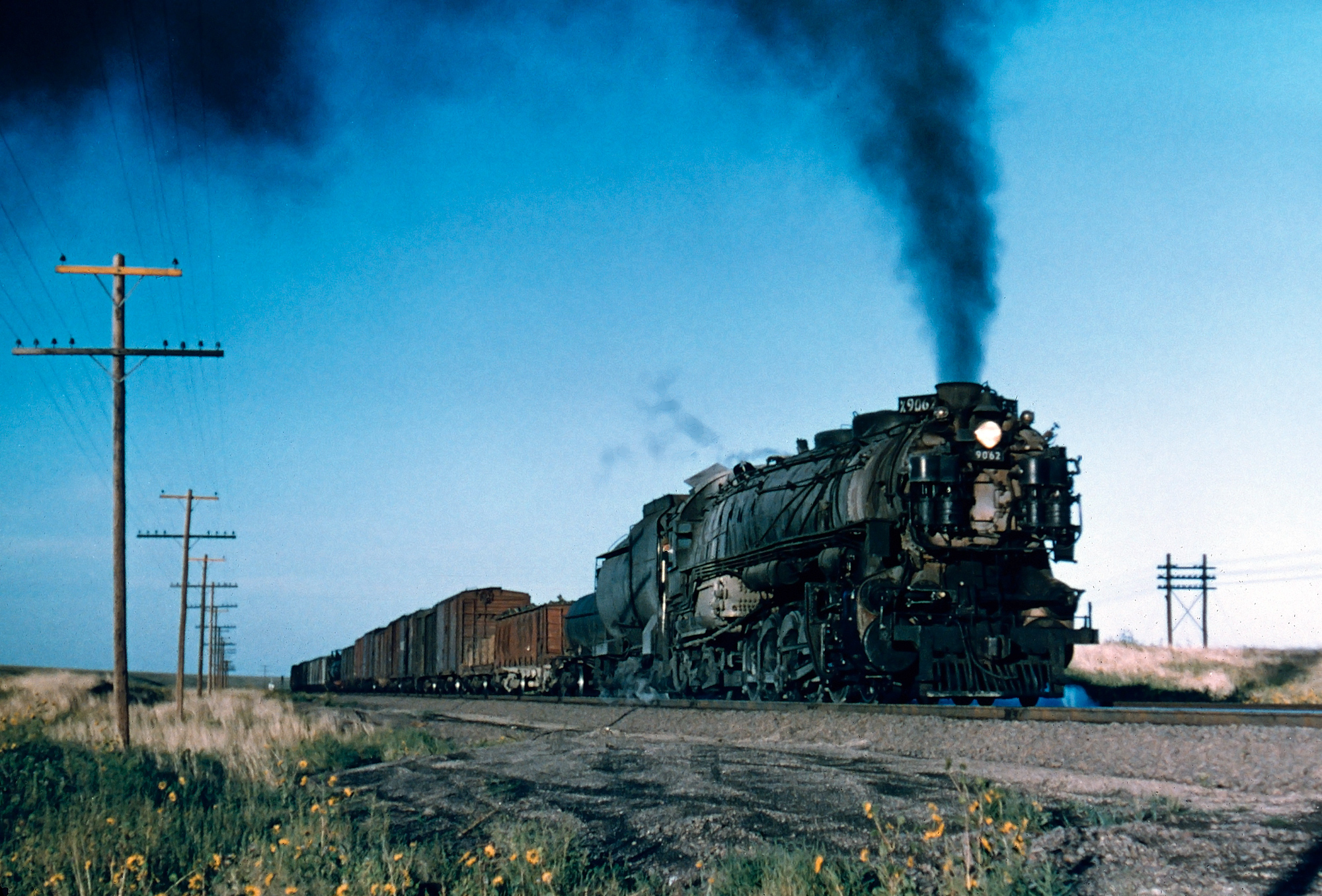 Union Pacific 4-12-2 #9062 leads Extra 9062 westbound west of Durham, Wyoming as the train nears Cheyenne, on August 31, 1955. John Shaw photo. American-Rails.com collection.
Union Pacific 4-12-2 #9062 leads Extra 9062 westbound west of Durham, Wyoming as the train nears Cheyenne, on August 31, 1955. John Shaw photo. American-Rails.com collection.Steam Roster
If you were a railfan in the 1950s, Union Pacific was a great place to catch everything from 2-8-0s on rural branch lines to powerful and legendary 4-8-8-4 "Big Boys" hustling expedited freights over Sherman Hill.
Throughout the 20th century, which is the focus of this steam roster, UP continually looked to larger and more powerful designs to handle trains more efficiently.
It also operated a large fleet of articulated designs to handle the mountain grades west of Cheyenne; aside from the Big Boys this included 4-6-6-4s, 2-8-8-0s, and 2-8-8-2s. It also maintained large fleets of 2-10-2s, 4-8-4s, and even the unique 4-12-2 for fast freight service.
Switchers
| Wheel Arrangement | Class | Road Number(s) | Subsidiary/Railroad | Quantity | Builder(s) | Completion Date | Retirement Date | Notes |
|---|---|---|---|---|---|---|---|---|
| 0-6-0 | S-56 | 4226 | Los Angeles & Salt Lake (LA&SL) | 1 | Lima | 1913 | 1945 | - |
| 0-6-0 | S-55 | 4227-4228 | LA&SL | 2 | Schenectady (Alco) | 1902 | 1925 | - |
| 0-6-0 | S-1 | 4229-4234 | LA&SL | 6 | Baldwin | 1904 | 1929-1947 | - |
| 0-6-0 | S-2 | 4235-4239 | LA&SL | 5 | Baldwin | 1907 | 1929-1947 | - |
| 0-6-0 | S-3 | 4240-4242 | LA&SL | 3 | Baldwin | 1913 | 1946-1947 | - |
| 0-6-0 | S-6 | 4243-4246 | LA&SL | 4 | Baldwin | 1921 | 1946-1956 | - |
| 0-6-0 | S-1 | 4350-4359 | UP | 10 | Baldwin | 1905 | 1929-1936 | - |
| 0-6-0 | S-2 | 4360-4379 | UP | 20 | Baldwin | 1906-1907 | 1927-1936 | - |
| 0-6-0 | S-2 | 4380 | UP | 1 | Brooks (Alco) | 1908 | 1929 | - |
| 0-6-0 | S-2 | 4381-4400 | UP | 20 | Baldwin | 1909, 1911 | 1927-1936 | - |
| 0-6-0 | S-51 | 4383-4347 | UP | 10 | Baldwin | 1901 | 1925-1928 | - |
| 0-6-0 | S-4 | 4401-4415 | UP | 15 | Baldwin | 1913 | 1933-1956 | - |
| 0-6-0 | S-4 | 4416-4420 | UP | 5 | Lima | 1914 | 1934-1958 | - |
| 0-6-0 | S-5 | 4421-4450 | UP | 30 | Baldwin | 1916 | 1947-1960 | - |
| 0-6-0 | S-6 | 4451-4480 | UP | 30 | Lima | 1920 | 1947-1956 | - |
| 0-6-0 | S-57 | 4500 | UP | 1 | UP | 1924 | 1946 | Rebuilt from a 2-8-0. |
| 0-6-0 | S-Spl | 4600-4609 | UP | 10 | Baldwin | 1918 | 1947-1956 | A USRA design. |
| 0-6-0 | S-51 | 4701, 4702 | OSL | 2 | Baldwin | 1901 | 1926 | - |
| 0-6-0 | S-2 | 4703-4709 | Oregon Short Line (OSL) | 7 | Brooks (Alco) | 1908 | 1928-1947 | - |
| 0-6-0 | S-2 | 4710-4721 | OSL | 12 | Baldwin | 1906 | 1928-1933 | - |
| 0-6-0 | S-51 | 4722-4724 | OSL | 3 | Baldwin | 1901 | 1928, 1930 | - |
| 0-6-0 | S-51 | 4725-4729 | OSL | 5 | Cooke (Alco) | 1901 | 1927-1930 | - |
| 0-6-0 | S-1 | 4730-4734 | OSL | 5 | Baldwin | 1904 | 1929-1946 | - |
| 0-6-0 | S-3 | 4735-4739 | OSL | 5 | Baldwin | 1912 | 1933-1947 | - |
| 0-6-0 | S-4 | 4740-4744 | OSL | 5 | Lima | 1914 | 1946-1947 | - |
| 0-6-0 | S-5 | 4748-4752 | OSL | 5 | Baldwin | 1918 | 1946-1954 | - |
| 0-6-0 | S-Spl | 4753-4757 | OSL | 5 | Pittsburgh (Alco) | 1919 | 1937-1955 | A USRA design. |
| 0-6-0 | S-1, S-2 | 4758-4764 | OSL | 7 | Baldwin | 1905-1907 | 1929 | Formerly lettered for UP. |
| 0-6-0 | S-51 | 4901 | Oregon-Washington Railroad & Navigation Company (OWR&N) | 1 | Pittsburgh (Alco) | 1902 | 1927 | ex-Pittsburgh & Lake Erie |
| 0-6-0 | S-2 | 4902-4922 | OWR&N | 21 | Baldwin | 1907-1913 | 1933-1955 | - |
| 0-6-0 | S-4 | 4923-4926 | OWR&N | 4 | Lima | 1914 | 1953, 1955 | - |
| 0-6-0 | S-1 | 4927-4930 | OWR&N | 4 | Baldwin | 1905 | 1931-1955 | - |
| 0-6-0 | S-51 | 4931-4933 | OWR&N | 3 | Baldwin | 1901-1903 | 1930, 1940 | - |
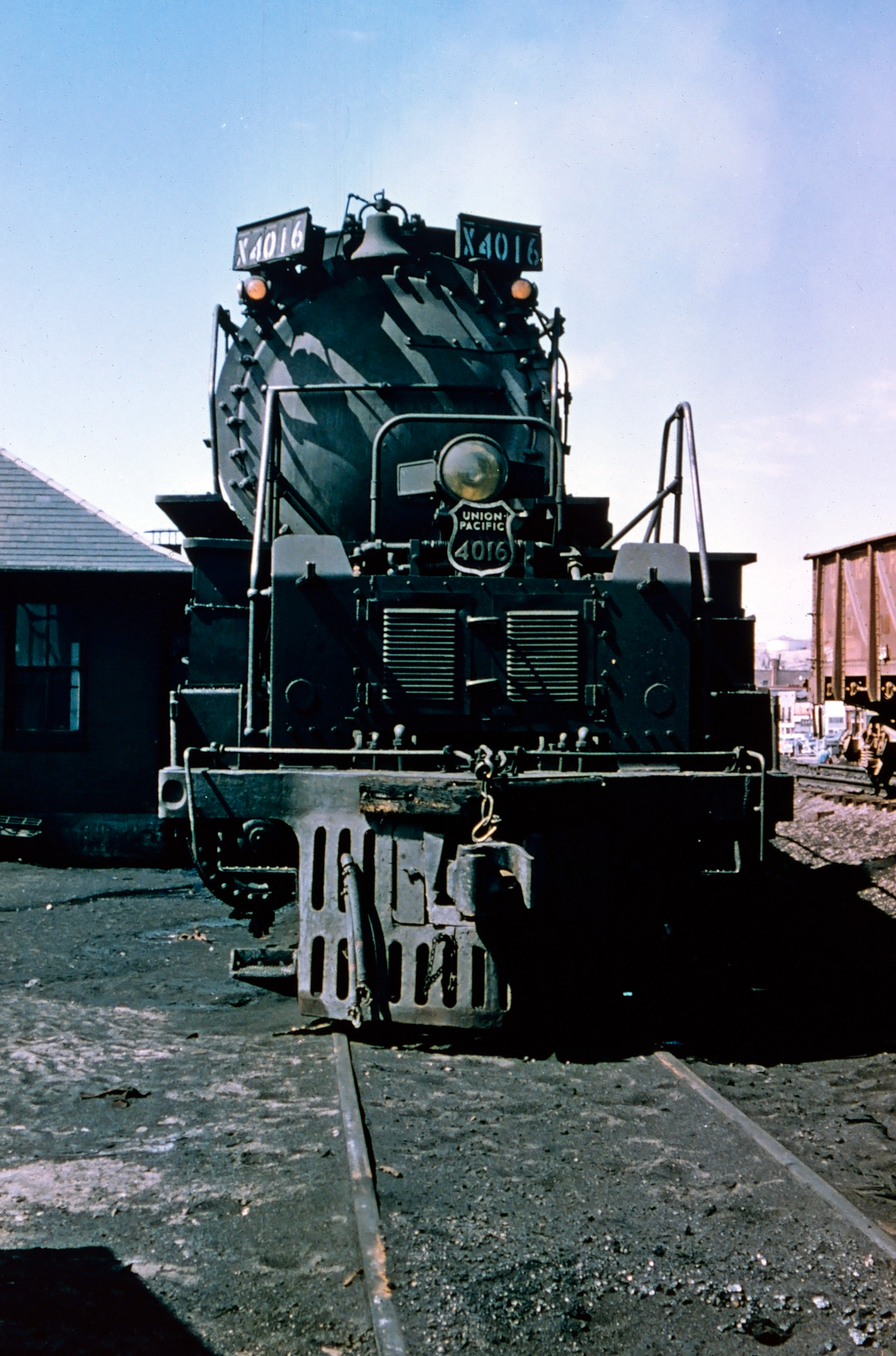 A head-end view of Union Pacific 4-8-8-4 "Big Boy" #4016 at Rawlins, Wyoming on September 3, 1956. John Shaw photo. American-Rails.com collection.
A head-end view of Union Pacific 4-8-8-4 "Big Boy" #4016 at Rawlins, Wyoming on September 3, 1956. John Shaw photo. American-Rails.com collection.Freight Locomotives
| Wheel Arrangement | Class | Road Number(s) | Subsidiary/Railroad | Quantity | Builder(s) | Completion Date | Retirement Date | Notes |
|---|---|---|---|---|---|---|---|---|
| Shay (65 Ton, 3 Truck) | 65-3 | 59 | LA&SL | 1 | Lima | 1902 | 1949 | Built as New East Tintic Railway #11. |
| Shay (32 Ton, 2 Truck) | 32-2 | 60 | LA&SL | 1 | Lima | 1896 | 1918 | Built as New East Tintic Railway #10. |
| Shay (80 Ton, 3 Truck) | 80-3 | 61 | LA&SL | 1 | Lima | 1907 | 1948 | - |
| 2-8-0 | C-57 | 150-158 | UP | 9 | Baldwin | 1902 | 1928-1946 | - |
| 2-8-0 | C-2 | 201-310 (not sequential) | UP | 110 | Baldwin | 1902 | 1933-1953 | A compound design. |
| 2-8-0 | C-2 | 311-331 | UP | 21 | Brooks (Alco) | 1908 | 1930-1957 | - |
| 2-8-0 | C-2 | 332-333 | UP | 2 | Baldwin | 1905 | 1957, 1937 | - |
| 2-8-0 | C-2 | 350-358 | UP | 9 | Baldwin | 1904 | 1933-1957 | ex-Southern Pacific |
| 2-8-0 | C-57 | 400-479 | UP | 80 | Baldwin | 1900-1901 | 1929-1958 | A Vauclain compound design. |
| 2-8-0 | C-57 | 480-499 | UP | 20 | Baldwin | 1903 | 1929-1958 | - |
| 2-8-0 | C-55 | 510-524 | OSL | 15 | Baldwin | 1901 | 1930-1956 | A Vauclain compound design. |
| 2-8-0 | C-57 | 525-539 | OSL | 15 | Baldwin | 1901-1903 | 1946-1958 | - |
| 2-8-0 | C-2 | 560-618 | OSL | 59 | Baldwin | 1904-1907 | 1933-1958 | - |
| 2-8-0 | C-2 | 619-622 | OSL | 4 | Brooks (Alco) | 1908 | 1947-1956 | - |
| 2-8-0 | C-51 | 705-706 | OWR&N | 2 | Schenectady (Alco) | 1909 | 1947, 1940 | Built as North Coast Railroad #1 and #2. |
| 2-8-0 | C-57 | 710-724 | OWR&N | 15 | Baldwin | 1901, 1903 | 1927-1947 | - |
| 2-8-0 | C-57 | 725-729 | OWR&N | 5 | Baldwin | 1902 | 1930-1940 | A compound design. |
| 2-8-0 | C-2 | 730-768 | OWR&N | 39 | Baldwin | 1906-1908 | 1930-1957 | - |
| 2-8-2 | MK-1 | 1900-1929 | UP | 30 | Baldwin | 1911 | 1947-1955 | - |
| 2-8-2 | MK-2 | 1930-1949 | UP | 20 | Baldwin | 1912 | 1947-1956 | - |
| 2-8-2 | MK-1 | 2000-2014 | OSL | 15 | Baldwin | 1911 | 1947-1955 | - |
| 2-8-2 | MK-2 | 2015-2034 | OSL | 20 | Baldwin | 1912 | 1947-1954 | - |
| 2-8-2 | MK-1 | 2100 | OWR&N | 1 | Baldwin | 1910 | 1955 | The original "Harriman Standard" Mikado design. |
| 2-8-2 | MK-1 | 2101-2140 | OWR&N | 40 | Baldwin | 1911 | 1946-1957 | - |
| 2-8-2 | MK-2 | 2141-2165 | OWR&N | 25 | Baldwin | 1912-1913 | 1947-1957 | - |
| 2-8-2 | MK-8 | 2166-2171 | OWR&N | 6 | Baldwin | 1918 | 1947-1957 | - |
| 2-8-2 | MK-3 | 2200-2290 (not sequential) | UP | 10 | Baldwin | 1911 | 1947-1956 | - |
| 2-8-2 | MK-4 | 2210-2219 | UP | 10 | Baldwin | 1912 | 1948-1955 | - |
| 2-8-2 | MK-5 | 2220-2244 | UP | 25 | Baldwin | 1913 | 1947-1958 | - |
| 2-8-2 | MK-6 | 2245-2259 | UP | 15 | Lima | 1914 | 1947-1957 | - |
| 2-8-2 | MK-7 | 2260-2279 | UP | 20 | Baldwin | 1917 | 1947-1958 | - |
| 2-8-2 | MK-8 | 2280-2294 | UP | 15 | Baldwin | 1918 | 1947-1956 | - |
| 2-8-2 | MK-9 | 2295-2310 | UP | 16 | Brooks (Alco) | 1918 | 1947-1959 | - |
| 2-8-2 | MK-8 | 2311-2320 | UP | 10 | Baldwin | 1918 | 1947-1956 | Formerly OSL #2525-2534. |
| 2-8-2 | MK-Spl | 2480-2499 | UP | 20 | Schenectady (Alco) | 1918 | 1953-1958 | A USRA design. |
| 2-8-2 | MK-5 | 2500-2514 | OSL | 15 | Baldwin | 1913 | 1947-1956 | - |
| 2-8-2 | MK-7 | 2515-2524 | OSL | 10 | Lima | 1917 | - | Later transferred to LA&SL. |
| 2-8-2 | MK-4 | 2515-2518 | OSL | 4 | Brooks (Alco) | 1912 | 1947-1956 | Formerly lettered UP #2214-2218. |
| 2-8-2 | MK-5 | 2519-2524 | OSL | 6 | Baldwin | 1913 | 1946-1958 | Formerly lettered UP #2220-2241 (not sequential). |
| 2-8-2 | MK-8 | 2525-2527 | OSL | 3 | Lima | 1914 | 1949-1954 | Formerly lettered UP #2246, #2254, and #2258. |
| 2-8-2 | MK-8 | 2525-2534 | OSL | 10 | Baldwin | 1918 | 1947-1956 | Later lettered UP #2311-2320. |
| 2-8-2 | MK-7 | 2528-2532 | OSL | 5 | Baldwin | 1917 | 1948-1956 | Formerly lettered UP #2266-2278 (not sequential). |
| 2-8-2 | MK-10 | 2555-2564 | OSL | 10 | Brooks (Alco) | 1921 | 1947-1959 | Formerly lettered LA&SL #2716-2727. |
| 2-8-2 | MK-6 | 2700-2707 | LA&SL | 8 | Schenectady (Alco) | 1914 | 1947-1956 | - |
| 2-8-2 | MK-6 | 2708 | LA&SL | 1 | Baldwin | 1914 | 1947 | - |
| 2-8-2 | MK-7 | 2709-2715 | LA&SL | 7 | Lima | 1917 | 1947-1957 | Formerly lettered OSL #2515-2524 (not sequential). |
| 2-8-2 | MK-10 | 2716-2725 | LA&SL | 10 | Brooks (Alco) | 1921 | 1947-1959 | Formerly lettered OSL #2555-2564. |
| 2-8-2 | MK-5 | 2726-2732 | LA&SL | 7 | Baldwin | 1913 | 1947-1957 | ex-OSL |
| 2-8-2 | MK-7 | 2733-2735 | LA&SL | 3 | Lima | 1917 | 1948-1958 | ex-OSL |
| 2-10-2 | TTT-2 | 3800-3805 | LA&SL | 6 | Baldwin | 1918 | 1952-1958 | Later lettered OSL #5300-5305. |
| 2-6-0 | M-62 | 4100-4107 | OSL | 8 | Baldwin | 1901 | 1925-1928 | - |
| 2-10-2 | TTT-1 | 5000-5009 | UP | 10 | Baldwin | 1917 | 1948-1955 | #5007 later transferred to LA&SL. |
| 2-10-2 | TTT-3 | 5010-5014 | UP | 5 | Baldwin | 1919 | 1958 | #5010-5013 later transferred to LA&SL. |
| 2-10-2 | TTT-4 | 5015-5039 | UP | 25 | Baldwin | 1920 | 1952-1957 | - |
| 2-10-2 | TTT-6 | 5040-5049 | UP | 10 | Brooks (Alco) | 1923 | 1952-1958 | - |
| 2-10-2 | TTT-6 | 5050-5052 | UP | 3 | Baldwin | 1923 | 1955 | - |
| 2-10-2 | TTT-6 | 5053-5089 | UP | 37 | Lima | 1923 | 1950-1958 | - |
| 2-10-2 | TTT-2 | 5300-5305 | OSL | 6 | Baldwin | 1918 | 1952-1958 | Formerly lettered LA&SL #3800-3805. |
| 2-10-2 | TTT-6 | 5306-5313 | OSL | 8 | Brooks (Alco) | 1923 | 1950-1958 | - |
| 2-10-2 | TTT-5 | 5314-5318 | OSL | 5 | Baldwin | 1923 | 1952-1958 | Formerly lettered OWR&N #5408-5409 and #5411-5413. |
| 2-10-2 | TTT-5 | 5400-5414 | OWR&N | 15 | Baldwin | 1922-1923 | 1954-1956 | #5408-5409 and #5411-5413 transferred to OSL. |
| 2-10-2 | TTT-6 | 5500-5514 | LA&SL | 25 | Baldwin | 1923 | 1949-1956 | - |
| 2-10-2 | TTT-7 | 5515-5524 | LA&SL | 25 | Baldwin | 1924 | 1949-1956 | - |
| 2-10-2 | TTT-1 | 5525-5529 | LA&SL | 5 | Baldwin | 1917, 1919 | 1954-1956 | Formerly lettered UP #5007 and #5010-5013. |
| 2-8-0 | C-1 | 6000-6008 | LA&SL | 9 | Baldwin | 1904 | 1933-1955 | - |
| 2-8-0 | C-2 | 6009-6060 | LA&SL | 52 | Baldwin | 1905, 1907 | 1928-1957 | - |
| 2-8-0 | C-2 | 6061-6086 | LA&SL | 16 | Schenectady (Alco), Brooks (Alco) | 1907 | 1928-1957 | - |
| 4-10-2 | FTT-1 | 8000 | UP | 1 | Brooks (Alco) | 1925 | - | Later lettered as LA&SL #8809. |
| 4-10-2 | FTT-2 | 8800-8808 | LA&SL | 9 | Brooks | 1926 | 1948-1954 | Renumbered 5091-5099. |
| 4-10-2 | FTT-1 | 8809 | LA&SL | 1 | Brooks (Alco) | 1925 | - | Renumbered 5090. |
| 4-12-2 | UP-1 | 9000 | UP | 1 | Brooks (Alco) | 1926 | 1956 | - |
| 4-12-2 | UP-2 | 9001-9014 | UP | 14 | Brooks (Alco) | 1926 | 1953-1956 | - |
| 4-12-2 | UP-3 | 9015-9029 | UP | 15 | Brooks (Alco) | 1928 | 1954-1956 | - |
| 4-12-2 | UP-4 | 9030-9054 | UP | 25 | Schenectady (Alco) | 1929 | 1953-1956 | - |
| 4-12-2 | UP-5 | 9078-9087 | UP | 10 | Schenectady (Alco) | 1930 | 1953-1955 | - |
| 4-12-2 | UP-5 | 9500-9514 | OSL | 15 | Schenectady (Alco) | 1930 | 1954-1956 | Formerly lettered UP #9063-9077. |
| 4-12-2 | UP-2 | 9700-9707 | OWR&N | 8 | Brooks (Alco) | 1928 | 1953-1956 | Relettered as UP #9055-9062. |
| 4-12-2 | UP-2 | 9708 | OWR&N | 1 | Brooks (Alco) | 1928 | - | Formerly lettered UP #9004. |
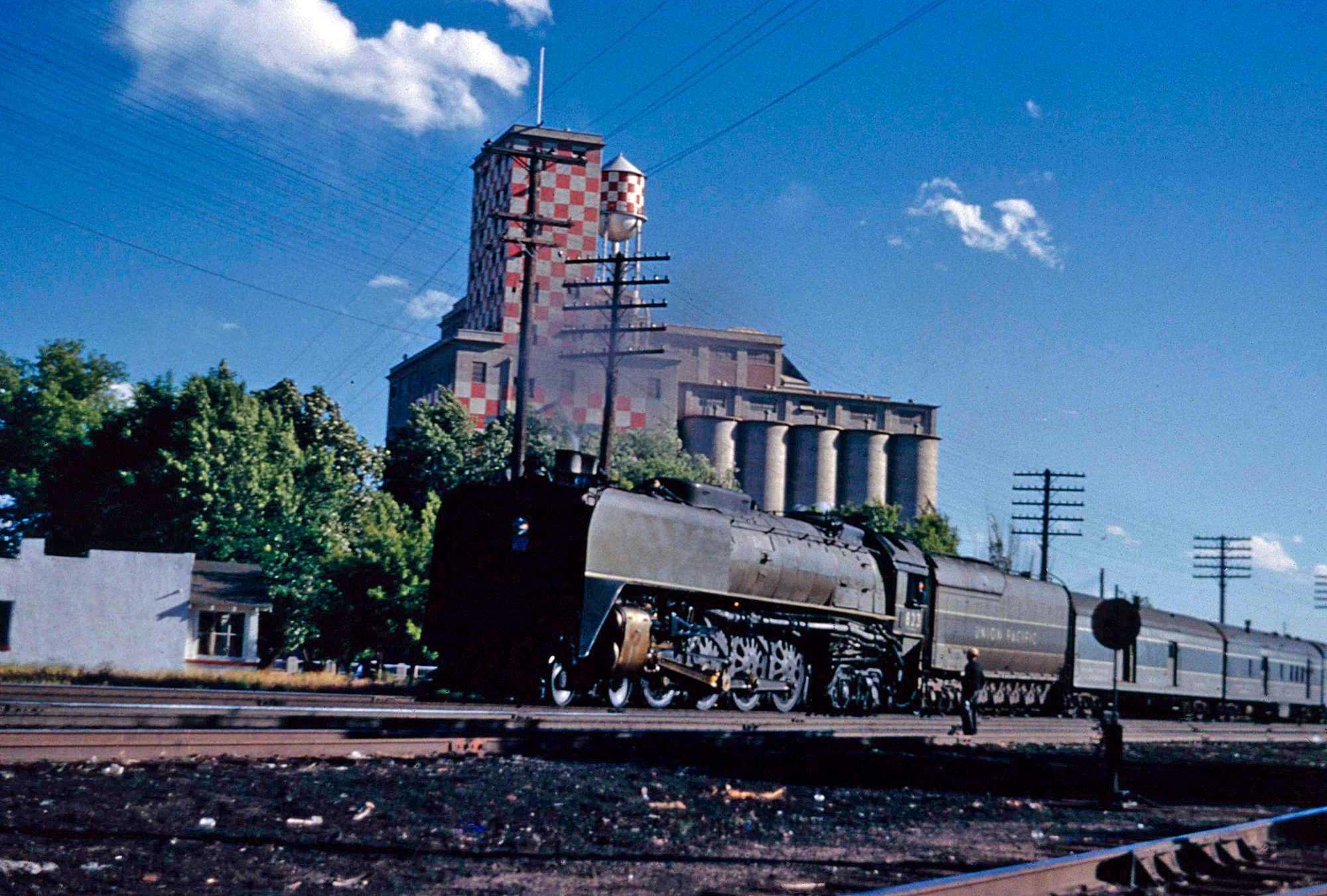 Union Pacific 4-8-4 #823 departs Denver, Colorado at 5 PM with train #86, the eastbound "National Parks Special" on July 3, 1950. The train is bound for Omaha, and then heads on to Chicago via the Chicago & North Western. American-Rails.com collection.
Union Pacific 4-8-4 #823 departs Denver, Colorado at 5 PM with train #86, the eastbound "National Parks Special" on July 3, 1950. The train is bound for Omaha, and then heads on to Chicago via the Chicago & North Western. American-Rails.com collection.Passenger Locomotives
| Wheel Arrangement | Class | Road Number(s) | Subsidiary/Railroad | Quantity | Builder(s) | Completion Date | Retirement Date | Notes |
|---|---|---|---|---|---|---|---|---|
| 4-8-4 | FEF-1 | 800-819 | UP | 20 | Alco | 1937 | 1954-1961 | - |
| 4-8-4 | FEF-2 | 820-834 | UP | 15 | Alco | 1939 | 1956-1962 | - |
| 4-8-4 | FEF-3 | 835-844 | UP | 10 | Alco | 1944 | 1957-1962 | - |
| 4-6-0 | T-69 | 1320-1329 | UP | 10 | Baldwin | 1900 | 1921-1936 | - |
| 4-6-0 | T-73 | 1330-1347 | UP | 18 | Baldwin | 1900-1901 | 1921-1932 | - |
| 4-6-0 | T-79 | 1348-1359 | UP | 12 | Baldwin | 1901 | 1921-1924 | - |
| 4-6-0 | T-63 | 1360-1369 | UP | 10 | Baldwin | 1902-1903 | 1927-1934 | - |
| 4-6-0 | T-54 | 1502 | OSL | 1 | Baldwin | 1907 | 1925 | Formerly Idaho Northern Railroad #101. |
| 4-6-0 | T-73 | 1562-1571 | OSL | 10 | Baldwin | 1902 | 1926, 1928 | - |
| 4-6-0 | T-2, T-3 | 1572-1583 | OSL | 12 | Baldwin | 1909, 1911 | 1933-1951 | - |
| 4-6-0 | T-57, T-61 | 1584-1587 | OSL | 4 | Baldwin | 1907, 1910 | 1946-1947 | ex-Pacific & Idaho Northern Railway. |
| 4-6-0 | T-68 | 1591-1596 | LA&SL | 6 | Brooks (Alco), Schenectady (Alco) | 1901 | 1925 | - |
| 4-6-0 | T-64 | 1727-1732 | OWR&N | 6 | Baldwin | 1901 | 1927-1948 | - |
| 4-6-0 | T-2, T-3 | 1742-1754 | OWR&N | 13 | Baldwin | 1909-1911 | 1933-1949 | - |
| 4-6-0 | T-1 | 1755-1760 | OWR&N | 6 | Brooks (Alco) | 1909 | 1940-1947 | - |
| 4-6-2 | P-1 thru P-6 | 2800-2859 | UP | 60 | Baldwin | 1904-1911 | 1927-1947 | |
| 4-6-2 | P-8, P-9 | 2860-2879 | UP | 20 | Brooks (Alco) | 1912-1913 | 1947-1954 | - |
| 4-6-2 | P-10 | 2880-2899 | UP | 20 | Lima | 1914 | 1947-1955 | - |
| 4-6-2 | P-13 | 2900-2909 | UP | 10 | Baldwin | 1920 | 1947-1954 | - |
| 4-6-2 | P-9, P-10 | 2910-2911 | UP | 2 | Brooks (Alco), Lima | 1913, 1914 | 1953 | Formerly lettered OSL #3124 and #3130. |
| 4-6-2 | P-3 | 3100-3113 | OSL | 14 | Baldwin | 1906, 1911 | 1933-1947 | - |
| 4-6-2 | P-8 | 3114-3123 | OSL | 10 | Schenectady (Alco) | 1912 | 1947-1953 | - |
| 4-6-2 | P-9 | 3124-3128 | OSL | 5 | Brooks (Alco) | 1913 | 1947 | - |
| 4-6-2 | P-10 | 3129-3133 | OSL | 5 | Lima | 1914 | 1947, 1952 | - |
| 4-6-2 | P-11 | 3134-3138 | OSL | 5 | Baldwin | 1919 | 1954-1955 | - |
| 4-6-2 | P-1 | 3150-3170 | LA&SL | 21 | Baldwin | 1904 | 1926-1954 | - |
| 4-6-2 | P-4 | 3171-3175 | LA&SL | 5 | Baldwin | 1907 | 1928-1933 | - |
| 4-6-2 | P-8 | 3176-3181 | LA&SL | 6 | Schenectady (Alco) | 1912 | 1947-1949 | - |
| 4-6-2 | P-2 | 3200-3203 | OWR&N | 4 | Baldwin | 1905 | 1936-1958 | - |
| 4-6-2 | P-1 | 3204-3207 | OWR&N | 4 | Schenectady (Alco) | 1904 | 1933-1955 | - |
| 4-6-2 | P-3 | 3208-3210 | OWR&N | 3 | Baldwin | 1906 | 1936-1948 | - |
| 4-6-2 | P-6 | 3211-3217 | OWR&N | 7 | Baldwin | 1911 | 1933-1954 | - |
| 4-6-2 | P-7 | 3218-3219 | OWR&N | 2 | Baldwin | 1911 | 1947, 1955 | - |
| 4-6-2 | P-9 | 3220-3225 | OWR&N | 6 | Brooks (Alco) | 1913 | 1947-1955 | - |
| 4-6-2 | P-12 | 3226-3227 | OWR&N | 2 | Baldwin | 1919 | 1954 | - |
| 4-4-0 | E-62 | 1008 | OSL | 1 | Baldwin | 1909 | 1923 | Former Idaho Northern Railroad #200. |
| 4-4-0 | E-70 | 1050 | LA&SL | 1 | Schenectady | 1901 | 1925 | Formerly Los Angeles Terminal #8. |
| 4-4-2 | A-2 | 3300-3319 | UP | 20 | Baldwin | 1904, 1906 | 1923, 1925 | - |
| 4-4-2 | A-3 | 3320-3334 | UP | 15 | Baldwin | 1906 | 1921, 1923 | A compound design. |
| 4-4-2 | A-1 | 3376-3379 | LA&SL | 4 | Schenectady (Alco) | 1903 | 1921 | Renumbered from 3100-3103. |
| 4-4-2 | A-2 | 3400-3407 | OSL | 8 | Baldwin | 1904 | 1925-1930 | - |
| 4-4-2 | A-2 | 3408-3411 | OSL | 4 | Brooks | 1908 | 1928-1929 | - |
| 4-4-2 | A-4 | 3500-3514 | OWR&N | 15 | Baldwin | 1911 | 1928-1933 | - |
| 4-8-2 | MT-1 | 7000-7039 | UP | 40 | Brooks | 1922 | 1949-1956 | - |
| 4-8-2 | MT-1 | 7850-7864 | LA&SL | 15 | Brooks (Alco) | 1923 | 1950-1956 | - |
| 4-8-2 | MT-2 | 7865-7869 | UP | 5 | Brooks (Alco) | 1924 | 1953-1956 | - |
Articulated Designs
| Wheel Arrangement | Class | Road Number(s) | Subsidiary/Railroad | Quantity | Builder(s) | Completion Date | Retirement Date | Notes |
|---|---|---|---|---|---|---|---|---|
| 2-8-8-2 | SA-57 | 3570-3599 | UP | 30 | Schenectady (Alco), Baldwin | 1924, 1926 | 1947 | ex-Chesapeake & Ohio |
| 2-8-8-2 | MC-1 | 3600-3602 | UP | 3 | Baldwin | 1909 | 1928 | Relettered to OSL #3700-3702. |
| 2-8-8-0 | MC-2 | 3600-3614 | UP | 15 | Schenectady (Alco) | 1918 | 1947-1954 | Renumbered to 3500-3514. |
| 2-8-8-0 | MC-3 | 3615-3633 | UP | 19 | Brooks (Alco) | 1920 | 1947-1954 | Renumbered to 3515-3533. |
| 2-8-8-0 | MC-4 | 3634-3638 | UP | 5 | Brooks (Alco) | 1923 | 1949-1954 | Renumbered to 3534-3538. |
| 2-8-8-0 | MC-5 | 3639-3643 | UP | 5 | Brooks (Alco) | 1923 | 1952, 1954 | Renumbered to 3539-3543. |
| 2-8-8-0 | MC-6 | 3645-3664 | UP | 20 | Brooks (Alco) | 1924 | 1947-1954 | Renumbered to 3545-3564. |
| 2-8-8-2 | MC-57 | 3670-3674 | UP | 5 | Schenectady (Alco) | 1919 | 1947 | ex-Norfolk & Western |
| 2-8-8-2 | MC-1 | 3700-3702 | OSL | 3 | Baldwin | 1909 | 1928 | Formerly lettered UP #2000-2002. |
| 2-8-8-0 | MC-2 | 3703 | OSL | 1 | Schenectady (Alco) | 1918 | 1924 | First renubmered 3644, then later as #3544. |
| 2-8-8-0 | MC-4 | 3704-3705 | OSL | 2 | Brooks (Alco) | 1923 | 1944 | Renumbered 3565-3566. |
| 2-8-8-2 | MC-1 | 3800-3802 | OWR&N | 3 | Baldwin | 1910 | 1928 | - |
| 2-8-8-0 | MC-4 | 3803-3805 | OWR&N | 3 | Brooks (Alco) | 1923 | 1944 | Renumbered 3567-3569. |
| 4-6-6-4 | CSA-1 | 3900-3914 | UP | 15 | Alco | 1936 | 1956-1962 | Renumbered 3800-3814. |
| 4-6-6-4 | CSA-2 | 3915-3939 | UP | 25 | Alco | 1937 | 1956-1961 | Renumbered to 3815-3839. |
| 4-6-6-4 | 4664-5 | 3930-3949 | UP | 20 | Alco | 1944 | 1952-1960 | - |
| 4-6-6-4 | 4664-3 | 3950-3969 | UP | 20 | Alco | 1942 | 1958-1961 | - |
| 4-6-6-4 | 4664-4 | 3975-3999 | UP | 25 | Alco | 1943 | 1959-1961 | 3975-3984 renumbered to 3708-3717 |
| 4-8-8-4 | 4884-1 | 4000-4019 | UP | 20 | Alco | 1941 | 1961-1962 | - |
| 4-8-8-4 | 4884-2 | 4020-4024 | UP | 5 | Alco | 1944 | 1962 | - |
Today
According to Union Pacific, as of 2018 the company boasts the following credentials; 32,100 route miles, 44,500 employees, and an annual revenue of $22.832 billion.
For the general public UP operates the aforementioned business train and several historic steam locomotives including the never retired 4-8-4 #844, 4-6-6-4 #3985, and the recently acquired 4-8-8-4 "Big Boy" #4014.
The latter is of particular note; when Union Pacific officially announced its intentions to restore this steamer on July 23, 2013 the railfan community was shocked and the news made headlines in the media. The move from its longtime resting place in Pomona, California has also been widely watched and documented.
Few ever thought it possible to see a Big Boy under steam again given their incredible size and the expense to do so. On May 2, 2019, after three years of restoration, the big locomotive made its initial test run from Cheyenne to Greeley, Colorado.
It went on an incredibly successful PR campaign throughout the 2019 season that saw more than 1 million folks come out to see the big locomotive.
Timetables (October, 1958)
Contents
Recent Articles
-
New York - Murder Mystery - Dinner Train Rides
Dec 13, 25 10:30 AM
New York State, renowned for its vibrant cities and verdant countryside, offers a plethora of activities for locals and tourists alike, including murder mystery train rides! -
Pennsylvania - Murder Mystery - Dinner Train Rides
Dec 13, 25 10:25 AM
Pennsylvania, steeped in history and industrial heritage, offers a prime setting for a unique blend of dining and drama: the murder mystery dinner train ride. -
Ohio - Murder Mystery - Dinner Train Rides
Dec 13, 25 10:14 AM
The murder mystery dinner train rides in Ohio provide an immersive experience that combines fine dining, an engaging narrative, and the beauty of Ohio's landscapes.

